Illustrations by Shigeru Hatsuyama for Thumbelina (and other tales) (Japan, 1925)![]() "The Daisy"
All scans via the National Diet Library. Not all of these illustrations are for the story "Thumbelina" but I matched the post title to the book title.
Bio of Shigeru Hatsuyama (sometimes "Hatuyama," 初山滋) (1897-1973) from Kodomo No Kuni:Hatsuyama was born in Asakusa, Tokyo in 1897. In 1906 he studied yamato-e painting for three months under Araki Tanrei, a Kano-school painter in Yanaka (Tokyo), and in 1907 he painted kimono patterns at a workshop in Kanda-Imagawabashi. He studied the style of painter Ogata Korin (1658-1716). In 1911 he became a disciple of Ikawa Sengai, a Japanese-style painter known for his bijinga (images of beautiful women). In 1919, following the founding of the children's magazine Otogi no sekai [Fairy World] (Bunkodo), Hatsuyama did the illustrations for its cover from the inaugural to the very last issue which came out in October 1923.
There's also a longer bio at The Lavenberg Collection of Japanese Prints.
This post is a birthday present to myself. I will stare at it all day.
"The Daisy"
All scans via the National Diet Library. Not all of these illustrations are for the story "Thumbelina" but I matched the post title to the book title.
Bio of Shigeru Hatsuyama (sometimes "Hatuyama," 初山滋) (1897-1973) from Kodomo No Kuni:Hatsuyama was born in Asakusa, Tokyo in 1897. In 1906 he studied yamato-e painting for three months under Araki Tanrei, a Kano-school painter in Yanaka (Tokyo), and in 1907 he painted kimono patterns at a workshop in Kanda-Imagawabashi. He studied the style of painter Ogata Korin (1658-1716). In 1911 he became a disciple of Ikawa Sengai, a Japanese-style painter known for his bijinga (images of beautiful women). In 1919, following the founding of the children's magazine Otogi no sekai [Fairy World] (Bunkodo), Hatsuyama did the illustrations for its cover from the inaugural to the very last issue which came out in October 1923.
There's also a longer bio at The Lavenberg Collection of Japanese Prints.
This post is a birthday present to myself. I will stare at it all day.
![]() "The Steadfast Tin Soldier"
"The Steadfast Tin Soldier"![]() "The Ugly Duckling"
"The Ugly Duckling"![]() "Thumbelina"
"Thumbelina"![]() "The Daisy"
"The Daisy"![]() "The Daisy"
"The Daisy"![]() "Thumbelina"
"Thumbelina"![]() "Thumbelina"
"Thumbelina"![]() "The Angel"
"The Angel"![]() "The Little Match Girl"
"The Little Match Girl"![]() "The Ugly Duckling"
"The Ugly Duckling"![]() "The Steadfast Tin Soldier"
"The Steadfast Tin Soldier"![]() "The Flying Trunk"
"The Flying Trunk"![]() "The Fir-Tree"
"The Fir-Tree"![]() "The Angel"
"The Angel"![]() "The Angel"
"The Angel"![]() detail
detail![]() "The Flying Trunk"
"The Flying Trunk"![]() endpapers
endpapers![]() title page spread
title page spread![]() cover
cover![]() detail
If you like this post, don't miss the "Takeo Takei" filter.
Previous posts on Japan
detail
If you like this post, don't miss the "Takeo Takei" filter.
Previous posts on Japan
 "The Daisy"
All scans via the National Diet Library. Not all of these illustrations are for the story "Thumbelina" but I matched the post title to the book title.
Bio of Shigeru Hatsuyama (sometimes "Hatuyama," 初山滋) (1897-1973) from Kodomo No Kuni:Hatsuyama was born in Asakusa, Tokyo in 1897. In 1906 he studied yamato-e painting for three months under Araki Tanrei, a Kano-school painter in Yanaka (Tokyo), and in 1907 he painted kimono patterns at a workshop in Kanda-Imagawabashi. He studied the style of painter Ogata Korin (1658-1716). In 1911 he became a disciple of Ikawa Sengai, a Japanese-style painter known for his bijinga (images of beautiful women). In 1919, following the founding of the children's magazine Otogi no sekai [Fairy World] (Bunkodo), Hatsuyama did the illustrations for its cover from the inaugural to the very last issue which came out in October 1923.
There's also a longer bio at The Lavenberg Collection of Japanese Prints.
This post is a birthday present to myself. I will stare at it all day.
"The Daisy"
All scans via the National Diet Library. Not all of these illustrations are for the story "Thumbelina" but I matched the post title to the book title.
Bio of Shigeru Hatsuyama (sometimes "Hatuyama," 初山滋) (1897-1973) from Kodomo No Kuni:Hatsuyama was born in Asakusa, Tokyo in 1897. In 1906 he studied yamato-e painting for three months under Araki Tanrei, a Kano-school painter in Yanaka (Tokyo), and in 1907 he painted kimono patterns at a workshop in Kanda-Imagawabashi. He studied the style of painter Ogata Korin (1658-1716). In 1911 he became a disciple of Ikawa Sengai, a Japanese-style painter known for his bijinga (images of beautiful women). In 1919, following the founding of the children's magazine Otogi no sekai [Fairy World] (Bunkodo), Hatsuyama did the illustrations for its cover from the inaugural to the very last issue which came out in October 1923.
There's also a longer bio at The Lavenberg Collection of Japanese Prints.
This post is a birthday present to myself. I will stare at it all day.
 "The Steadfast Tin Soldier"
"The Steadfast Tin Soldier" "The Ugly Duckling"
"The Ugly Duckling" "Thumbelina"
"Thumbelina" "The Daisy"
"The Daisy" "The Daisy"
"The Daisy" "Thumbelina"
"Thumbelina" "Thumbelina"
"Thumbelina" "The Angel"
"The Angel" "The Little Match Girl"
"The Little Match Girl" "The Ugly Duckling"
"The Ugly Duckling" "The Steadfast Tin Soldier"
"The Steadfast Tin Soldier" "The Flying Trunk"
"The Flying Trunk" "The Fir-Tree"
"The Fir-Tree" "The Angel"
"The Angel" "The Angel"
"The Angel" detail
detail "The Flying Trunk"
"The Flying Trunk" endpapers
endpapers title page spread
title page spread cover
cover detail
If you like this post, don't miss the "Takeo Takei" filter.
Previous posts on Japan
detail
If you like this post, don't miss the "Takeo Takei" filter.
Previous posts on Japan
 1970, En man från Danmark, cover by Svenolov Ehrén
From the collection of Book Cover Lover
The Swedish design and illustration blog Book Cover Lover is still going strong. I've pulled some more favorites for this sequel to my September 2011 post. Here's what I said then: Martin Klasch turned me on to the Swedish blog Book Cover Lover. . . Started in May [2011], there are already 224 posts to scroll through, the majority of them focusing on Swedish mid-century book covers and bindings from the blogger's own collection.
You may recognize designers from my previous posts Cocktaildags and Lord of the Flugornas. Unfortunately the binding designers are unknown, as publishers rarely print credits for the binding.
1970, En man från Danmark, cover by Svenolov Ehrén
From the collection of Book Cover Lover
The Swedish design and illustration blog Book Cover Lover is still going strong. I've pulled some more favorites for this sequel to my September 2011 post. Here's what I said then: Martin Klasch turned me on to the Swedish blog Book Cover Lover. . . Started in May [2011], there are already 224 posts to scroll through, the majority of them focusing on Swedish mid-century book covers and bindings from the blogger's own collection.
You may recognize designers from my previous posts Cocktaildags and Lord of the Flugornas. Unfortunately the binding designers are unknown, as publishers rarely print credits for the binding.
 1961, The Martian Chronicles
From the collection of Book Cover Lover
1961, The Martian Chronicles
From the collection of Book Cover Lover 1961, The Martian Chronicles, cover by Karl-Erik Forsberg
From the collection of Book Cover Lover
1961, The Martian Chronicles, cover by Karl-Erik Forsberg
From the collection of Book Cover Lover 1958, The Sling and the Arrow
From the collection of Book Cover Lover
1958, The Sling and the Arrow
From the collection of Book Cover Lover 1965, Jag minns min blåa Donau, cover by Bo Lassen
From the collection of Book Cover Lover
1965, Jag minns min blåa Donau, cover by Bo Lassen
From the collection of Book Cover Lover
 1957, cover: Per Silfverhjelm, illustrator: Staffan Brunius
From the collection of Book Cover Lover
1957, cover: Per Silfverhjelm, illustrator: Staffan Brunius
From the collection of Book Cover Lover 1960, Österhus brinner, cover by Gunnar Brusewitz
From the collection of Book Cover Lover
1960, Österhus brinner, cover by Gunnar Brusewitz
From the collection of Book Cover Lover
 1959, Tiburon, cover by Gunnar Brusewitz
From the collection of Book Cover Lover
1959, Tiburon, cover by Gunnar Brusewitz
From the collection of Book Cover Lover 1958, Weep for a Wanton
From the collection of Book Cover Lover
1958, Weep for a Wanton
From the collection of Book Cover Lover 1956, From och Hård, vignette by Ylva Källström-Eklund
From the collection of Book Cover Lover
1956, From och Hård, vignette by Ylva Källström-Eklund
From the collection of Book Cover Lover
 1958, The Hangman's Tree
From the collection of Book Cover Lover
1958, The Hangman's Tree
From the collection of Book Cover Lover 1964, De tre små mästarna, cover by Rolf Lagerson
From the collection of Book Cover Lover
1964, De tre små mästarna, cover by Rolf Lagerson
From the collection of Book Cover Lover
 1968, Nunnan av Monza, cover by Rolf Lagerson
From the collection of Book Cover Lover
1968, Nunnan av Monza, cover by Rolf Lagerson
From the collection of Book Cover Lover 1967, The Three Friends, cover by Rolf Lagerson
From the collection of Book Cover Lover
1967, The Three Friends, cover by Rolf Lagerson
From the collection of Book Cover Lover 1960, Vedergällningens vägar, cover by Pär Gunnar Thelander
From the collection of Book Cover Lover
1960, Vedergällningens vägar, cover by Pär Gunnar Thelander
From the collection of Book Cover Lover
 1960, Spelboken, cover by Rolf Lagerson
From the collection of Book Cover Lover
1960, Spelboken, cover by Rolf Lagerson
From the collection of Book Cover Lover 1971, Roseanna, cover by Svenolov Ehren
From the collection of Book Cover Lover
1971, Roseanna, cover by Svenolov Ehren
From the collection of Book Cover Lover 1969, The Devil in Velvet, cover by Monica Schultz
From the collection of Book Cover Lover
1969, The Devil in Velvet, cover by Monica Schultz
From the collection of Book Cover Lover 1969, Sjöjungfrun, cover by Monica Schultz
From the collection of Book Cover Lover
1969, Sjöjungfrun, cover by Monica Schultz
From the collection of Book Cover Lover
 From the collection of Book Cover Lover
See all book cover posts on 50 Watts
From the collection of Book Cover Lover
See all book cover posts on 50 Watts
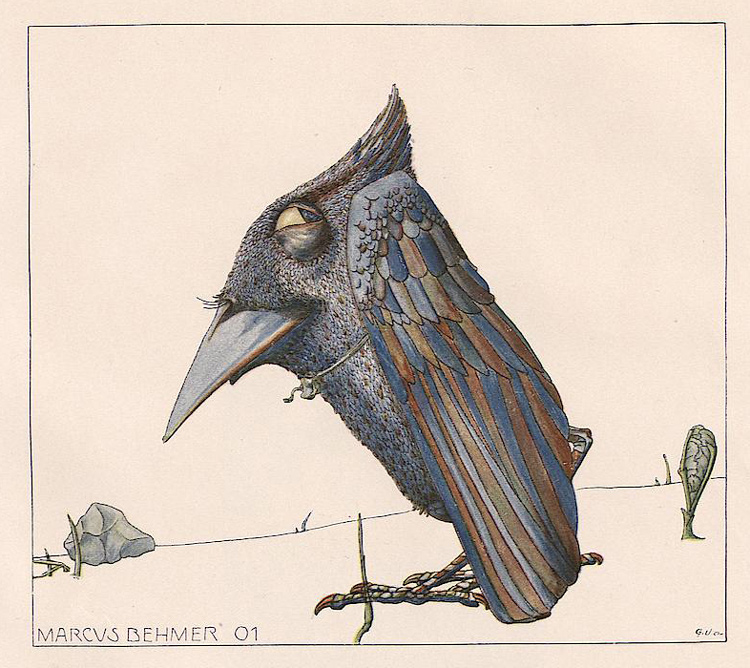 Marcus Behmer, from Ver Sacrum, 1901
I became fascinated by Marcus Behmer and his snoot-snout and big-beak creatures after seeing one of his bookplates in 2009 and posts of his work at feuilleton and The Cabinet of the Solar Plexus. (In 2011 I re-hashed feuilleton's work for a post on But Does it Float.) When I saw the image above in one of John's features on Ver Sacrum I knew I'd have to post it myself sooner or later.
Most of the images here come from Ver Sacrum, "the art journal of the Viennese Secession," published from 1898 to 1903. See the complete archive. A few come from Simplicissimus and a few from auction listings.
The only biographical information in English I could find is Oliver Tepel's account of the artist's life for an exhibit at Galerie Daniel Buchholz:Fascinated by the book art of Charles Ricketts and directly influenced by Aubrey Beardsley's revolution is in the field of illustration, Marcus Behmer starts out at the turn of the 19th century as an autodidact. He soon liberates himself from Art Nouveau and, parallel to Expressionism that was just emerging and to the new impulses from the Wiener Werkstätte in Vienna, develops his own inimitable formal idiom. In his native Weimar he catches the eye of the legendary Harry Graf Kessler. Behmer draws, writes and designs books (for Kessler's Cranach Press, but above all for the publisher Insel) developing a style of engraving that was both absolutely precise and astonishingly personal. He achieves a degree of fame in the bibliophile circles that keep abreast of the beginnings of Modernism. At the start of his career everything seems possible for Behmer, he makes early comic books, creates a language of ornament all of his own, and produces writings and pictures of astonishing comic imaginativeness and sexual frankness. But as early as the twenties Behmer suffers from the crisis in the field of the art book, and consequently from his unwavering dedication to the small format. While his book illustrations for Oscar Wilde's "La Sainte Courtisane", Hermann Bang's "Exzentrische Novellen" (Eccentric Novellas) and above all Phillip Otto Runge's "Von dem Fischer und syner Fru" (Of the Fisherman and his Wife) are highly regarded internationally, his visibly freer graphic works continue to disappear into a cultural black hole which swallows up almost all Modernist illustrators. He is still sufficiently visible however to come up on the National Socialists' radar, and in 1937 they imprisoned Behmer, who was living openly as a homosexual, for two years. [continue reading]
Also check out the tantalizing installation views at the gallery. I wish I could take a look at some of these books!
Marcus Behmer, from Ver Sacrum, 1901
I became fascinated by Marcus Behmer and his snoot-snout and big-beak creatures after seeing one of his bookplates in 2009 and posts of his work at feuilleton and The Cabinet of the Solar Plexus. (In 2011 I re-hashed feuilleton's work for a post on But Does it Float.) When I saw the image above in one of John's features on Ver Sacrum I knew I'd have to post it myself sooner or later.
Most of the images here come from Ver Sacrum, "the art journal of the Viennese Secession," published from 1898 to 1903. See the complete archive. A few come from Simplicissimus and a few from auction listings.
The only biographical information in English I could find is Oliver Tepel's account of the artist's life for an exhibit at Galerie Daniel Buchholz:Fascinated by the book art of Charles Ricketts and directly influenced by Aubrey Beardsley's revolution is in the field of illustration, Marcus Behmer starts out at the turn of the 19th century as an autodidact. He soon liberates himself from Art Nouveau and, parallel to Expressionism that was just emerging and to the new impulses from the Wiener Werkstätte in Vienna, develops his own inimitable formal idiom. In his native Weimar he catches the eye of the legendary Harry Graf Kessler. Behmer draws, writes and designs books (for Kessler's Cranach Press, but above all for the publisher Insel) developing a style of engraving that was both absolutely precise and astonishingly personal. He achieves a degree of fame in the bibliophile circles that keep abreast of the beginnings of Modernism. At the start of his career everything seems possible for Behmer, he makes early comic books, creates a language of ornament all of his own, and produces writings and pictures of astonishing comic imaginativeness and sexual frankness. But as early as the twenties Behmer suffers from the crisis in the field of the art book, and consequently from his unwavering dedication to the small format. While his book illustrations for Oscar Wilde's "La Sainte Courtisane", Hermann Bang's "Exzentrische Novellen" (Eccentric Novellas) and above all Phillip Otto Runge's "Von dem Fischer und syner Fru" (Of the Fisherman and his Wife) are highly regarded internationally, his visibly freer graphic works continue to disappear into a cultural black hole which swallows up almost all Modernist illustrators. He is still sufficiently visible however to come up on the National Socialists' radar, and in 1937 they imprisoned Behmer, who was living openly as a homosexual, for two years. [continue reading]
Also check out the tantalizing installation views at the gallery. I wish I could take a look at some of these books!
 Marcus Behmer, from Ver Sacrum, c. 1900
Marcus Behmer, from Ver Sacrum, c. 1900 Marcus Behmer, from Ver Sacrum, c. 1900
Marcus Behmer, from Ver Sacrum, c. 1900 Marcus Behmer, from Ver Sacrum, c. 1900
Marcus Behmer, from Ver Sacrum, c. 1900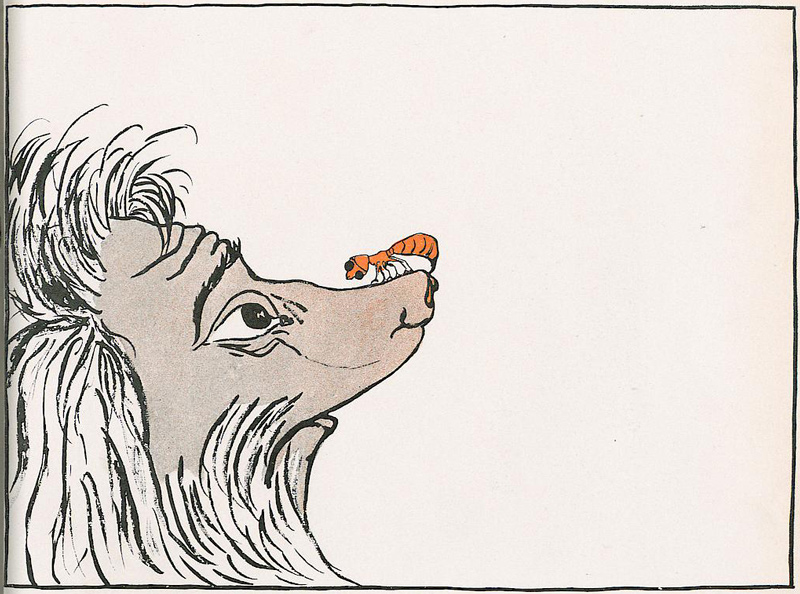 Marcus Behmer, from Ver Sacrum, c. 1900
Marcus Behmer, from Ver Sacrum, c. 1900 Marcus Behmer, from Ver Sacrum, c. 1900
Marcus Behmer, from Ver Sacrum, c. 1900 Marcus Behmer, "Karnevals Begräbnis" from Simplicissimus, 1900
Marcus Behmer, "Karnevals Begräbnis" from Simplicissimus, 1900
 Marcus Behmer, from Simplicissimus, 1901
Marcus Behmer, from Simplicissimus, 1901 Marcus Behmer, from Ver Sacrum, c. 1900
Marcus Behmer, from Ver Sacrum, c. 1900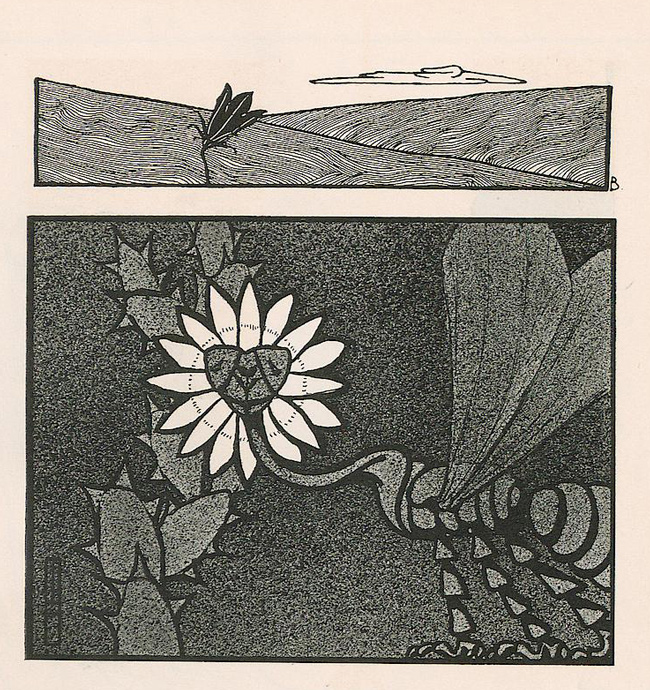 Marcus Behmer, from Ver Sacrum, c. 1900
Marcus Behmer, from Ver Sacrum, c. 1900 Marcus Behmer, from Ver Sacrum, c. 1900
Marcus Behmer, from Ver Sacrum, c. 1900 Marcus Behmer, "Faust und Wagner," Ver Sacrum, c. 1900
Marcus Behmer, "Faust und Wagner," Ver Sacrum, c. 1900 Marcus Behmer, from Ver Sacrum, c. 1900
Marcus Behmer, from Ver Sacrum, c. 1900 Marcus Behmer, Simplicissimus, 1900
Marcus Behmer, Simplicissimus, 1900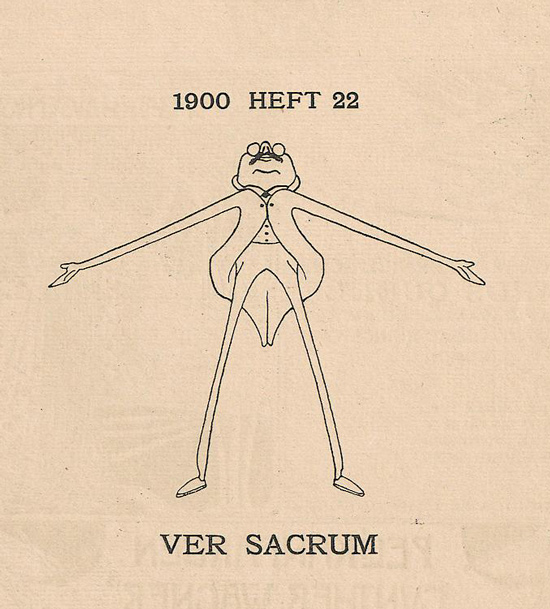 Marcus Behmer, from Ver Sacrum, c. 1900
Marcus Behmer, from Ver Sacrum, c. 1900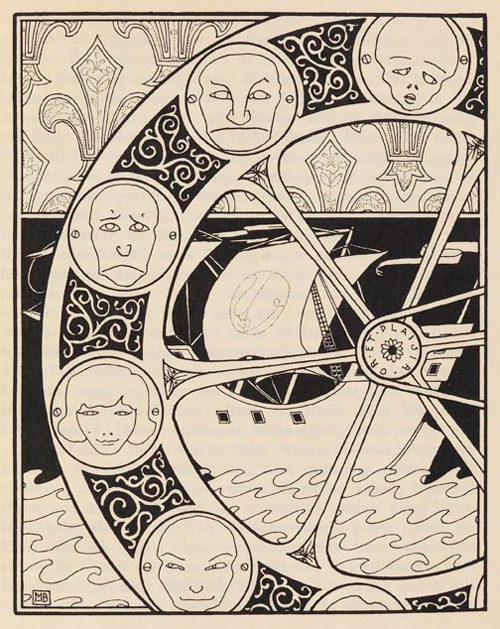 Marcus Behmer for Balzac, "Das Mädchen mit den Goldaugen" (The Girl With the Golden Eyes), 1904
Marcus Behmer for Balzac, "Das Mädchen mit den Goldaugen" (The Girl With the Golden Eyes), 1904
 See a set of Behmer's Salome illustrations at The Peacock Skirt
See a set of Behmer's Salome illustrations at The Peacock Skirt Marcus Behmer, "Das Ungerheuer"
Marcus Behmer, "Das Ungerheuer"
 1969, poster by Rafael Zarsa, Day of Solidarity with the People of Laos
From the collection of Michael Tyler
From wikipedia:The Organization of Solidarity with the People of Asia, Africa and Latin America (Organización de Solidaridad con los Pueblos de Asia, África y América Latina), abbreviated as OSPAAAL, is a Cuban political movement with the stated purpose of fighting globalisation, imperialism, neoliberalism and defending human rights.
[...]
From its foundation until the mid-1980s, OSPAAAL produced brightly coloured propaganda posters promoting their cause, however, financial difficulty and ink shortages forced the organization to stop producing these posters. However, in 2000, these posters began to be printed again.
These posters, as they intended to be internationalist, usually had their message written in Spanish, English, French, and Arabic. As opposed to being put up on walls around Cuba, these posters were instead folded up and stapled into copies of Tricontinental, so that they could be distributed internationally. This allowed OSPAAAL to send its message to its subscribers around the world.
1969, poster by Rafael Zarsa, Day of Solidarity with the People of Laos
From the collection of Michael Tyler
From wikipedia:The Organization of Solidarity with the People of Asia, Africa and Latin America (Organización de Solidaridad con los Pueblos de Asia, África y América Latina), abbreviated as OSPAAAL, is a Cuban political movement with the stated purpose of fighting globalisation, imperialism, neoliberalism and defending human rights.
[...]
From its foundation until the mid-1980s, OSPAAAL produced brightly coloured propaganda posters promoting their cause, however, financial difficulty and ink shortages forced the organization to stop producing these posters. However, in 2000, these posters began to be printed again.
These posters, as they intended to be internationalist, usually had their message written in Spanish, English, French, and Arabic. As opposed to being put up on walls around Cuba, these posters were instead folded up and stapled into copies of Tricontinental, so that they could be distributed internationally. This allowed OSPAAAL to send its message to its subscribers around the world.
 1969, poster by Faustino Perez, Day of Solidarity with Venezuela
From the collection of Michael Tyler
1969, poster by Faustino Perez, Day of Solidarity with Venezuela
From the collection of Michael Tyler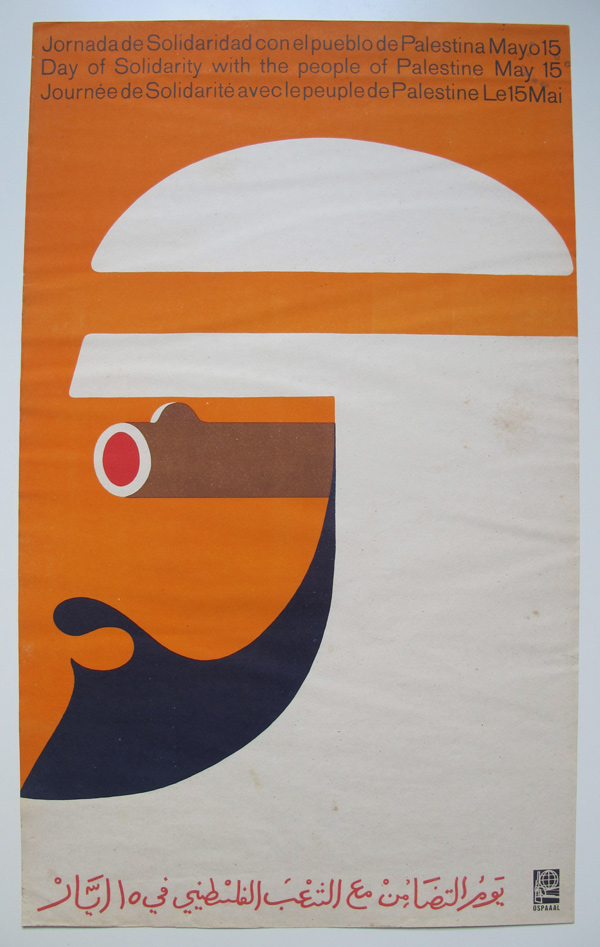 1968, poster by Faustino Perez, Day of Solidarity with the People of Palestine
From the collection of Michael Tyler
1968, poster by Faustino Perez, Day of Solidarity with the People of Palestine
From the collection of Michael Tyler 1970, poster by René Mederos, Day of solidarity with the struggle of the people of South Africa
From the collection of Michael Tyler
1970, poster by René Mederos, Day of solidarity with the struggle of the people of South Africa
From the collection of Michael Tyler
 1975, poster by Lazaro Abreu, Queens House of Detention
From the collection of Michael Tyler
1975, poster by Lazaro Abreu, Queens House of Detention
From the collection of Michael Tyler 1971, poster by Ernesto Padron, Together with Vietnam
From the collection of Michael Tyler
1971, poster by Ernesto Padron, Together with Vietnam
From the collection of Michael Tyler 1968, poster by Daysi Garcia, Day of Solidarity with the Afro American People
From the collection of Michael Tyler
1968, poster by Daysi Garcia, Day of Solidarity with the Afro American People
From the collection of Michael Tyler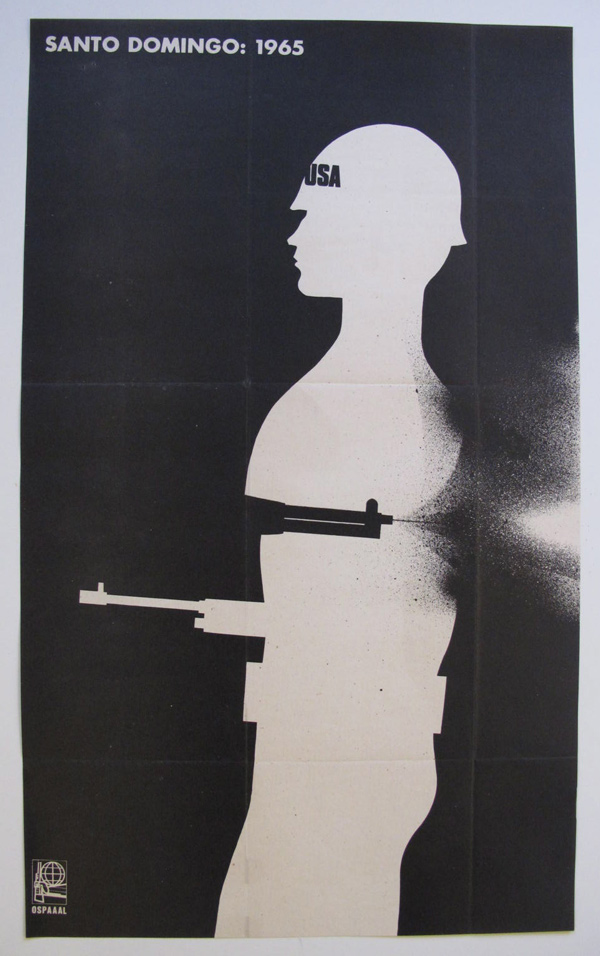 1970, poster by Alfredo Rostgaard, Santo Domingo 1965
From the collection of Michael Tyler
1970, poster by Alfredo Rostgaard, Santo Domingo 1965
From the collection of Michael Tyler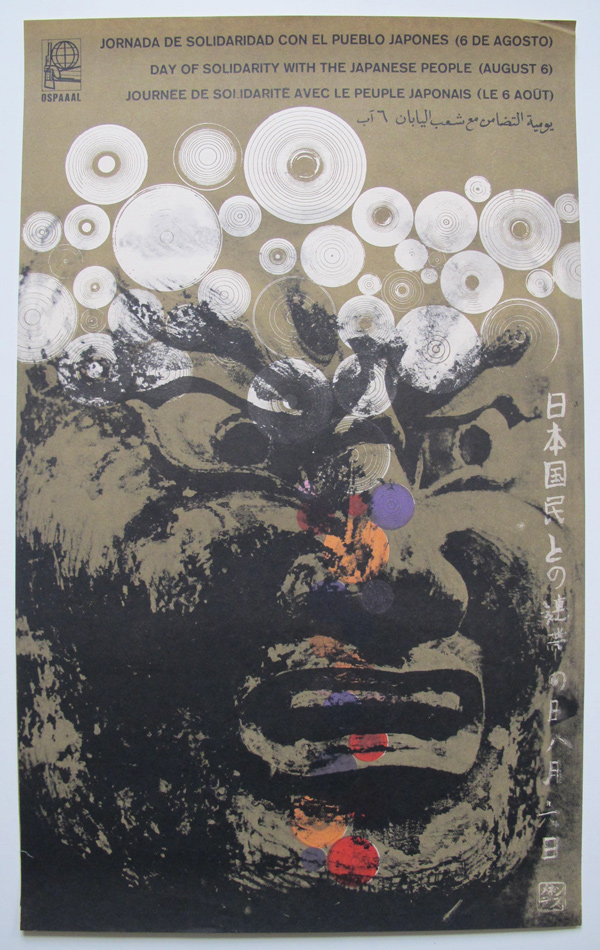 1969, poster by Guilermo Menendez, Day of solidarity with the Japanese People
From the collection of Michael Tyler
1969, poster by Guilermo Menendez, Day of solidarity with the Japanese People
From the collection of Michael Tyler 1970, poster by Faustino Pérez, Day of solidarity with Zimbabwe
From the collection of Michael Tyler
1970, poster by Faustino Pérez, Day of solidarity with Zimbabwe
From the collection of Michael Tyler
 1970, poster by Lazaro Abreu, Day of solidarity with the Arab Peoples of Syria
From the collection of Michael Tyler
1970, poster by Lazaro Abreu, Day of solidarity with the Arab Peoples of Syria
From the collection of Michael Tyler 1968, poster by Alfredo Rostgaard, Democracy Representative
From the collection of Michael Tyler
1968, poster by Alfredo Rostgaard, Democracy Representative
From the collection of Michael Tyler 1969, poster by Daysi Garcia, Day of solidarity with Angola
From the collection of Michael Tyler
1969, poster by Daysi Garcia, Day of solidarity with Angola
From the collection of Michael Tyler 1971, poster by Alfredo Rostgaard, Sekou Toure
From the collection of Michael Tyler
1971, poster by Alfredo Rostgaard, Sekou Toure
From the collection of Michael Tyler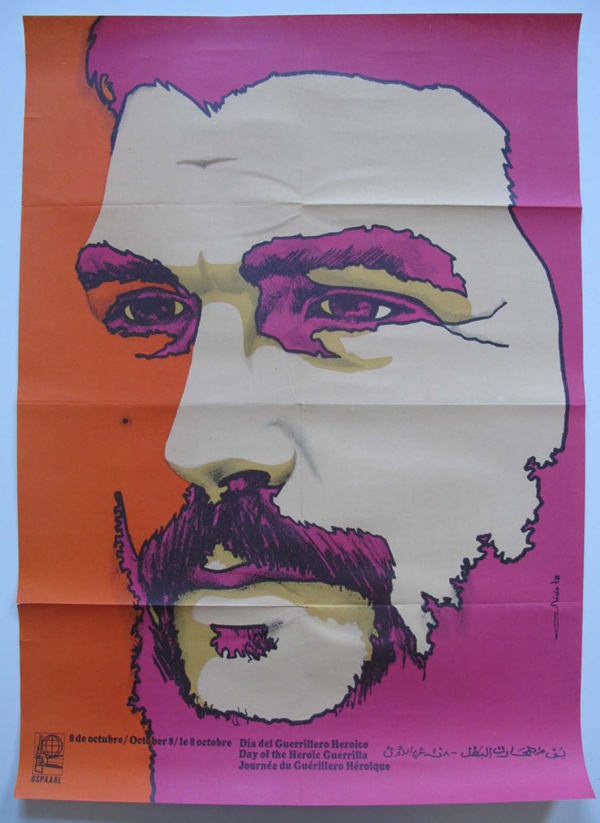 1978, poster by Olivio Martinez, Day of the Heroic Guerilla
From the collection of Michael Tyler
1978, poster by Olivio Martinez, Day of the Heroic Guerilla
From the collection of Michael Tyler 1970, poster by Asela Perez, Solidarity with Latin America
From the collection of Michael Tyler
1970, poster by Asela Perez, Solidarity with Latin America
From the collection of Michael Tyler 1968, poster by Berta Abelenda, Day of Solidarity with Palestine
From the collection of Michael Tyler
1968, poster by Berta Abelenda, Day of Solidarity with Palestine
From the collection of Michael Tyler 1969, designer unknown, For an Independant South Yemen
From the collection of Michael Tyler
1969, designer unknown, For an Independant South Yemen
From the collection of Michael Tyler 1970, poster by Lazaro Abreu,
Day of world solidarity with the people of so-called Portuguese Guinea and Cape Verde
From the collection of Michael Tyler
1970, poster by Lazaro Abreu,
Day of world solidarity with the people of so-called Portuguese Guinea and Cape Verde
From the collection of Michael Tyler 1972, poster by Alfredo Rostgaard, Nixon
From the collection of Michael Tyler
1972, poster by Alfredo Rostgaard, Nixon
From the collection of Michael Tyler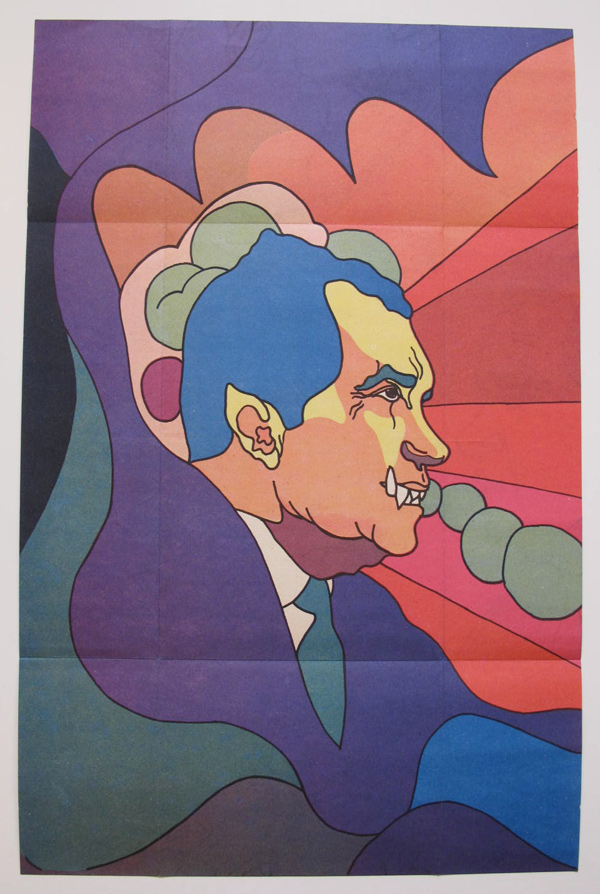 1972, poster by Alfredo Rostgaard, Nixon (unfolded)
From the collection of Michael Tyler
1972, poster by Alfredo Rostgaard, Nixon (unfolded)
From the collection of Michael Tyler
 Gente Menuda, 1933, cover by Lopez Rubio
These covers come from two exhibits curated by Felipe Hernández Cava for Museo ABC: one on Gente Menuda, the other on Francisco López Rubio.
Gente Menuda first appeared in 1904 as a children's supplement of Blanco y Negro. Its heyday and real popularity occurred from 1932 up until the Spanish Civil War. Some of the artists involved were Salvador Bartolozzi, Piti Bartolozzi, Masberger, Ramírez, Tauler, Tono, Viera Sparza, K-Hito, Barbero, Alonso, A.T.C., Hidalgo de Caviedes, Climent, Serny, Mihura, and Hortelano.
Curator Felipe Hernández Cava is also one of Spain's best comic strip writers, starting out in the El Cubri collective.
Much gratitude to the ABC Museum staff for sending the two catalogs.
Alfonso Melendez, who introduced me to this world of illustration, shows a lot of his own work and the work of his brother, illustrator Francisco Melendez, on his Facebook page.
Gente Menuda, 1933, cover by Lopez Rubio
These covers come from two exhibits curated by Felipe Hernández Cava for Museo ABC: one on Gente Menuda, the other on Francisco López Rubio.
Gente Menuda first appeared in 1904 as a children's supplement of Blanco y Negro. Its heyday and real popularity occurred from 1932 up until the Spanish Civil War. Some of the artists involved were Salvador Bartolozzi, Piti Bartolozzi, Masberger, Ramírez, Tauler, Tono, Viera Sparza, K-Hito, Barbero, Alonso, A.T.C., Hidalgo de Caviedes, Climent, Serny, Mihura, and Hortelano.
Curator Felipe Hernández Cava is also one of Spain's best comic strip writers, starting out in the El Cubri collective.
Much gratitude to the ABC Museum staff for sending the two catalogs.
Alfonso Melendez, who introduced me to this world of illustration, shows a lot of his own work and the work of his brother, illustrator Francisco Melendez, on his Facebook page.
 Gente Menuda, 1933, cover by López Rubio
Gente Menuda, 1933, cover by López Rubio
 Gente Menuda, 1934, cover by López Rubio
Gente Menuda, 1934, cover by López Rubio
 Gente Menuda, 1932, cover by Felix Alonso
Gente Menuda, 1932, cover by Felix Alonso Gente Menuda, 1935, cover by López Rubio
Gente Menuda, 1935, cover by López Rubio
 Gente Menuda, 1936, cover by López Rubio
Gente Menuda, 1936, cover by López Rubio
 Gente Menuda, 1936, cover by López Rubio
Gente Menuda, 1936, cover by López Rubio
 Gente Menuda, 1932, cover by López Rubio
Gente Menuda, 1932, cover by López Rubio
 Gente Menuda, 1932, cover by López Rubio
Gente Menuda, 1932, cover by López Rubio
 Gente Menuda, 1933, cover by López Rubio
Gente Menuda, 1933, cover by López Rubio
 Gente Menuda, 1933, cover by López Rubio
Gente Menuda, 1933, cover by López Rubio
 Gente Menuda, 1934, cover by López Rubio
Gente Menuda, 1934, cover by López Rubio
 Gente Menuda, 1934, cover by Lopez Rubio
Gente Menuda, 1934, cover by Lopez Rubio Gente Menuda, 1932, cover by A.T.C. (Angeles Torner Cervera)
Gente Menuda, 1932, cover by A.T.C. (Angeles Torner Cervera) Gente Menuda, 1932, cover by A.T.C. (Angeles Torner Cervera)
Gente Menuda, 1932, cover by A.T.C. (Angeles Torner Cervera) Gente Menuda, 1931, cover by López Rubio
Gente Menuda, 1931, cover by López Rubio
 Gente Menuda, 1934, cover by López Rubio
Gente Menuda, 1934, cover by López Rubio
 Gente Menuda, 1934, cover by López Rubio
Gente Menuda, 1934, cover by López Rubio
 Gente Menuda, 1934, cover by López Rubio
Gente Menuda, 1934, cover by López Rubio
 Gente Menuda, 1935, cover by López Rubio
Gente Menuda, 1935, cover by López Rubio
 Gente Menuda, 1936, cover by López Rubio
Gente Menuda, 1936, cover by López Rubio
 Gente Menuda, 1934, cover by Lopez Rubio
Sometimes familiar-looking characters make guest appearances:
Gente Menuda, 1934, cover by Lopez Rubio
Sometimes familiar-looking characters make guest appearances:
 Gente Menuda, 1936, cover by López Rubio
Gente Menuda, 1936, cover by López Rubio
 Gente Menuda, 1933, cover by López Rubio
Gente Menuda, 1933, cover by López Rubio
 Gente Menuda, 1936, cover by López Rubio
This post first appeared on October 10, 2013 on 50 Watts
Gente Menuda, 1936, cover by López Rubio
This post first appeared on October 10, 2013 on 50 Watts
 The images come from a 1912 Berlin edition scanned by Heinrich Heine Universität Düsseldorf, with a handful from what appears to be a Berlin/London edition (in French) held by the Public Library of Cincinnati and Hamilton County.
The German wikipedia entry tells us that Sattler is a big name in Art Nouveau remembered especially for his illustrations in Simplicissimus and Pan.
via Peacay (are you not following BibliOdyssey on tumblr?). See also his post "Danse Macabre Collection."
The images come from a 1912 Berlin edition scanned by Heinrich Heine Universität Düsseldorf, with a handful from what appears to be a Berlin/London edition (in French) held by the Public Library of Cincinnati and Hamilton County.
The German wikipedia entry tells us that Sattler is a big name in Art Nouveau remembered especially for his illustrations in Simplicissimus and Pan.
via Peacay (are you not following BibliOdyssey on tumblr?). See also his post "Danse Macabre Collection."

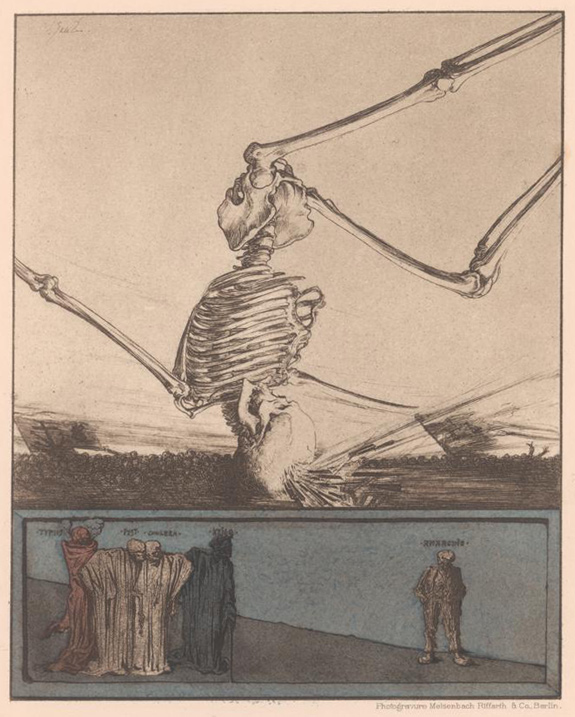

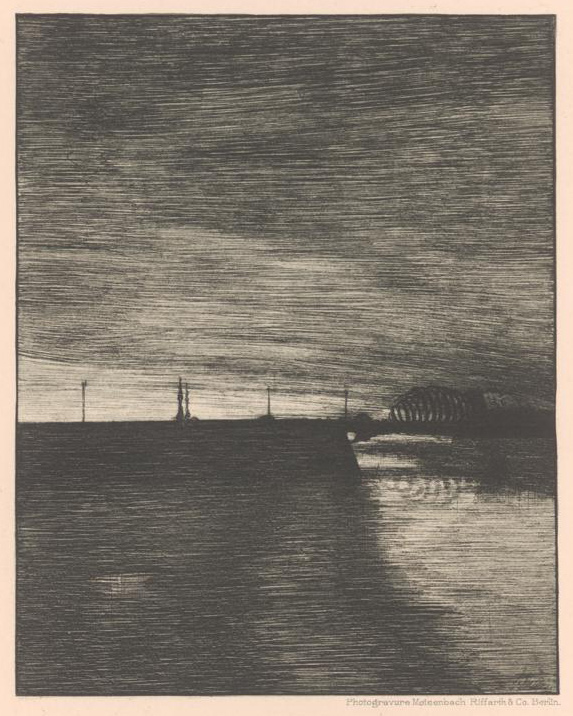

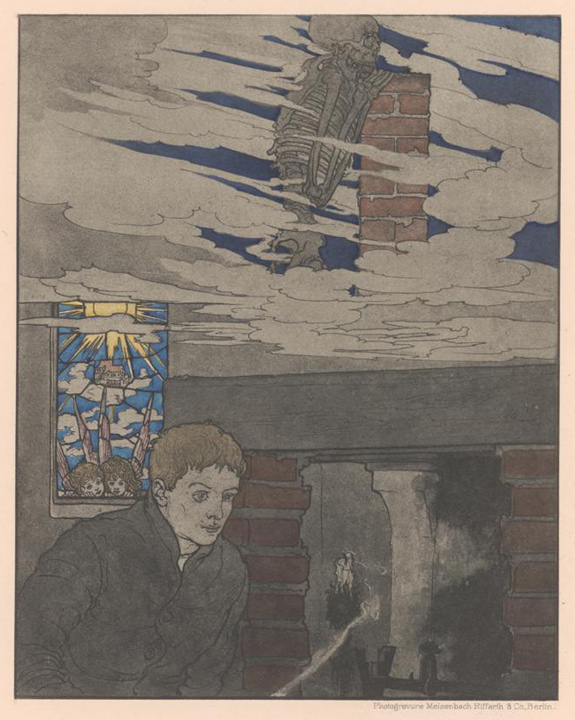


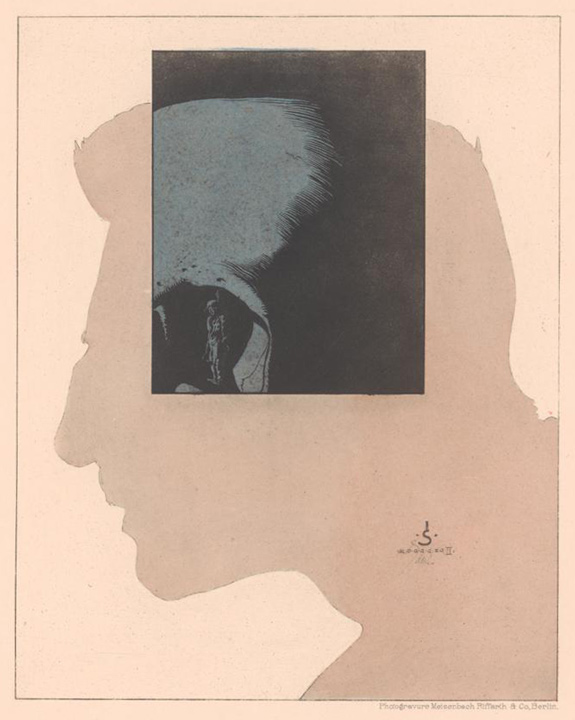





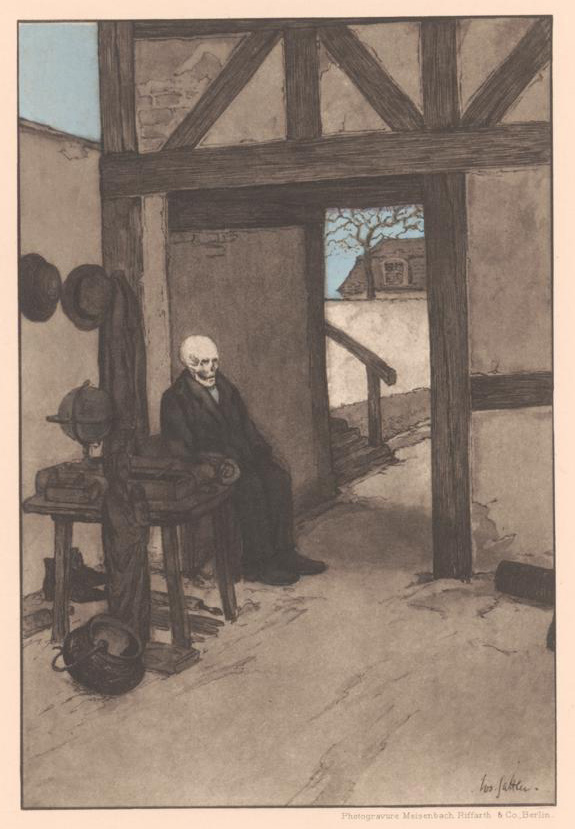


 from the earlier edition
from the earlier edition from the 1912 edition
This post first appeared on October 29, 2013 on 50 Watts
from the 1912 edition
This post first appeared on October 29, 2013 on 50 Watts
 1913, for "Rime of the Ancient Mariner"
("The souls did from their bodies fly")
I put this post together in October 2012 and for some reason never unleashed it—better late than never. If I remember correctly most of these scans come from Nicola Bowe's The Life and Work of Harry Clarke.
From James White's preface to the Bowe book, here is Clarke's eldest son Michael discussing his father:"...the priests did make an indelible mark on every sensitive child who listened with care: he would have a grim understanding of the quality of hell and an idealised version of an improbable Paradise. Thus Harry Clarke would carry into the world a comforting picture of the glories of salvation joined inevitably to a fascination with the terror of damnation which had particular bearing on those matters of sensual indulgence which his masters constantly trumpeted as a major road to eternal fire. He would never be a devout Catholic, but would never decry it in others. Much of religion in which he did not believe he found aesthetically pleasing. The peripheral rules he found an irritation. The deeper mysteries filled him with awe."
Also: "Michael has described how his father loved swimming with them, organizing games of all sorts, and would write them amusing letters enclosing illustrations and altered photographs signed with the melancholy nom-de-plume J. Sick..."
See all Harry Clarke posts on 50 Watts
1913, for "Rime of the Ancient Mariner"
("The souls did from their bodies fly")
I put this post together in October 2012 and for some reason never unleashed it—better late than never. If I remember correctly most of these scans come from Nicola Bowe's The Life and Work of Harry Clarke.
From James White's preface to the Bowe book, here is Clarke's eldest son Michael discussing his father:"...the priests did make an indelible mark on every sensitive child who listened with care: he would have a grim understanding of the quality of hell and an idealised version of an improbable Paradise. Thus Harry Clarke would carry into the world a comforting picture of the glories of salvation joined inevitably to a fascination with the terror of damnation which had particular bearing on those matters of sensual indulgence which his masters constantly trumpeted as a major road to eternal fire. He would never be a devout Catholic, but would never decry it in others. Much of religion in which he did not believe he found aesthetically pleasing. The peripheral rules he found an irritation. The deeper mysteries filled him with awe."
Also: "Michael has described how his father loved swimming with them, organizing games of all sorts, and would write them amusing letters enclosing illustrations and altered photographs signed with the melancholy nom-de-plume J. Sick..."
See all Harry Clarke posts on 50 Watts
 1915, for "Rime of the Ancient Mariner"
1915, for "Rime of the Ancient Mariner" 1913, for De Profundis (Wilde)
1913, for De Profundis (Wilde) 1920, "Out on the wind of Time, shining and streaming," illustration to Rupert Brooke's "The Great Lover"
1920, "Out on the wind of Time, shining and streaming," illustration to Rupert Brooke's "The Great Lover" 1925, Faust and Mephistopheles, end-piece to Faust
1925, Faust and Mephistopheles, end-piece to Faust detail
detail 1914, Hibernia, calendar design for an insurance company
1914, Hibernia, calendar design for an insurance company 1923, Christmas card
1923, Christmas card 1917, cover for fifth exhibition of Arts and Crafts Society
1917, cover for fifth exhibition of Arts and Crafts Society 1925, unpublished illus. of Garden scene in Faust
1925, unpublished illus. of Garden scene in Faust 1928, design for panel, Geneva Window, based on Yeats' "Countess Cathleen"
1928, design for panel, Geneva Window, based on Yeats' "Countess Cathleen" 1924, illus. for Clemence Dane, Women Voters and the Death Penalty, Good Housekeeping
1924, illus. for Clemence Dane, Women Voters and the Death Penalty, Good Housekeeping 1924, The Devil's Wife and her Eldest
1924, The Devil's Wife and her Eldest 1925, Dublin Drama League
1925, Dublin Drama League detail
detail 1913, Silver Apples of the Moon
1913, Silver Apples of the Moon 1925, Ophelia (or Lobster), after Hokusai
1925, Ophelia (or Lobster), after Hokusai 1913, The Dream, Pope, The Rape of Lock, 1913
1913, The Dream, Pope, The Rape of Lock, 1913 1925, Mephistopheles, for Faust (misshapen bodies with wormlike heads)
1925, Mephistopheles, for Faust (misshapen bodies with wormlike heads) 1925, The Street, from Faust
1925, The Street, from Faust 1925, The Two Distilleries on the Same Hill, for Warren, Elixir of Life
1925, The Two Distilleries on the Same Hill, for Warren, Elixir of Life c. 1920, untitled
c. 1920, untitled 1917, The Mad Mulrannies, Synge's Playboy of the Western World
1917, The Mad Mulrannies, Synge's Playboy of the Western World 1922, The Last Hour of the Night, illus. to Dublin of the Future
1922, The Last Hour of the Night, illus. to Dublin of the Future 1923, cover for Lennox Robinson's plays
1923, cover for Lennox Robinson's plays Poe's Tales of Mystery and Imagination illustration, mixed media on paper
Poe's Tales of Mystery and Imagination illustration, mixed media on paper detail
detail 1923, from dustjacket for Poe's Tales of Mystery and Imagination
1923, from dustjacket for Poe's Tales of Mystery and Imagination 1923, first US edition of Poe's Tales of Mystery and Imagination
1923, first US edition of Poe's Tales of Mystery and Imagination caricature self portrait in medieval garret
See all Harry Clarke posts on 50 Watts
This post first appeared on October 30, 2013 on 50 Watts.
caricature self portrait in medieval garret
See all Harry Clarke posts on 50 Watts
This post first appeared on October 30, 2013 on 50 Watts.
 Leonid Stroganov (Russian, b. 1979)
Leonid Stroganov (Russian, b. 1979) Max Švabinský (Czech, 1873–1962)
Max Švabinský (Czech, 1873–1962)
 F. S. Coburn (Canadian, 1871–1960)
F. S. Coburn (Canadian, 1871–1960)
 Vladimir Suchánek (Czech, b. 1933)
Vladimir Suchánek (Czech, b. 1933)
 Jrisdu (?)
Jrisdu (?) Fritz Gilsi (Swiss, 1878–1961)
Fritz Gilsi (Swiss, 1878–1961)
 Henry Chapront (France, 1876-1965), Charles Baudelaire, 1922
Thank you Daniel for the i.d. Read about this one at Idbury.
Henry Chapront (France, 1876-1965), Charles Baudelaire, 1922
Thank you Daniel for the i.d. Read about this one at Idbury.
 Harry Jurgens (Estonian, lives and works in Germany, b. 1949)
See all bookplate posts on 50 Watts (including parts 1 through 10 of this series).
This post first appeared on
Harry Jurgens (Estonian, lives and works in Germany, b. 1949)
See all bookplate posts on 50 Watts (including parts 1 through 10 of this series).
This post first appeared on
 Liu Chunjie (刘春杰), b. 1965, 856 State Farm, Heilongjiang
The Revolving Moon, 1992
multi-block woodcut, printed with water-soluble ink
These images come from the hard-to-find book Chinese Prints 1950–2006 in the Ashmolean Museum by Weimin He and Shelagh Vainker. They are also on the Ashmolean website. I provided links beneath each image, though the site seems to have some glitches (and the links might all be dead).
I say "hard-to-find" but good news: "Eastern Art Online will soon present an online version of Chinese Prints 1950-2006 in the Ashmolean Museum, enabling visitors to browse and search all the objects and their high-quality zoomable images featured in this publication..." [at which point this post becomes even more useless]
For some reason I've been sitting on this post since November 2012 (maybe waiting for the online version of the book to appear?). It was meant to be paired with the post "Dancing On and Beneath the Great Wall."
All works © Ashmolean Museum, University of Oxford and the artists or their estates
Liu Chunjie (刘春杰), b. 1965, 856 State Farm, Heilongjiang
The Revolving Moon, 1992
multi-block woodcut, printed with water-soluble ink
These images come from the hard-to-find book Chinese Prints 1950–2006 in the Ashmolean Museum by Weimin He and Shelagh Vainker. They are also on the Ashmolean website. I provided links beneath each image, though the site seems to have some glitches (and the links might all be dead).
I say "hard-to-find" but good news: "Eastern Art Online will soon present an online version of Chinese Prints 1950-2006 in the Ashmolean Museum, enabling visitors to browse and search all the objects and their high-quality zoomable images featured in this publication..." [at which point this post becomes even more useless]
For some reason I've been sitting on this post since November 2012 (maybe waiting for the online version of the book to appear?). It was meant to be paired with the post "Dancing On and Beneath the Great Wall."
All works © Ashmolean Museum, University of Oxford and the artists or their estates
 Li Yili (李毅力), b. 1954, Qijiang, Chongqing
Hometown Record, 2004
woodcut, printed with water-soluble ink
Li Yili (李毅力), b. 1954, Qijiang, Chongqing
Hometown Record, 2004
woodcut, printed with water-soluble ink
 Wang Bing (王兵), b. 1961, Gannan, Gansu
Restaurant in Grazing Land, 1996
woodcut, printed with oil-based ink
Wang Bing (王兵), b. 1961, Gannan, Gansu
Restaurant in Grazing Land, 1996
woodcut, printed with oil-based ink
 Chen Long (陈龙), b. 1974, Heilongjiang
State of Existence, 2003
waste-block woodcut, printed with water-soluble ink on canvas
Chen Long (陈龙), b. 1974, Heilongjiang
State of Existence, 2003
waste-block woodcut, printed with water-soluble ink on canvas
 Chen Yanlong (陈彦龙), v. 1965, Fujin, Heilongjiang
Impact, 2002
multi-block woodcut, printed with oil-based ink
Chen Yanlong (陈彦龙), v. 1965, Fujin, Heilongjiang
Impact, 2002
multi-block woodcut, printed with oil-based ink
 Ma Hongwen (马洪文), b. 1962, Qing'an, Heilongjiang
Autumn Dance, 2003
multi-block woodcut, printed with oil-based ink
Ma Hongwen (马洪文), b. 1962, Qing'an, Heilongjiang
Autumn Dance, 2003
multi-block woodcut, printed with oil-based ink
 Dai Daquan (代大权), b. 1954, Beijing
The Head of the Yaozemao Village, 2003
woodcut, printed with oil-based ink
Dai Daquan (代大权), b. 1954, Beijing
The Head of the Yaozemao Village, 2003
woodcut, printed with oil-based ink
 Yu Chengyou (于承佑), b. 1953, Jimo, Shandong
Misty Morning, 2003
multi-block woodcut, printed with water-soluble ink
Yu Chengyou (于承佑), b. 1953, Jimo, Shandong
Misty Morning, 2003
multi-block woodcut, printed with water-soluble ink
 Chao Mei (晁楣), b. 1931, Heze, Shandong
September in the North, 1963
multi-block woodcut, printed with oil-based ink
Chao Mei (晁楣), b. 1931, Heze, Shandong
September in the North, 1963
multi-block woodcut, printed with oil-based ink
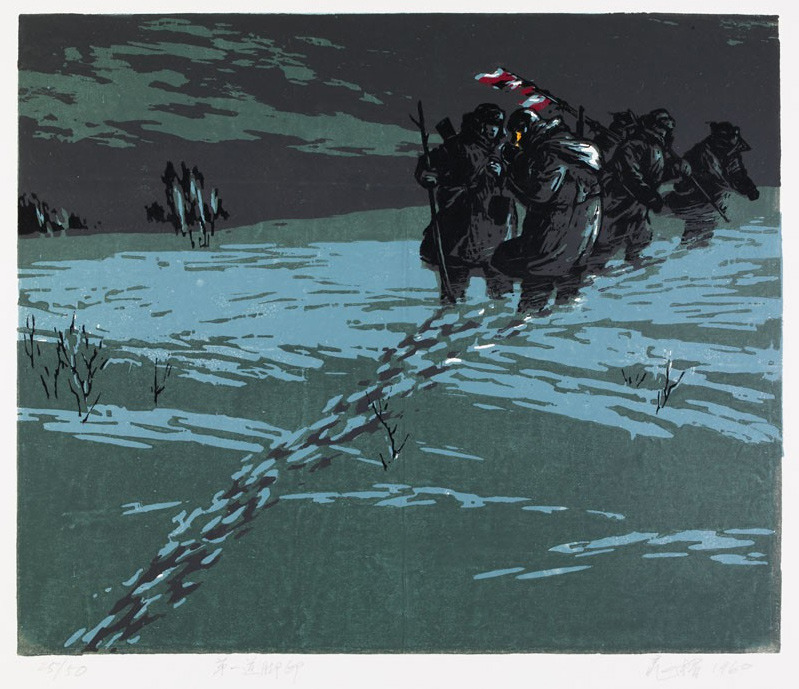 Chao Mei (晁楣), b. 1931, Heze, Shandong
The First Track of Footprints, 1960
multi-block woodcut, printed with oil-based ink
Quote from the book: "This work records an event during the late 1950s when ten million soldiers were sent to the Great Northern Wilderness in northeast China to become agricultural workers; Chao Mei was one of them."
Chao Mei (晁楣), b. 1931, Heze, Shandong
The First Track of Footprints, 1960
multi-block woodcut, printed with oil-based ink
Quote from the book: "This work records an event during the late 1950s when ten million soldiers were sent to the Great Northern Wilderness in northeast China to become agricultural workers; Chao Mei was one of them."
 Kong Fanjia (孔繁佳), b. 1957, Jiamusi, Heilongjiang
Vigorous Grass, 1992
multi-block woodcut, printed with oil-based ink
Kong Fanjia (孔繁佳), b. 1957, Jiamusi, Heilongjiang
Vigorous Grass, 1992
multi-block woodcut, printed with oil-based ink
 Dai Zhengsheng (戴政生), b. 1954, Quxian, Sichuan
A Distant Sound from the East, 1998
woodcut, printed with oil-based ink
Dai Zhengsheng (戴政生), b. 1954, Quxian, Sichuan
A Distant Sound from the East, 1998
woodcut, printed with oil-based ink
 Chen Haiyan (陈海燕), b 1955, Fushun, Liaoning
Dream - Shout, 2004
woodcut, printed with oil-based ink
Chen Haiyan (陈海燕), b 1955, Fushun, Liaoning
Dream - Shout, 2004
woodcut, printed with oil-based ink
 Gu Wenming (谷文明), b. 1964, Yakeshi, Inner Mongolia (in Beijing since 90s)
Dreams of Nature series no. 1 - The Green Flute
waste-block woodcut, printed with oil-based ink
Gu Wenming (谷文明), b. 1964, Yakeshi, Inner Mongolia (in Beijing since 90s)
Dreams of Nature series no. 1 - The Green Flute
waste-block woodcut, printed with oil-based ink
 Xu Bing (徐冰), b. 1955 Chongqing
Life Pond, 1987
woodcut; ink inscription
Xu Bing (徐冰), b. 1955 Chongqing
Life Pond, 1987
woodcut; ink inscription
 Guang Jun (广军), b. 1938, Shenyang, Liaoning
Picking Lotus, 1985
screenprint
Guang Jun (广军), b. 1938, Shenyang, Liaoning
Picking Lotus, 1985
screenprint
 Li Qun (力群), b. 1912 Lingshi, Shanxi
Beijing Snow scene, 1957
multi-block woodcut, printed with oil-based ink
Read about Li Qun, who died at age 100 in 2012
Li Qun (力群), b. 1912 Lingshi, Shanxi
Beijing Snow scene, 1957
multi-block woodcut, printed with oil-based ink
Read about Li Qun, who died at age 100 in 2012
 Li Qun, In the Trees, 1980
woodcut, printed with oil-based ink
Li Qun, In the Trees, 1980
woodcut, printed with oil-based ink Su Xingping (苏新平), b. 1960, Jining, Inner Mongolia, teaches in Beijing
Magic series, 2000
lithograph
Su Xingping (苏新平), b. 1960, Jining, Inner Mongolia, teaches in Beijing
Magic series, 2000
lithograph
 Chen Yuping (陈玉平), b. 1947, Ning’an, Heilongjiang
Autumn Sound
Also see this Chinese blog post.
Chen Yuping (陈玉平), b. 1947, Ning’an, Heilongjiang
Autumn Sound
Also see this Chinese blog post.
 Song Wenzhi, 1919–1999
New Aspects of Lake Tai, 1973
painting reproduced as lithograph
[inscribed "painted at Xishan at Dongting in Suzhou, March 1972']
Song Wenzhi, 1919–1999
New Aspects of Lake Tai, 1973
painting reproduced as lithograph
[inscribed "painted at Xishan at Dongting in Suzhou, March 1972']
 Xu Xiangdong, b. 1962, Heilongjiang
Dream, 2004
woodcut, printed with oil-based ink
Xu Xiangdong, b. 1962, Heilongjiang
Dream, 2004
woodcut, printed with oil-based ink Qijia Dawa (其加达瓦), b. 1946, Ganzi, Sichuan
Ancient Temple on the Plateau, 1981
woodcut, printed with oil-based ink
Qijia Dawa (其加达瓦), b. 1946, Ganzi, Sichuan
Ancient Temple on the Plateau, 1981
woodcut, printed with oil-based ink
 Yu Chengyou (于承佑), b. 1953, Jimo, Shandong
Night in a Small Village, 1984
multi-block woodcut, printed with oil-based ink
"In my career as an artist, my goal is to approach perfection and sincerity, using my cutting knife to enrich my life."—Yu Chengyou
Yu Chengyou (于承佑), b. 1953, Jimo, Shandong
Night in a Small Village, 1984
multi-block woodcut, printed with oil-based ink
"In my career as an artist, my goal is to approach perfection and sincerity, using my cutting knife to enrich my life."—Yu Chengyou
 Liu Chunjie, Heilongjiang
Deer's Call, 1993
multi-block woodcut, printed with oil-based ink
Previously: The Great Northern Wasteland
This post first appeared on December 5, 2013 on 50 Watts
Liu Chunjie, Heilongjiang
Deer's Call, 1993
multi-block woodcut, printed with oil-based ink
Previously: The Great Northern Wasteland
This post first appeared on December 5, 2013 on 50 Watts






 detail
detail cropped from the cover
cropped from the cover





 Previously:
Etchings of a Puppeteer
Master of Puppet Masters
Franz Wacik
This post first appeared on January 31, 2014 on 50 Watts
Previously:
Etchings of a Puppeteer
Master of Puppet Masters
Franz Wacik
This post first appeared on January 31, 2014 on 50 Watts
 Franz Wacik, illustrated cover for Wiener Kinder 1. Buch, 1923
See my June 2013 post on Franz Wacik
From the catalog: "The first primer to appear in Vienna according to the requirements of the Social Democratic school reform. Franz Wacik, who was commissioned to illustrate this book, was already well-known as an artist. Published in many editions, the primer—its exterior already signalling clarity and contemporary self-awareness—is now considered a key work of interwar primer art."
Most of these scans come from the book Jugendschatz und Wunderscherlein: Book Art for Children in Vienna 1890–1938 (text in German and English; Amaz link). The book accompanied a 2009 exhibit at the "works on paper" arm of the Museum of Applied Arts in Vienna.
For an excellent overview of the book, read Helen Chang's piece for Design Observer. Here's the publisher's description:From the end of the 19th century to 1938, many children's books of artistic importance were published in Vienna. This publication is devoted to this special genre of book art, which at that time ranked in importance alongside architecture, painting, literature, music and theatre.
The illustrations of notable artists such as C. O. Czeschka, Heinrich Lefler, Bertold Loffler, Koloman Moser, as well as those of numerous, talented—though as yet unknown—graphic artists are evidence of the variety of high quality works produced.
Moreover, the selected children's books, divided into four chapters (I. From Monarchy to Republic, II. Bourgeois Life, III. The Modern World, IV. New Teaching Methods) can be seen in the political, social and economic context concerned.
As part of daily culture, they reflect contemporary realities and utopias, which at this stage are still revealed to children by means of the 'picture book'. In a fifth chapter (V. Art for Children - Children's Art), aesthetic developments and artistic possibilities of expression are put into visual form.
The historical children's book in particular reveals impressively individual artistic craftsmanship, and styles and modes typical of particular epochs.
Based on around one hundred works, the publication charts not only the history of the development of the modern children's book in Vienna, but also that of the modern book art overall.
A handful of the scans come from the harder-to-find Wien und Berlin: Zwei Metropolen im Spiegel des Kinderbuchs 1870–1945 (worldcat) and a handful from various online sources.
Franz Wacik, illustrated cover for Wiener Kinder 1. Buch, 1923
See my June 2013 post on Franz Wacik
From the catalog: "The first primer to appear in Vienna according to the requirements of the Social Democratic school reform. Franz Wacik, who was commissioned to illustrate this book, was already well-known as an artist. Published in many editions, the primer—its exterior already signalling clarity and contemporary self-awareness—is now considered a key work of interwar primer art."
Most of these scans come from the book Jugendschatz und Wunderscherlein: Book Art for Children in Vienna 1890–1938 (text in German and English; Amaz link). The book accompanied a 2009 exhibit at the "works on paper" arm of the Museum of Applied Arts in Vienna.
For an excellent overview of the book, read Helen Chang's piece for Design Observer. Here's the publisher's description:From the end of the 19th century to 1938, many children's books of artistic importance were published in Vienna. This publication is devoted to this special genre of book art, which at that time ranked in importance alongside architecture, painting, literature, music and theatre.
The illustrations of notable artists such as C. O. Czeschka, Heinrich Lefler, Bertold Loffler, Koloman Moser, as well as those of numerous, talented—though as yet unknown—graphic artists are evidence of the variety of high quality works produced.
Moreover, the selected children's books, divided into four chapters (I. From Monarchy to Republic, II. Bourgeois Life, III. The Modern World, IV. New Teaching Methods) can be seen in the political, social and economic context concerned.
As part of daily culture, they reflect contemporary realities and utopias, which at this stage are still revealed to children by means of the 'picture book'. In a fifth chapter (V. Art for Children - Children's Art), aesthetic developments and artistic possibilities of expression are put into visual form.
The historical children's book in particular reveals impressively individual artistic craftsmanship, and styles and modes typical of particular epochs.
Based on around one hundred works, the publication charts not only the history of the development of the modern children's book in Vienna, but also that of the modern book art overall.
A handful of the scans come from the harder-to-find Wien und Berlin: Zwei Metropolen im Spiegel des Kinderbuchs 1870–1945 (worldcat) and a handful from various online sources.
 Wenzel Oswald, illus. for Himmlische Mär by Leo Blonder, 1914
According to a Swiss bookseller in 2009: "Spectacular children’s book uniting the work of two artists of the Wiener Werkstätte. This book is of the utmost rarity in any form and has never come up for auction in the past 30 years; we only know of one other copy of the deluxe edition in private hands. $12,500."
Wenzel Oswald, illus. for Himmlische Mär by Leo Blonder, 1914
According to a Swiss bookseller in 2009: "Spectacular children’s book uniting the work of two artists of the Wiener Werkstätte. This book is of the utmost rarity in any form and has never come up for auction in the past 30 years; we only know of one other copy of the deluxe edition in private hands. $12,500."
 Heinrich Lefler, illus. for Die Bucher der Chronika der drei Schwestern, 1900
Heinrich Lefler, illus. for Die Bucher der Chronika der drei Schwestern, 1900 C. O. Czeschka, Die Nibelungen, 1908
C. O. Czeschka, Die Nibelungen, 1908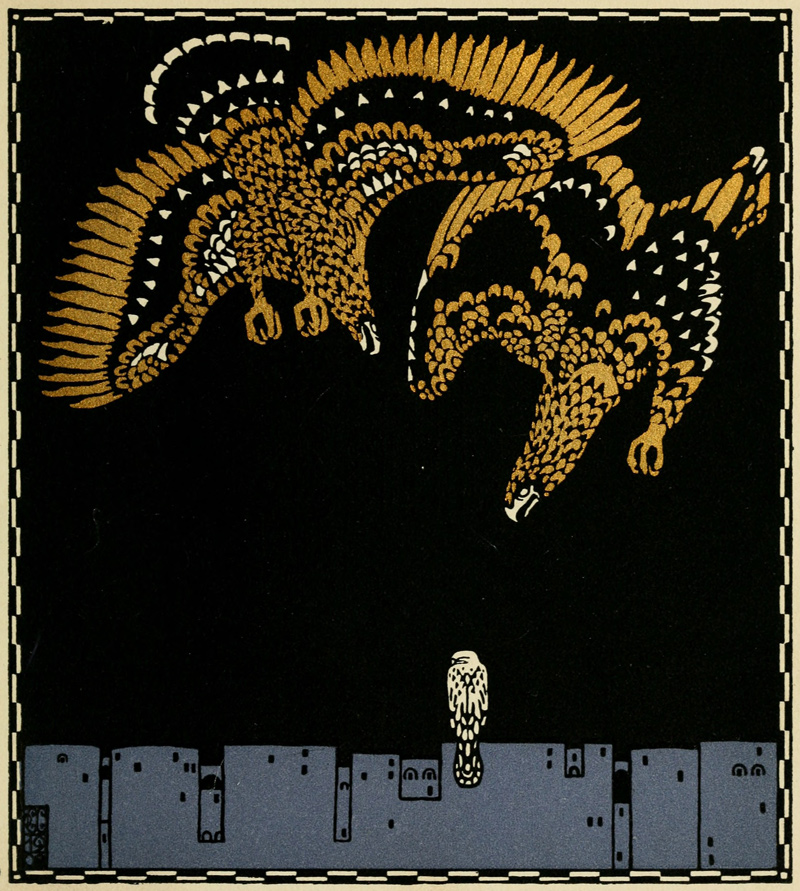 C. O. Czeschka, Die Nibelungen, 1908
full set here thanks to Mattia Moretti
C. O. Czeschka, Die Nibelungen, 1908
full set here thanks to Mattia Moretti C. O. Czeschka, Die Nibelungen, 1908
full set here thanks to Mattia Moretti
C. O. Czeschka, Die Nibelungen, 1908
full set here thanks to Mattia Moretti Koloman Moser, sketch for Jugendschatz, 1897
Koloman Moser, sketch for Jugendschatz, 1897 Koloman Moser, sketch for Jugendschatz, 1897
Koloman Moser, sketch for Jugendschatz, 1897 Wiener Werkstatte Bilderbogen, 1907 (M Jung?)
Wiener Werkstatte Bilderbogen, 1907 (M Jung?) Adelheid Malecki, Mein Herz gehort meinen Volkern, 1913
Adelheid Malecki, Mein Herz gehort meinen Volkern, 1913 Class of Franz Cizek, Jugendkunstklasse, 1922
Class of Franz Cizek, Jugendkunstklasse, 1922 Anna Lesznai, Die Reise des Kleinen Schmetterlings..., 1912
Read a short bio of this Hungarian artist (wife of Tibor Gergely) here.
Anna Lesznai, Die Reise des Kleinen Schmetterlings..., 1912
Read a short bio of this Hungarian artist (wife of Tibor Gergely) here. Richard Teschner, Tobias Immerschneller, 1910, cover
Teschner keeps popping up everywhere I turn. See three 50 Watts posts on him here.
Richard Teschner, Tobias Immerschneller, 1910, cover
Teschner keeps popping up everywhere I turn. See three 50 Watts posts on him here.
 Richard Teschner, Tobias Immerschneller, 1910
this image from the collection of Amélie Ziersch
Richard Teschner, Tobias Immerschneller, 1910
this image from the collection of Amélie Ziersch
 Ludwig Heinrich Jungnickel, Tierfabeln des klassischen Altertums, 1919
Ludwig Heinrich Jungnickel, Tierfabeln des klassischen Altertums, 1919 Lore Bohler, School of Emmy Zweybruck, 1924
Lore Bohler, School of Emmy Zweybruck, 1924 Ferdinand Andri, Ausgewahlte Gedichte, 1904
Ferdinand Andri, Ausgewahlte Gedichte, 1904 Alfred Zangerl, Zirkus, 1925
Alfred Zangerl, Zirkus, 1925 signed Steffi Krauss
Weihnacht, Vienna, 1922
signed Steffi Krauss
Weihnacht, Vienna, 1922 Risa Bernt, illus. for Unser Franzi by Nelly Goebel, 1908
Risa Bernt, illus. for Unser Franzi by Nelly Goebel, 1908 Lilly Jacobsen, etc., Leporello Bilderbuch Blumenstrauss, 1919
Lilly Jacobsen, etc., Leporello Bilderbuch Blumenstrauss, 1919 Maria Grengg for Marie Von Ebner-Eschenbach, 1917
Maria Grengg for Marie Von Ebner-Eschenbach, 1917 Heinrich Lefler and Joseph Urban, Kling Klang Gloria, 1907
Heinrich Lefler and Joseph Urban, Kling Klang Gloria, 1907 Heinrich Lefler, Die Prinzessin und der Schweinehirt, 1897
The clear inspiration for Einar Nerman's Swineherd.
The catalog says these illustrations "mark the beginning of modern book art in Vienna."
Heinrich Lefler, Die Prinzessin und der Schweinehirt, 1897
The clear inspiration for Einar Nerman's Swineherd.
The catalog says these illustrations "mark the beginning of modern book art in Vienna." Joseph Binder, Indianermarchen, 1921
Joseph Binder, Indianermarchen, 1921 Class of Adolf Bohm, Bilderbuch der Kunstschule fur Frauen und Madchen, 1901
Class of Adolf Bohm, Bilderbuch der Kunstschule fur Frauen und Madchen, 1901 Richard Rothe, Das Marlein vom Wunderscherlein, 1926
Richard Rothe, Das Marlein vom Wunderscherlein, 1926 Otto Schubert, Hoch die Republik, 1928
See the full "Kinderbuch series" of German, Austrian, and Swiss children's books
See all children's books on 50 Watts
This post first appeared on February 4, 2014 on 50 Watts
Otto Schubert, Hoch die Republik, 1928
See the full "Kinderbuch series" of German, Austrian, and Swiss children's books
See all children's books on 50 Watts
This post first appeared on February 4, 2014 on 50 Watts
 Vera Idelson, costume design for Maschinenangst by Ruggero Vasari
From the Jan. 1925 issue of Der Sturm (Berlin)
This play made it into English—as The Anguish of the Machines—in the anthology Robots, Robots, Robots (Boston: New York Graphic Society, 1978). Naturally, I'm investigating that anthology! There's an academic article about Vasari here and an Italian blog has discussed the play. Vera Idelson (1893–1977) doesn't turn up in many search results. Here's a 1937 costume design.
I have a few more posts in the works from the archives of Der Sturm.
Vera Idelson, costume design for Maschinenangst by Ruggero Vasari
From the Jan. 1925 issue of Der Sturm (Berlin)
This play made it into English—as The Anguish of the Machines—in the anthology Robots, Robots, Robots (Boston: New York Graphic Society, 1978). Naturally, I'm investigating that anthology! There's an academic article about Vasari here and an Italian blog has discussed the play. Vera Idelson (1893–1977) doesn't turn up in many search results. Here's a 1937 costume design.
I have a few more posts in the works from the archives of Der Sturm.
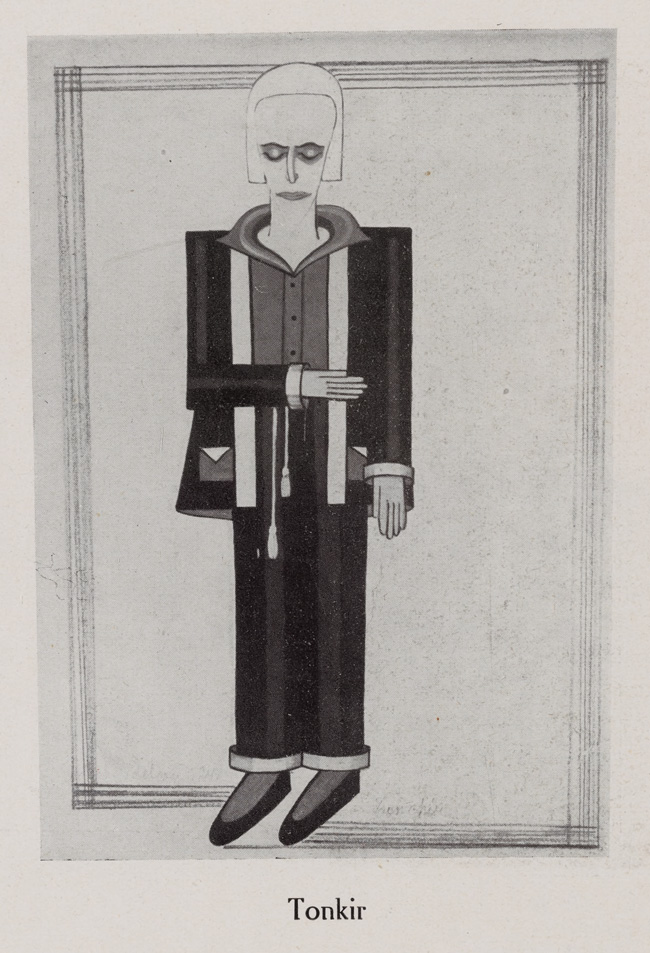 Vera Idelson, costume design for Maschinenangst by Ruggero Vasari
From the Jan. 1925 issue of Der Sturm (Berlin)
Vera Idelson, costume design for Maschinenangst by Ruggero Vasari
From the Jan. 1925 issue of Der Sturm (Berlin)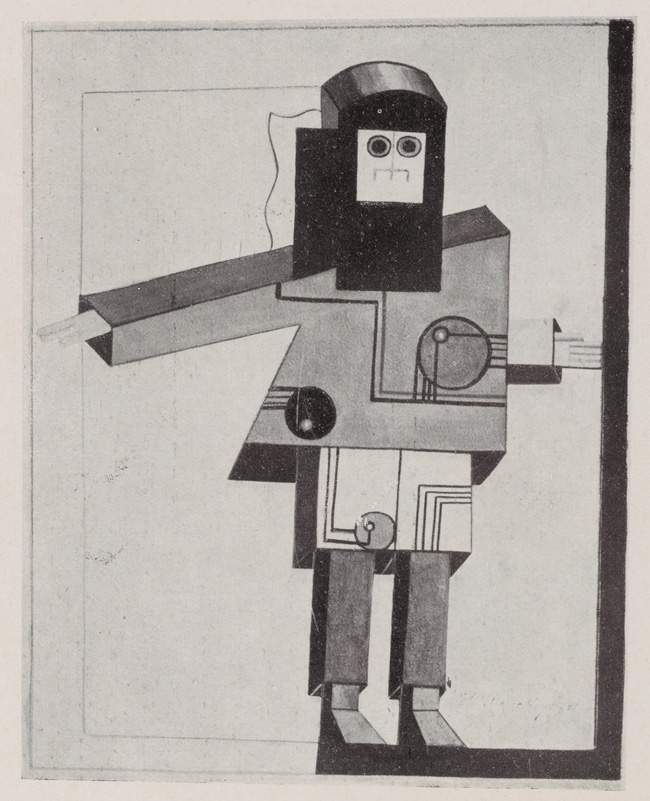 Vera Idelson, costume design for Maschinenangst by Ruggero Vasari
From the Jan. 1925 issue of Der Sturm (Berlin)
The above and below are captioned "Die Maschinenverdammten"
Vera Idelson, costume design for Maschinenangst by Ruggero Vasari
From the Jan. 1925 issue of Der Sturm (Berlin)
The above and below are captioned "Die Maschinenverdammten"
 Vera Idelson, costume design for Maschinenangst by Ruggero Vasari
From the Jan. 1925 issue of Der Sturm (Berlin)
Vera Idelson, costume design for Maschinenangst by Ruggero Vasari
From the Jan. 1925 issue of Der Sturm (Berlin)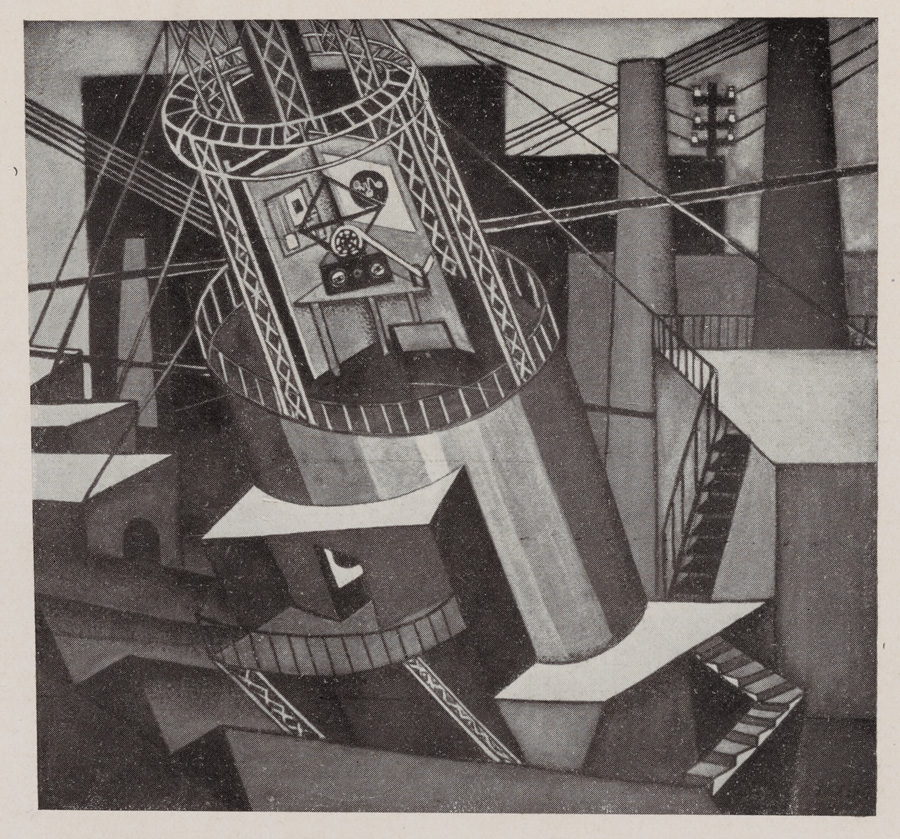 Vera Idelson, set design for Maschinenangst by Ruggero Vasari
From the Jan. 1925 issue of Der Sturm (Berlin)
Vera Idelson, set design for Maschinenangst by Ruggero Vasari
From the Jan. 1925 issue of Der Sturm (Berlin)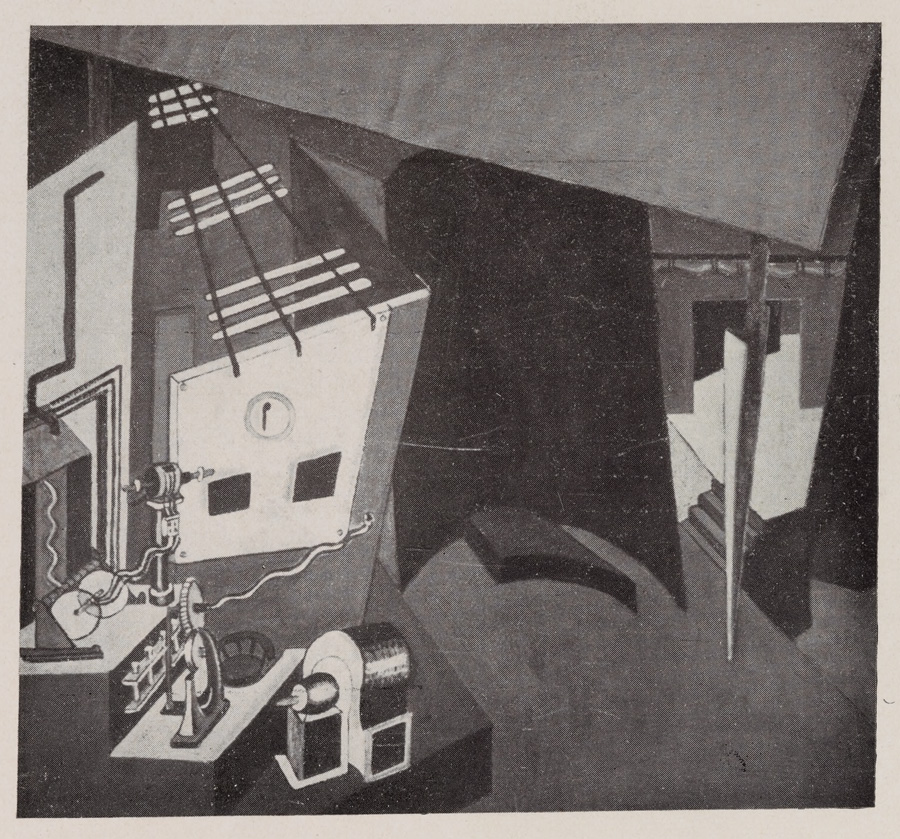 Vera Idelson, set design for Maschinenangst by Ruggero Vasari
From the Jan. 1925 issue of Der Sturm (Berlin)
Vera Idelson, set design for Maschinenangst by Ruggero Vasari
From the Jan. 1925 issue of Der Sturm (Berlin)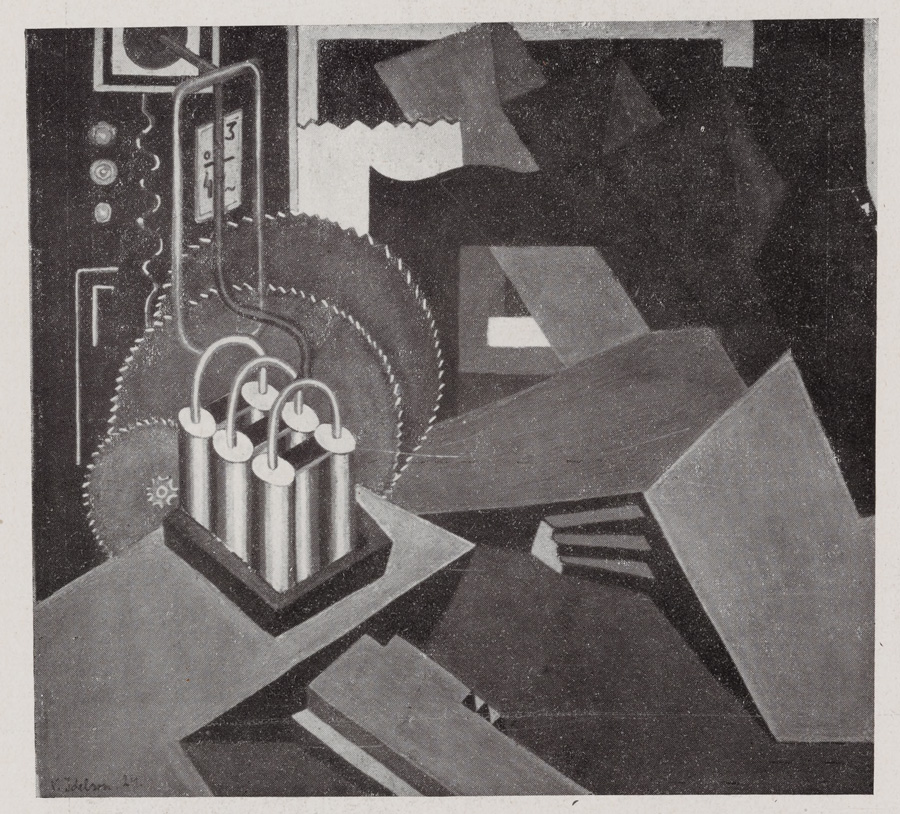 Vera Idelson, set design for Maschinenangst by Ruggero Vasari
From the Jan. 1925 issue of Der Sturm (Berlin)
Putting together this post I came across these illustrations for the first Italian book edition.
Vera Idelson, set design for Maschinenangst by Ruggero Vasari
From the Jan. 1925 issue of Der Sturm (Berlin)
Putting together this post I came across these illustrations for the first Italian book edition.
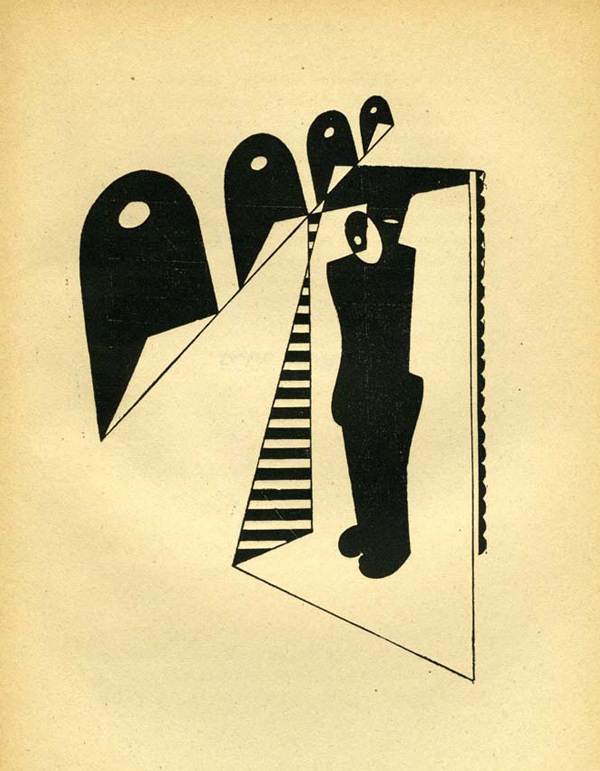 Enrico Prampolini, illustration for La mascherata degli impotenti, 1923 via
Enrico Prampolini, illustration for La mascherata degli impotenti, 1923 via 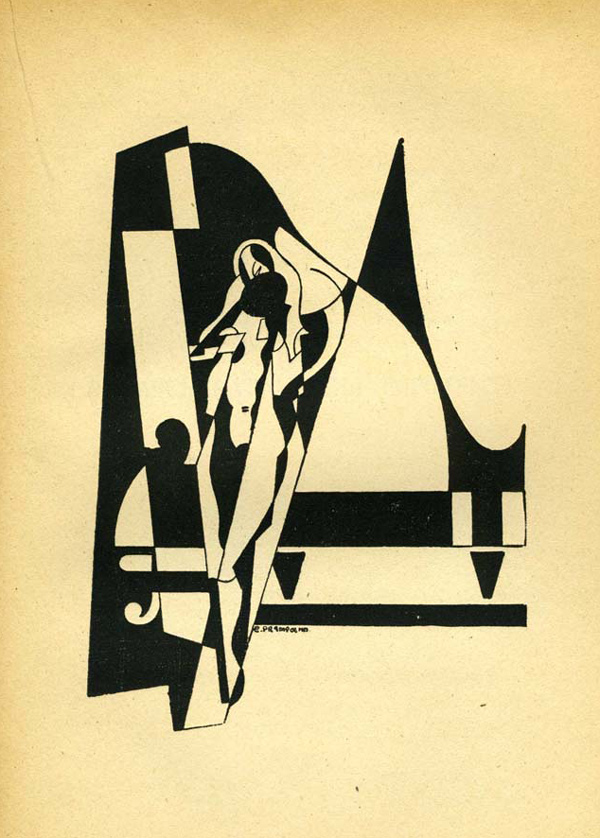 Enrico Prampolini, illustration for La mascherata degli impotenti, 1923 via
Previously: Mummy Was A Robot, Daddy Was A Small Non-Stick Kitchen Utensil
This post first appeared on February 6, 2014 on 50 Watts
Enrico Prampolini, illustration for La mascherata degli impotenti, 1923 via
Previously: Mummy Was A Robot, Daddy Was A Small Non-Stick Kitchen Utensil
This post first appeared on February 6, 2014 on 50 Watts
 Boris Messerer, 1972
I bought this small vintage postcard set last year on a tip from my pal OvO.
Laboriously typing on a cyrillic keyboard (once again), I identified the artist as the famous set design Boris Messerer (Борис Мессерер). Here's a bio from pravda.ru:[Messerer] has been making scenery for plays staged in Moscow's best-known theaters and theaters in other Russian cities since 1960. Specialists call him one of the few successors of the classical theater-scenery art.
Messerer also worked a lot for TV and made brilliant book illustrations. In 1980, together with his wife, outstanding poetess Bella Akhmadulina, he took part in the publication of the well-known opposition magazine Metropol.
Boris Messerer is a corresponding member of the Russian Academy of Arts. He has been awarded the title of People's Artist of the Russian Federation and is a winner of the Russian State Prize.
I put a handful of his paintings and set designs on the 50 Watts tumblr.
Read about skomorokhs (скоморох) at wikipedia and at Russia IC, who write, "Skomorokhi were the wandering minstrels of ancient Russia; they were singers, jesters, musicians, play performers, acrobats and animal trainers. But first of all skomorokhi were singers of freedom, who dared to ridicule the power, the clergy, and the rich and sympathized with the common people."
Boris Messerer, 1972
I bought this small vintage postcard set last year on a tip from my pal OvO.
Laboriously typing on a cyrillic keyboard (once again), I identified the artist as the famous set design Boris Messerer (Борис Мессерер). Here's a bio from pravda.ru:[Messerer] has been making scenery for plays staged in Moscow's best-known theaters and theaters in other Russian cities since 1960. Specialists call him one of the few successors of the classical theater-scenery art.
Messerer also worked a lot for TV and made brilliant book illustrations. In 1980, together with his wife, outstanding poetess Bella Akhmadulina, he took part in the publication of the well-known opposition magazine Metropol.
Boris Messerer is a corresponding member of the Russian Academy of Arts. He has been awarded the title of People's Artist of the Russian Federation and is a winner of the Russian State Prize.
I put a handful of his paintings and set designs on the 50 Watts tumblr.
Read about skomorokhs (скоморох) at wikipedia and at Russia IC, who write, "Skomorokhi were the wandering minstrels of ancient Russia; they were singers, jesters, musicians, play performers, acrobats and animal trainers. But first of all skomorokhi were singers of freedom, who dared to ridicule the power, the clergy, and the rich and sympathized with the common people."
 Boris Messerer, 1972
Boris Messerer, 1972 Boris Messerer, 1972
Boris Messerer, 1972 Boris Messerer, 1972
Boris Messerer, 1972 Boris Messerer, 1972
Boris Messerer, 1972 Boris Messerer, 1972
Boris Messerer, 1972 Boris Messerer, 1972
Boris Messerer, 1972 Boris Messerer, 1972
Boris Messerer, 1972 Boris Messerer, 1972
The artist at work:
Boris Messerer, 1972
The artist at work:
 "Boris Messerer paints a portrait of his wife, the famous poet Bella Akhmadulina (circa 1980s)" via marxists.org
See all posts tagged Russia
"Boris Messerer paints a portrait of his wife, the famous poet Bella Akhmadulina (circa 1980s)" via marxists.org
See all posts tagged Russia
 The scans come from the Bibliothèque nationale de France.
A previously-covered Cotsen exhibit says about the book:Insects stand in for people in this highly fanciful French alphabet. In addition to weight-lifting or parading down the boulevard, they file into church, ice skate, duel, dance, sail, paint, serenade a lover or invite her to dance, and, of course, improve their minds reading.
Hetzel was one of the most important publishers of children's books in late nineteenth-century France, whose publications were distinguished by their handsome gold-stamped cloth bindings and excellent illustrations.
You can see covers Meaulle (fr.wiki) did for Le Petit Journal here.
Also see:
Ready or Not, Here I Come
Insect Stories from Estonia
Eskimo Grasshoppers
Birds, Beret, and Butterflies
The scans come from the Bibliothèque nationale de France.
A previously-covered Cotsen exhibit says about the book:Insects stand in for people in this highly fanciful French alphabet. In addition to weight-lifting or parading down the boulevard, they file into church, ice skate, duel, dance, sail, paint, serenade a lover or invite her to dance, and, of course, improve their minds reading.
Hetzel was one of the most important publishers of children's books in late nineteenth-century France, whose publications were distinguished by their handsome gold-stamped cloth bindings and excellent illustrations.
You can see covers Meaulle (fr.wiki) did for Le Petit Journal here.
Also see:
Ready or Not, Here I Come
Insect Stories from Estonia
Eskimo Grasshoppers
Birds, Beret, and Butterflies






















 See all posts tagged "France" on 50 Watts
See all posts tagged "France" on 50 Watts
 Google translates the title as "Do You Feel that Way?"
Read more about Vello Vinn in a previous post and see all my posts of his work here.
Helvi Jürisson (b. 1928) is an Estonian poet and translator who also published many books in verse for children.
Google translates the title as "Do You Feel that Way?"
Read more about Vello Vinn in a previous post and see all my posts of his work here.
Helvi Jürisson (b. 1928) is an Estonian poet and translator who also published many books in verse for children.

 (I've definitely felt this way)
(I've definitely felt this way) (but maybe not this way)
(but maybe not this way)












 Estonian art and illustration on 50 Watts
This post first appeared on February 11, 2014 on 50 Watts
Estonian art and illustration on 50 Watts
This post first appeared on February 11, 2014 on 50 Watts
 Push Comes to Shove (1970)
see the original post on Jell-o Biafra Says
Push Comes to Shove (1970)
see the original post on Jell-o Biafra Says A Survey of Chemical and Biological Warfare (1969)
see the original post on Jell-o Biafra Says
A Survey of Chemical and Biological Warfare (1969)
see the original post on Jell-o Biafra Says The Nature of Violent Storms
Anchor Science Study Series paperbacks (1959-1961)
cover designs by George Giusti
see the original post on Jell-o Biafra Says
The Nature of Violent Storms
Anchor Science Study Series paperbacks (1959-1961)
cover designs by George Giusti
see the original post on Jell-o Biafra Says Two Novels by Nathaniel West (1971 ed.)
Cover design by Ellen Raskin
see the original post on Jell-o Biafra Says
Two Novels by Nathaniel West (1971 ed.)
Cover design by Ellen Raskin
see the original post on Jell-o Biafra Says Interstellar Communication: Scientific Perspectives (1974)
see the original post on Jell-o Biafra Says
Interstellar Communication: Scientific Perspectives (1974)
see the original post on Jell-o Biafra Says Nihilists (1969 ed.)
see the original post on Jell-o Biafra Says
Nihilists (1969 ed.)
see the original post on Jell-o Biafra Says Iron Men and their Dogs (1941)
see the original post on Jell-o Biafra Says
Iron Men and their Dogs (1941)
see the original post on Jell-o Biafra Says Threepenny Novel (1960 ed.)
see the original post on Jell-o Biafra Says
Also see my Oct. 2012 post on the rororo series
Threepenny Novel (1960 ed.)
see the original post on Jell-o Biafra Says
Also see my Oct. 2012 post on the rororo series The Sound of the Mountain (1974 ed.)
Cover illustration by Barney Wan
see the original post on Jell-o Biafra Says
The Sound of the Mountain (1974 ed.)
Cover illustration by Barney Wan
see the original post on Jell-o Biafra Says The Leper King (1957)
see the original post on Jell-o Biafra Says
The Leper King (1957)
see the original post on Jell-o Biafra Says Britain at War (1941)
signed McKnight Kauffer [E. McKnight Kauffer on 50 Watts]
see the original post on Jell-o Biafra Says
Britain at War (1941)
signed McKnight Kauffer [E. McKnight Kauffer on 50 Watts]
see the original post on Jell-o Biafra Says Malone Dies (1956) [looks like a Kuhlman]
see the original post on Jell-o Biafra Says
Malone Dies (1956) [looks like a Kuhlman]
see the original post on Jell-o Biafra Says The Human Use of Human Beings (1954 ed.)
Cover design by George Giusti
see the original post on Jell-o Biafra Says
The Human Use of Human Beings (1954 ed.)
Cover design by George Giusti
see the original post on Jell-o Biafra Says Management Thinkers (1970)
see the original post on Jell-o Biafra Says
Management Thinkers (1970)
see the original post on Jell-o Biafra Says Discourse on Thinking (1969 ed.)
Cover design by Roger Hane
see the original post on Jell-o Biafra Says
Discourse on Thinking (1969 ed.)
Cover design by Roger Hane
see the original post on Jell-o Biafra Says Printing (1948), illustrated by Jack Brough)
see the original post on Jell-o Biafra Says
Printing (1948), illustrated by Jack Brough)
see the original post on Jell-o Biafra Says Design as Art (1971 ed.)
Cover illustration by Bruno Munari
see the original post on Jell-o Biafra Says
Design as Art (1971 ed.)
Cover illustration by Bruno Munari
see the original post on Jell-o Biafra Says The Last and First Men / Last Men in London (1973 ed.)
Cover design by David Pelham
see the original post on Jell-o Biafra Says
The Last and First Men / Last Men in London (1973 ed.)
Cover design by David Pelham
see the original post on Jell-o Biafra Says The Sioux Spaceman (1960)
see the original post on Jell-o Biafra Says
The Sioux Spaceman (1960)
see the original post on Jell-o Biafra Says Birds of New Jersey (1999)
see the original post on Jell-o Biafra Says
Birds of New Jersey (1999)
see the original post on Jell-o Biafra Says Turtle Geometry (1984 ed.)
see the original post on Jell-o Biafra Says
Turtle Geometry (1984 ed.)
see the original post on Jell-o Biafra Says Digital Computer System Principles (1967)
see the original post on Jell-o Biafra Says
Digital Computer System Principles (1967)
see the original post on Jell-o Biafra Says Chemistry and You (1957)
see the original post on Jell-o Biafra Says
Chemistry and You (1957)
see the original post on Jell-o Biafra Says The Advance of the Fungi (1962 ed.)
see the original post on Jell-o Biafra Says
The Advance of the Fungi (1962 ed.)
see the original post on Jell-o Biafra Says Automation (1965) vs Automation (1966)
Automation (1965) vs Automation (1966) Marine Society bookplate
see the original post on Jell-o Biafra Says
Marine Society bookplate
see the original post on Jell-o Biafra Says James Scott Memorial Fountain, Belle Isle Park, Detroit (postcard, c1930s) -- "different days" as Joe says
see the original post on Jell-o Biafra Says
James Scott Memorial Fountain, Belle Isle Park, Detroit (postcard, c1930s) -- "different days" as Joe says
see the original post on Jell-o Biafra Says Feather image representing Kukailimoku, god of war (postcard, n.d.)
see the original post on Jell-o Biafra Says
Feather image representing Kukailimoku, god of war (postcard, n.d.)
see the original post on Jell-o Biafra Says "Facial expressions in different motivational contexts"
from Understanding Your Cat (1977 ed.)
see the original post on Jell-o Biafra Says
Previously: Stacks of Books Crushing Me one and two
See all book cover posts on 50 Watts
This post first appeared on February 12, 2014 on 50 Watts
"Facial expressions in different motivational contexts"
from Understanding Your Cat (1977 ed.)
see the original post on Jell-o Biafra Says
Previously: Stacks of Books Crushing Me one and two
See all book cover posts on 50 Watts
This post first appeared on February 12, 2014 on 50 Watts
 Antonio Rubino, "Quadratino" comic, Corriere dei Piccoli, 1910, panel
This is my fourth post—with many more in the works—on the great Italian illustrator Antonio Rubino (1880–1964). The scans come from Antonio Rubino: Gli anni del Corriere dei Piccoli (Black Velvet Editrice, 2009), which focuses on Rubino's comics for the Corriere dei Piccoli, a children's supplement to a big daily Italian newspaper.
Here are some links:
—post at Lambiek.com
—Comics from Coconino-World.com
—In the Nursery of Good and Evil
—kid's room decorated by Rubino
See all posts on Rubino
Antonio Rubino, "Quadratino" comic, Corriere dei Piccoli, 1910, panel
This is my fourth post—with many more in the works—on the great Italian illustrator Antonio Rubino (1880–1964). The scans come from Antonio Rubino: Gli anni del Corriere dei Piccoli (Black Velvet Editrice, 2009), which focuses on Rubino's comics for the Corriere dei Piccoli, a children's supplement to a big daily Italian newspaper.
Here are some links:
—post at Lambiek.com
—Comics from Coconino-World.com
—In the Nursery of Good and Evil
—kid's room decorated by Rubino
See all posts on Rubino
 Antonio Rubino, "Quadratino" comic, Corriere dei Piccoli, 1910
Italo Calvino, from the "Visibility" chapter of Six Memos for the Next Millennium
In my own development, I was already a child of the ‘civilization of images,’ even if this was still in its infancy and a far cry from the inflations of today. Let us say that I am a product of an intermediate period, when the colored illustrations that were our childhood companions, in books, weekly magazines, and toys, were very important to us. I think that being born during that period [Calvino was born in 1923] made a profound mark on my development. My imaginary world was first influenced by the illustrations in Corriere dei Piccoli, the most widely circulated weekly for children. I am speaking of my life between three and thirteen years of age, before a passion for the cinema became an absolute obsession, one that lasted all through my adolescence. In fact I believe that the really vital time was between three and six, before I learned to read.
In Italy in the twenties the Corriere dei piccoli used to publish the best-known American comic strips of the time: Happy Hooligan, the Katzenjammer Kids, Felix the Cat, Maggie and Jiggs, all of them rebaptized with Italian names. And there were also Italian comic strips, some of them of excellent quality, according to the graphic taste and style of the period…I used to live with this little magazine, which my mother had begun buying and collecting even before I was born and had bound into volumes year by year. I would spend hours following the cartoons of each series from one issue to another, while in my mind I told myself the stories, interpreting the scenes in different ways—I produced variants, put together the single episodes into a story of broader scope, thought out and isolated and then connected the recurring elements in each series, mixing up one series with another, and invented new series in which the secondary characters became protagonists. […] Reading the pictures without words was certainly a schooling in fable-making, in stylization, in the composition of the image.
Antonio Rubino, "Quadratino" comic, Corriere dei Piccoli, 1910
Italo Calvino, from the "Visibility" chapter of Six Memos for the Next Millennium
In my own development, I was already a child of the ‘civilization of images,’ even if this was still in its infancy and a far cry from the inflations of today. Let us say that I am a product of an intermediate period, when the colored illustrations that were our childhood companions, in books, weekly magazines, and toys, were very important to us. I think that being born during that period [Calvino was born in 1923] made a profound mark on my development. My imaginary world was first influenced by the illustrations in Corriere dei Piccoli, the most widely circulated weekly for children. I am speaking of my life between three and thirteen years of age, before a passion for the cinema became an absolute obsession, one that lasted all through my adolescence. In fact I believe that the really vital time was between three and six, before I learned to read.
In Italy in the twenties the Corriere dei piccoli used to publish the best-known American comic strips of the time: Happy Hooligan, the Katzenjammer Kids, Felix the Cat, Maggie and Jiggs, all of them rebaptized with Italian names. And there were also Italian comic strips, some of them of excellent quality, according to the graphic taste and style of the period…I used to live with this little magazine, which my mother had begun buying and collecting even before I was born and had bound into volumes year by year. I would spend hours following the cartoons of each series from one issue to another, while in my mind I told myself the stories, interpreting the scenes in different ways—I produced variants, put together the single episodes into a story of broader scope, thought out and isolated and then connected the recurring elements in each series, mixing up one series with another, and invented new series in which the secondary characters became protagonists. […] Reading the pictures without words was certainly a schooling in fable-making, in stylization, in the composition of the image.
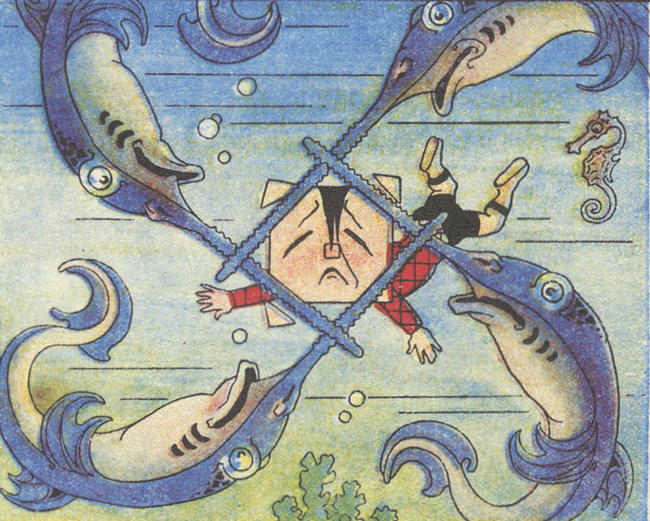 Antonio Rubino, "Quadratino" comic, Corriere dei Piccoli, 1910, panel
Antonio Rubino, "Quadratino" comic, Corriere dei Piccoli, 1910, panel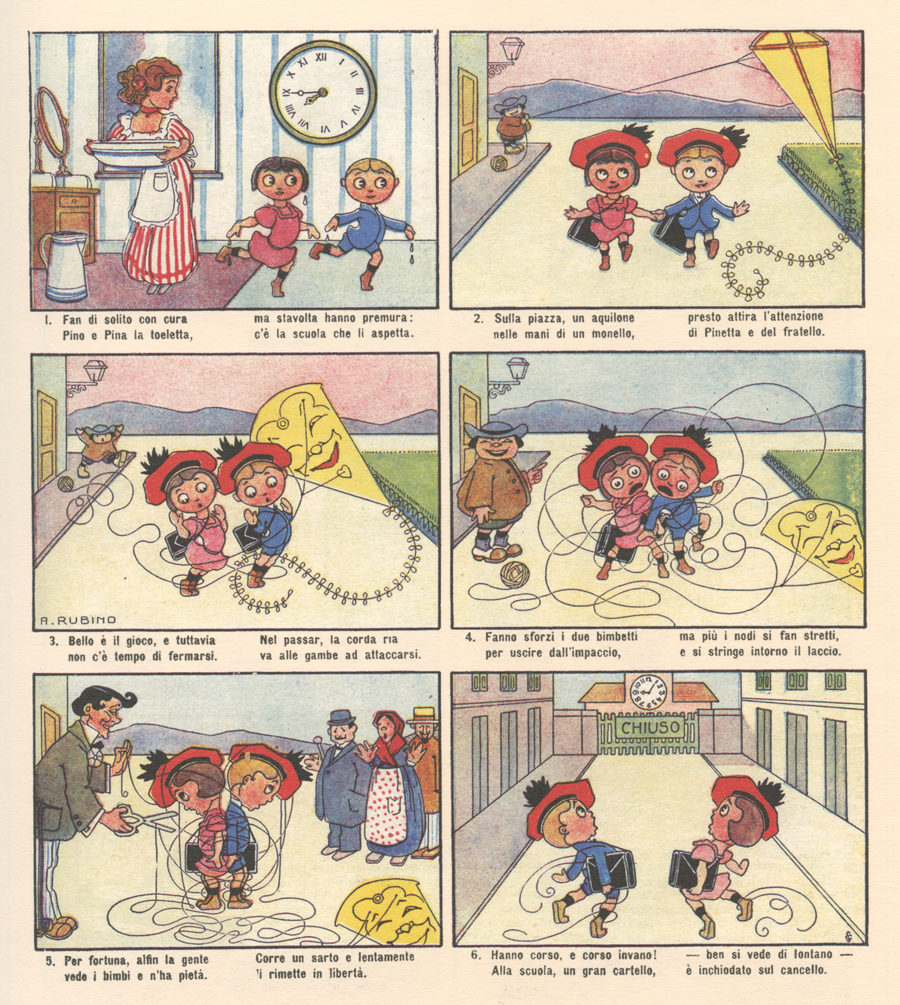 Antonio Rubino, "Pino e Pina" comic, Corriere dei Piccoli, 1910
Antonio Rubino, "Pino e Pina" comic, Corriere dei Piccoli, 1910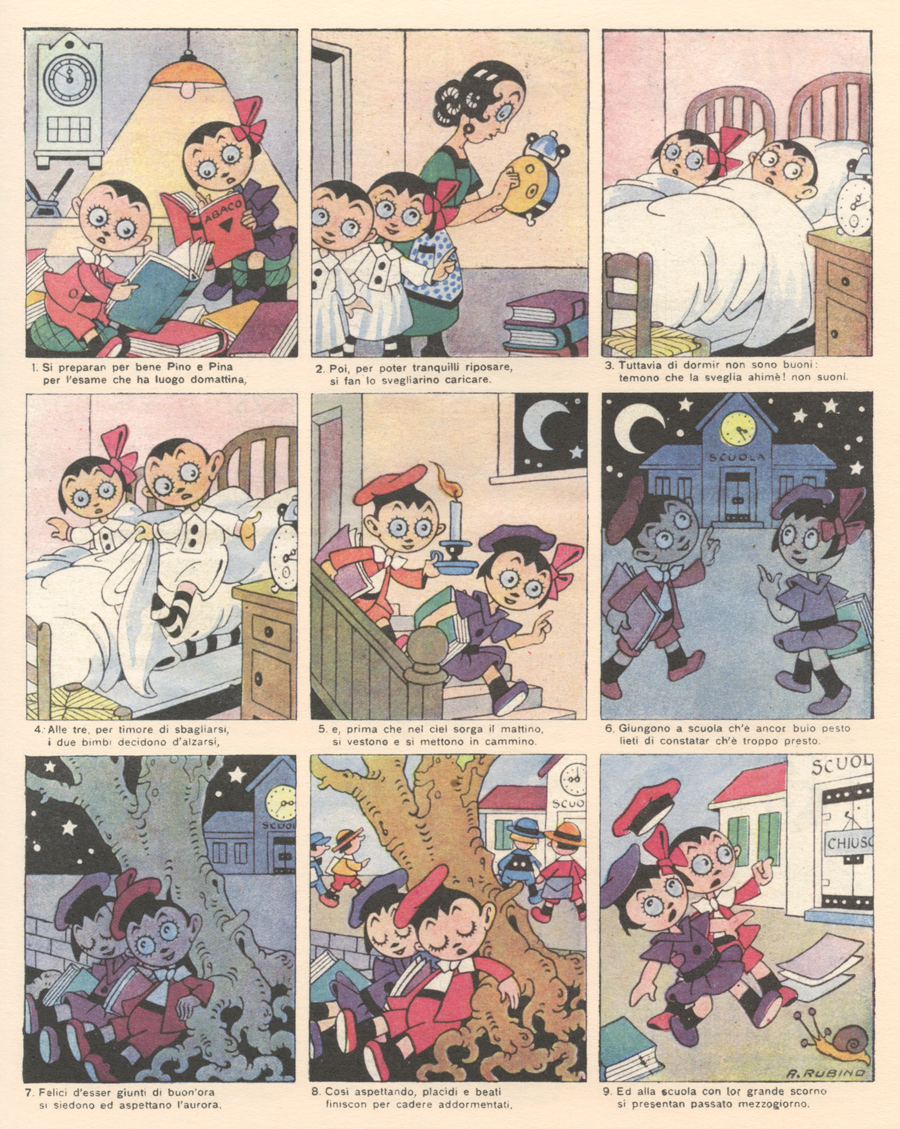 Antonio Rubino, "Pino e Pina" comic, Corriere dei Piccoli, 1926
Antonio Rubino, "Pino e Pina" comic, Corriere dei Piccoli, 1926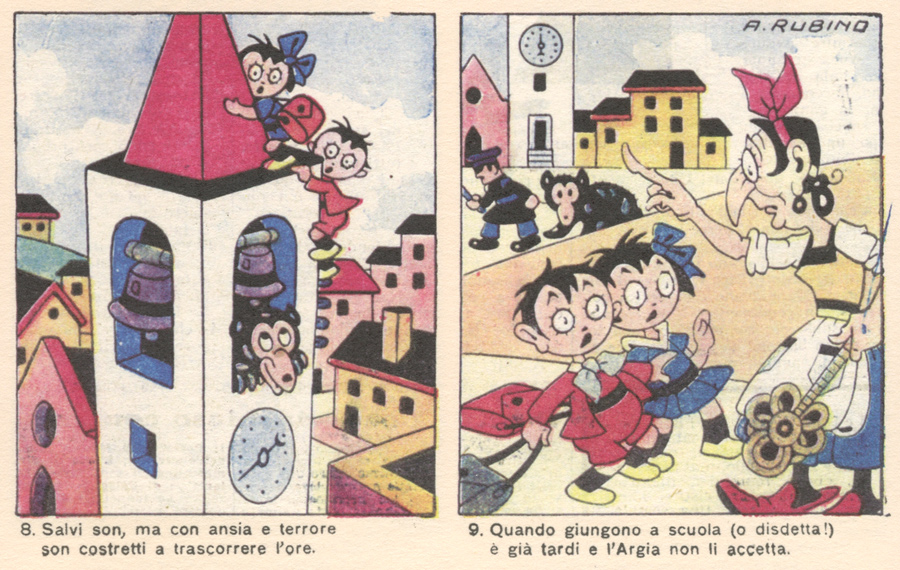 Antonio Rubino, "Pino e Pina" comic, Corriere dei Piccoli, 1926, panels
Antonio Rubino, "Pino e Pina" comic, Corriere dei Piccoli, 1926, panels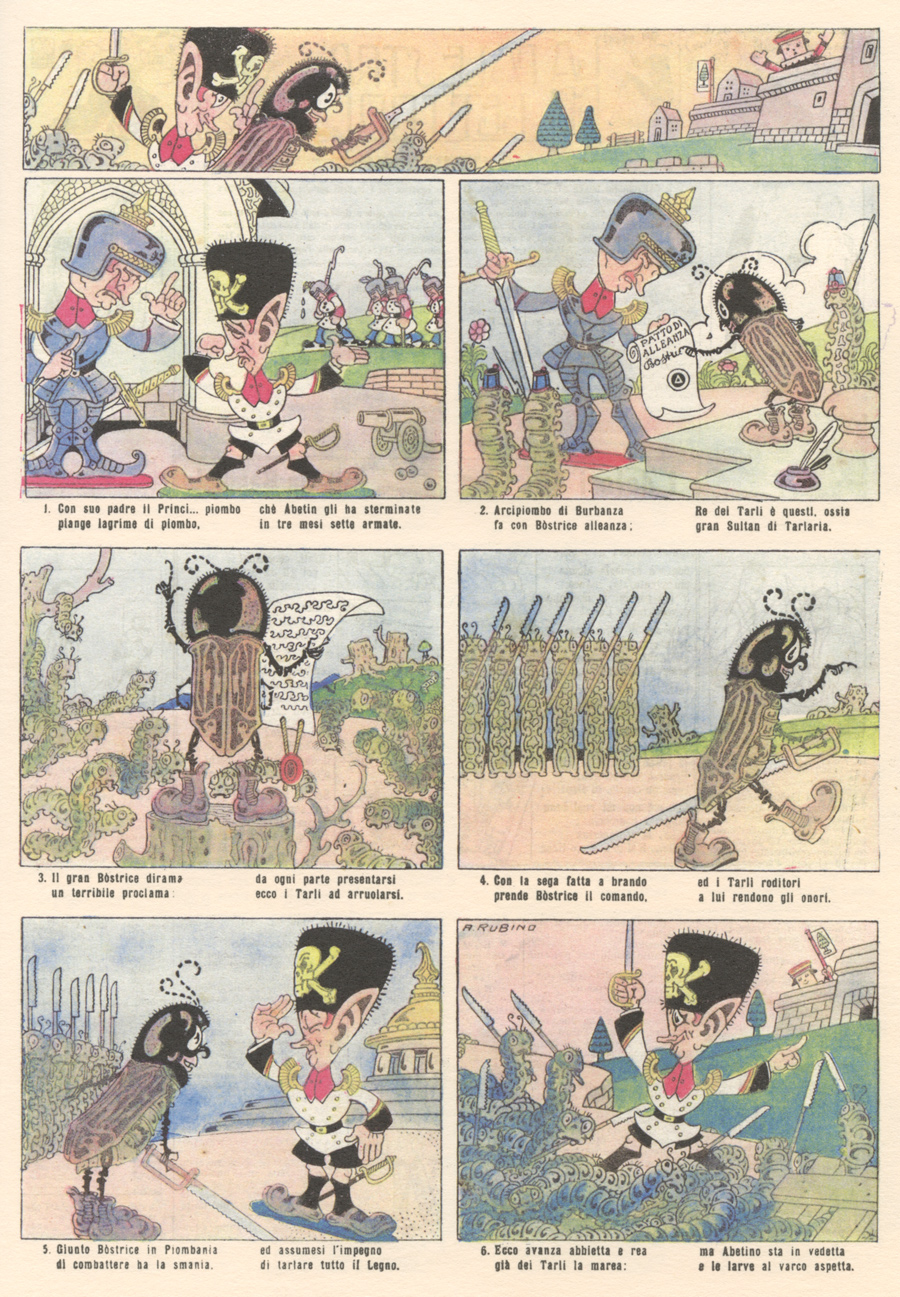 Antonio Rubino, "Piombino e Abetino" comic, Corriere dei Piccoli, 1917
Antonio Rubino, "Piombino e Abetino" comic, Corriere dei Piccoli, 1917 Antonio Rubino, "Piombino e Abetino" comic, Corriere dei Piccoli, 1917
Antonio Rubino, "Piombino e Abetino" comic, Corriere dei Piccoli, 1917 Antonio Rubino, "La Tradotta" comic, Corriere dei Piccoli, 1918
Most of the "La Tradotta" comics are double-page spreads (but just a single image like the above) and impossible to scan. They are damn cool, though.
Antonio Rubino, "La Tradotta" comic, Corriere dei Piccoli, 1918
Most of the "La Tradotta" comics are double-page spreads (but just a single image like the above) and impossible to scan. They are damn cool, though.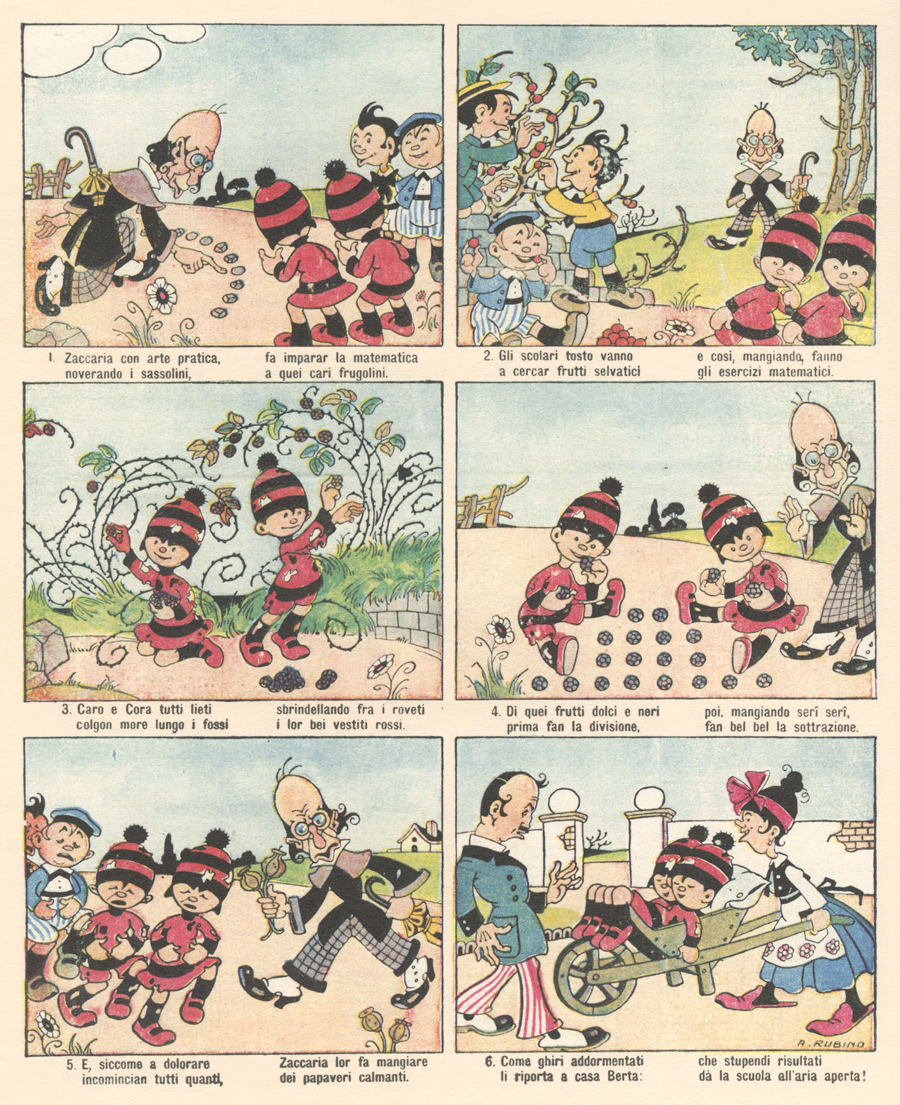 Antonio Rubino, "Caro e Cora" comic, Corriere dei Piccoli, 1919
Antonio Rubino, "Caro e Cora" comic, Corriere dei Piccoli, 1919 Antonio Rubino, "Lio e Dado" comic, Corriere dei Piccoli, 1934
Antonio Rubino, "Lio e Dado" comic, Corriere dei Piccoli, 1934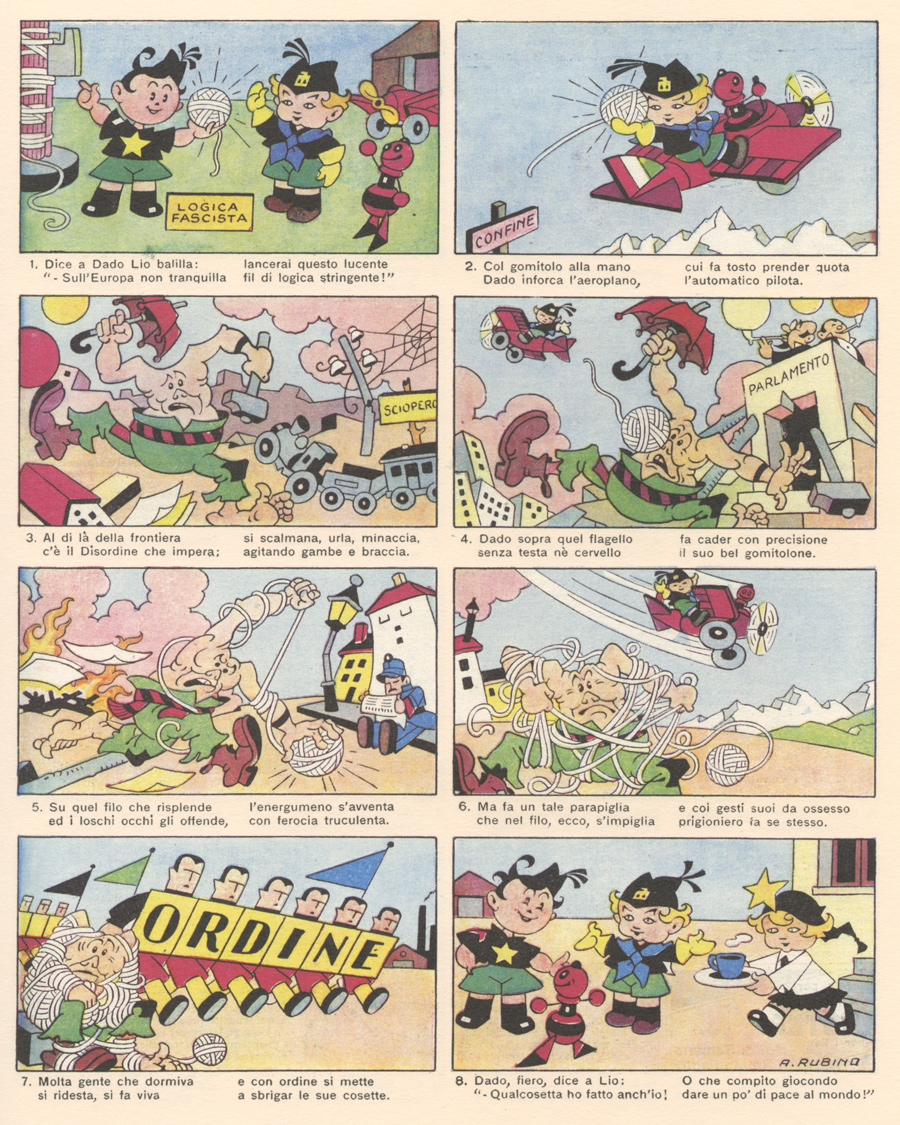 Antonio Rubino, "Lio e Dado" comic, Corriere dei Piccoli, 1934
When Rubino returned to Corriere dei Piccoli late in life, his work had pushed even further into eye-popping proto-psychedelia:
Antonio Rubino, "Lio e Dado" comic, Corriere dei Piccoli, 1934
When Rubino returned to Corriere dei Piccoli late in life, his work had pushed even further into eye-popping proto-psychedelia:
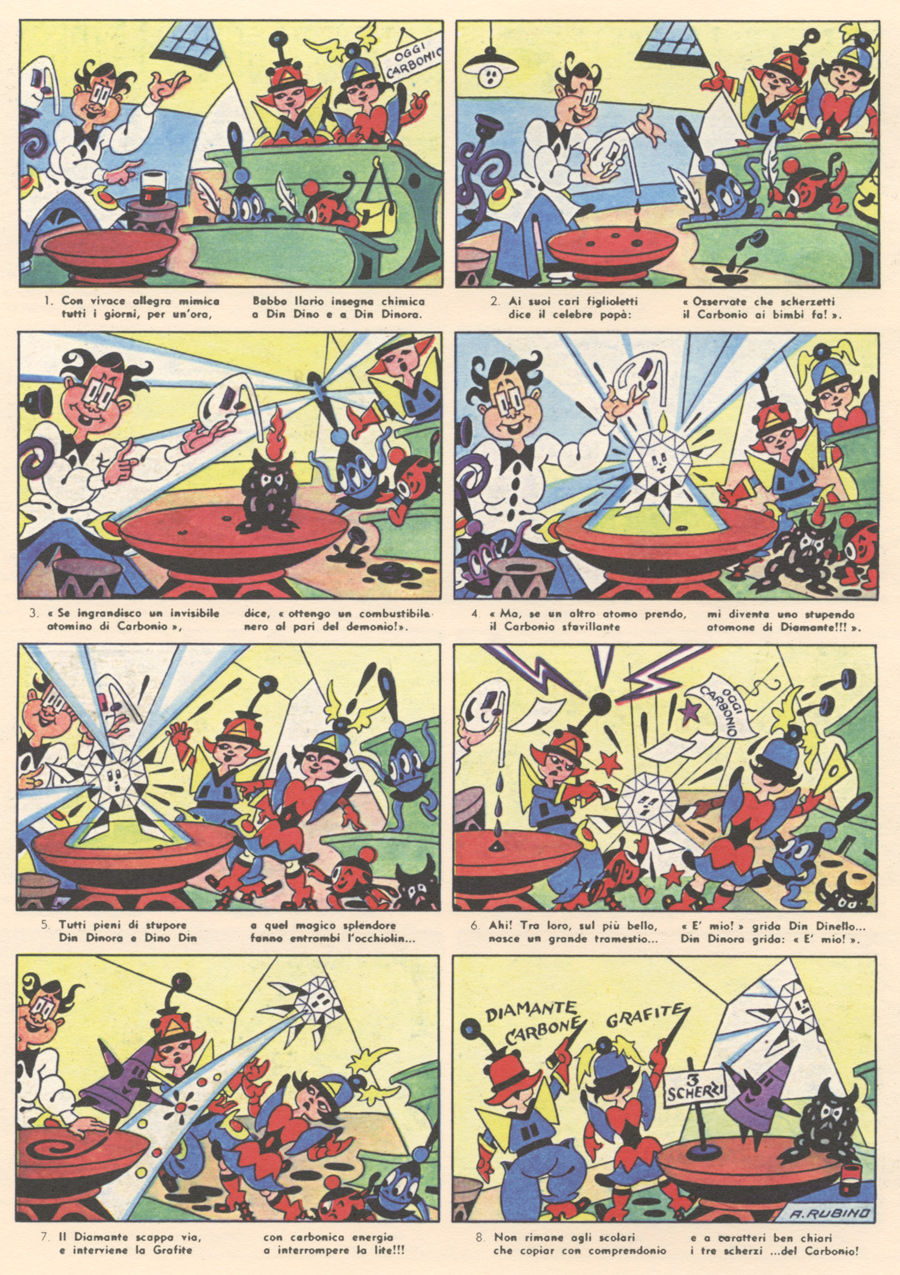 Antonio Rubino, "Dino Din e Din Dinora" comic, Corriere dei Piccoli, 1955
Antonio Rubino, "Dino Din e Din Dinora" comic, Corriere dei Piccoli, 1955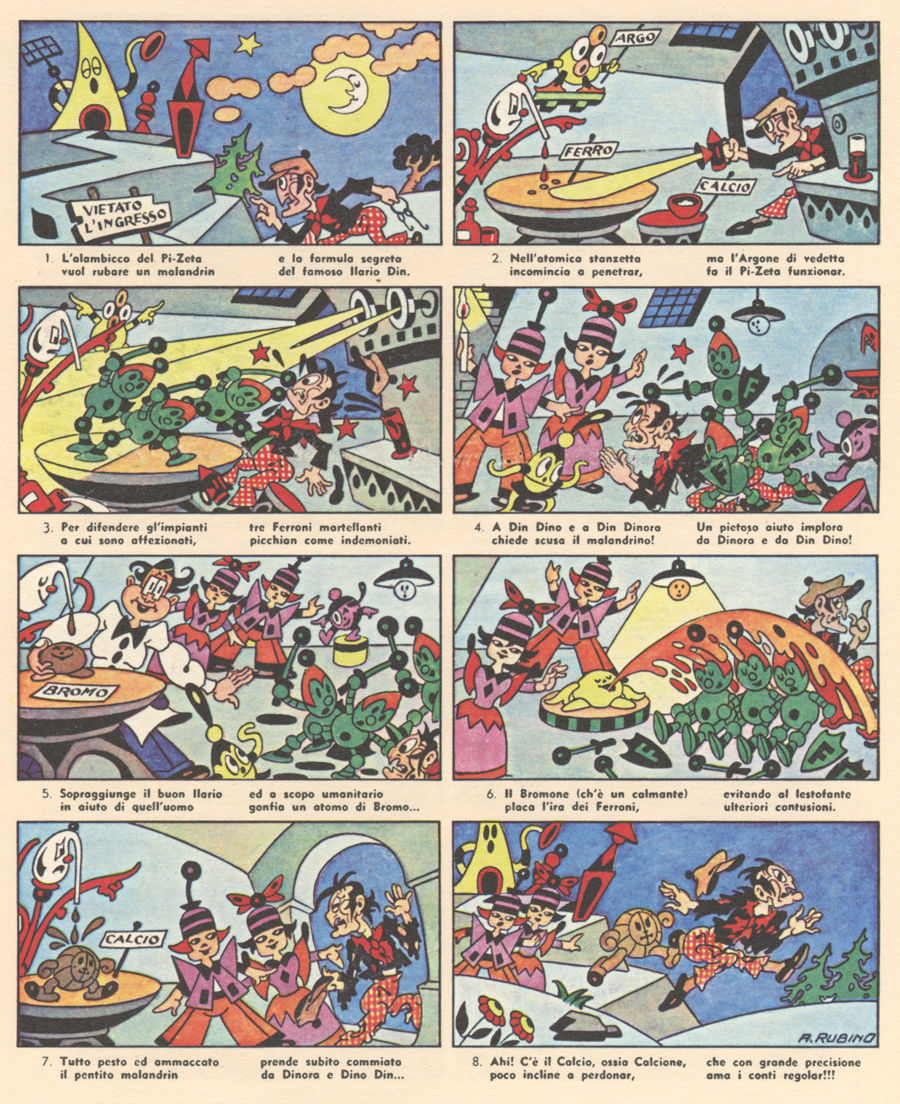 Antonio Rubino, "Dino Din e Din Dinora" comic, Corriere dei Piccoli, 1955
Antonio Rubino, "Dino Din e Din Dinora" comic, Corriere dei Piccoli, 1955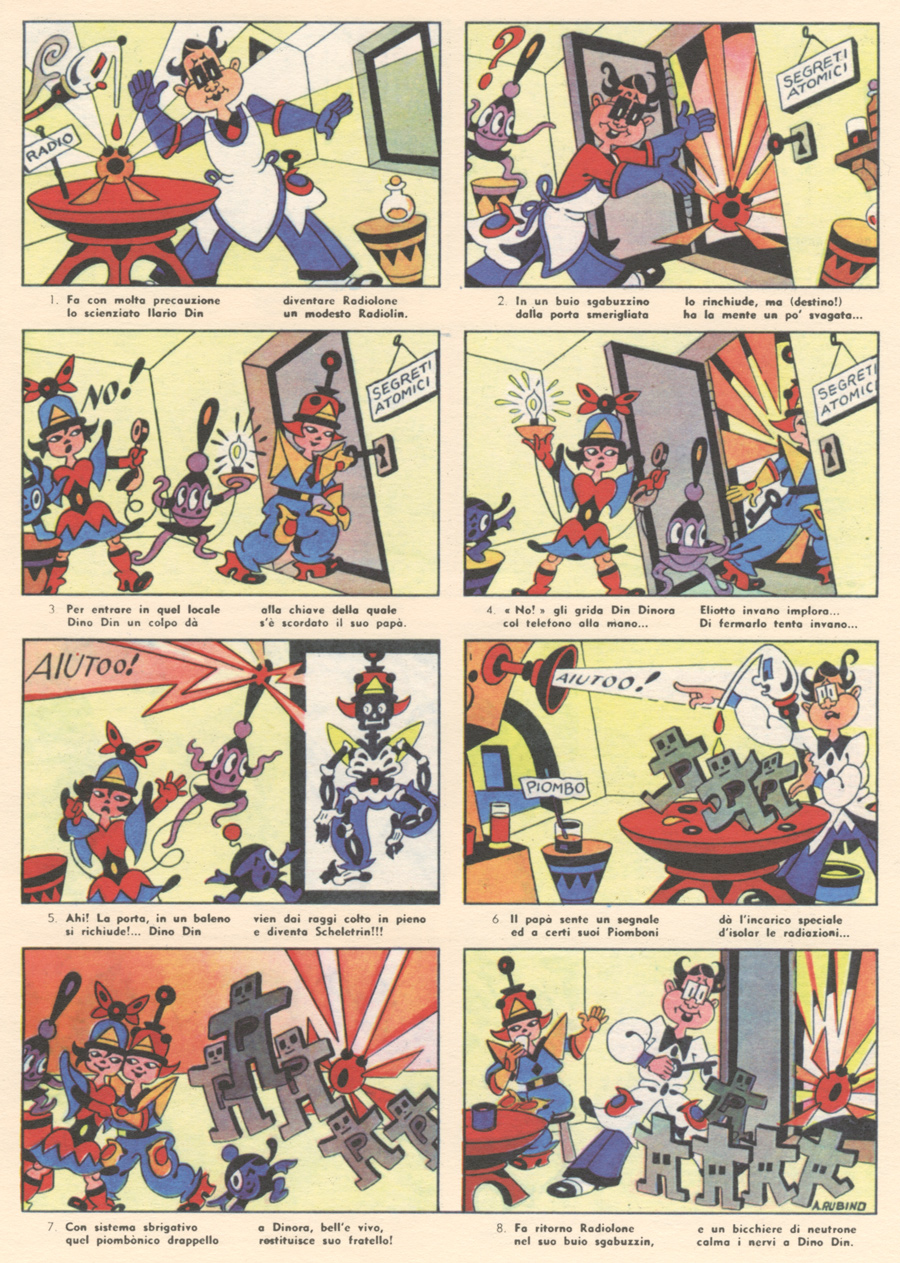 Antonio Rubino, "Dino Din e Din Dinora" comic, Corriere dei Piccoli, 1956
See all posts on Rubino
See all posts tagged "Italy"
This post first appeared on February 13, 2014 on 50 Watts
Antonio Rubino, "Dino Din e Din Dinora" comic, Corriere dei Piccoli, 1956
See all posts on Rubino
See all posts tagged "Italy"
This post first appeared on February 13, 2014 on 50 Watts
 1964
These scans are courtesy of Jimoto and his stunning site Dassaishooku. I hope to highlight a few more of his posts in the coming months.
Rokuro Taniuchi (or Roku, as he signed his paintings) is one of my favorite illustrators from any time and any place. Some of his work has been reprinted and is available from amazon.co.jp.
Previous posts on this artist
My note from the first post I did on Roku in October 2008:I discovered the incredible Japanese illustrator Rokuro Taniuchi (1921–81) while searching for Tadanori Yokoo books. On the Amazon listing for this profusely-illustrated book—Taniuchi Rokuro Gensouki (Shinshindo, 1981)—Yokoo is listed as the editor. The book seems to have disappeared from the face of the earth, and I feel incredibly lucky to have found it.
Through some creative googling of Japanese characters, I did manage to dig up an archive [link now dead]. Comparing the book to this site, I discovered that many of the images were originally made for the Weekly Shincho. I think others must surely be illustrations for children's books. The artist dated some of the works: late 40s / early 50s.
The book includes an insert promoting the "Unicorn Color Series." Has anyone heard of this series?
I plan to do another post from this book—it is too good not to share.
1964
These scans are courtesy of Jimoto and his stunning site Dassaishooku. I hope to highlight a few more of his posts in the coming months.
Rokuro Taniuchi (or Roku, as he signed his paintings) is one of my favorite illustrators from any time and any place. Some of his work has been reprinted and is available from amazon.co.jp.
Previous posts on this artist
My note from the first post I did on Roku in October 2008:I discovered the incredible Japanese illustrator Rokuro Taniuchi (1921–81) while searching for Tadanori Yokoo books. On the Amazon listing for this profusely-illustrated book—Taniuchi Rokuro Gensouki (Shinshindo, 1981)—Yokoo is listed as the editor. The book seems to have disappeared from the face of the earth, and I feel incredibly lucky to have found it.
Through some creative googling of Japanese characters, I did manage to dig up an archive [link now dead]. Comparing the book to this site, I discovered that many of the images were originally made for the Weekly Shincho. I think others must surely be illustrations for children's books. The artist dated some of the works: late 40s / early 50s.
The book includes an insert promoting the "Unicorn Color Series." Has anyone heard of this series?
I plan to do another post from this book—it is too good not to share.
 1968
1968 1973
1973 1956
1956 1963
1963 1969
1969 1978
1978 1977
1977 1981
1981 1972
1972 1960
1960 1958
1958 1970
1970 1972
1972 1975
1975 1979
1979 1980
1980 1964
1964 1965
1965 1967
1967 1962
1962 1976
1976 1977
1977 1976
1976 1961
Previous posts on this artist
This post first appeared on February 17, 2014 on 50 Watts
1961
Previous posts on this artist
This post first appeared on February 17, 2014 on 50 Watts
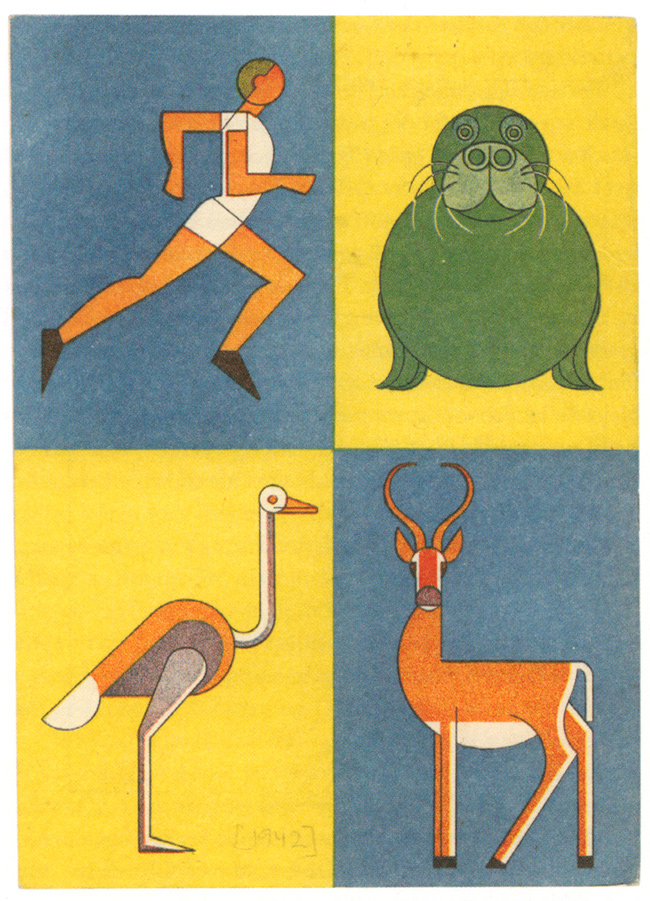 Hans Hauger, 1940s
Are Mokkelbost—whose incredible work I featured in 2009—tells me Norske Malebøker was designed by Yokoland (website / facebook), "an interesting group of designers/artists with many fine book releases." It was published in 2012 by Samlaget.
The illustrations here date from about 1920 to 1945.
Hans Hauger, 1940s
Are Mokkelbost—whose incredible work I featured in 2009—tells me Norske Malebøker was designed by Yokoland (website / facebook), "an interesting group of designers/artists with many fine book releases." It was published in 2012 by Samlaget.
The illustrations here date from about 1920 to 1945.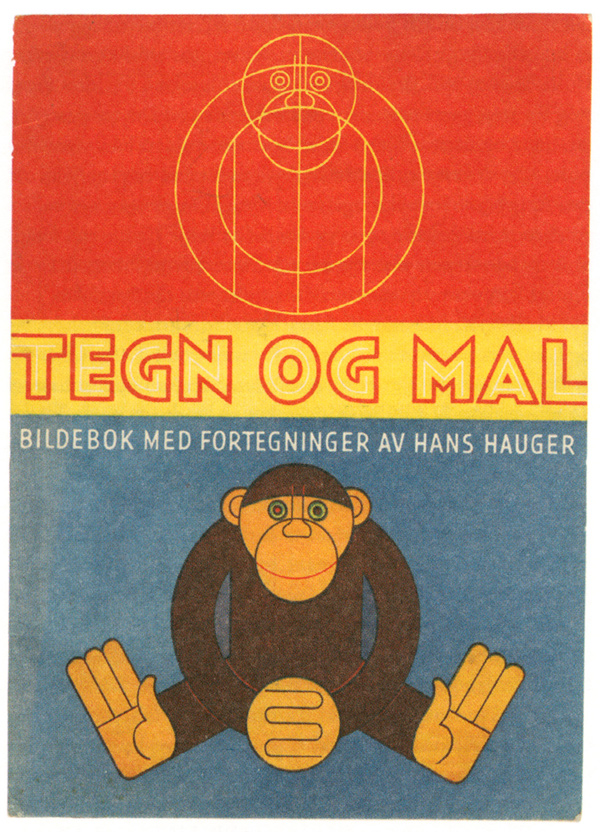 Hans Hauger, 1940s
Hans Hauger, 1940s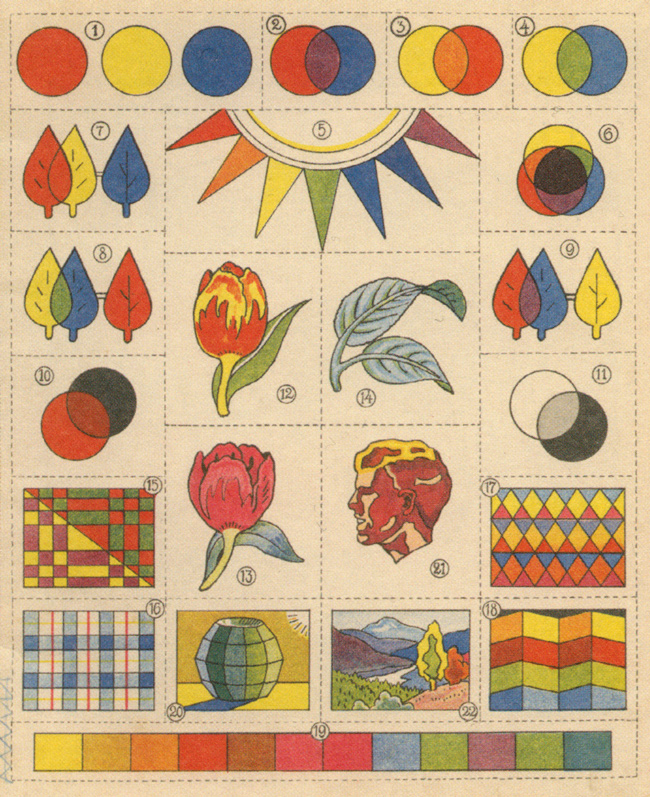 Paul Lillo-Stenberg, 1940s
Paul Lillo-Stenberg, 1940s Paul Lillo-Stenberg, 1940s
Paul Lillo-Stenberg, 1940s Marie Walle and Eyvin Ovrum, 1921
Marie Walle and Eyvin Ovrum, 1921 Marie Walle and Eyvin Ovrum, 1921
Marie Walle and Eyvin Ovrum, 1921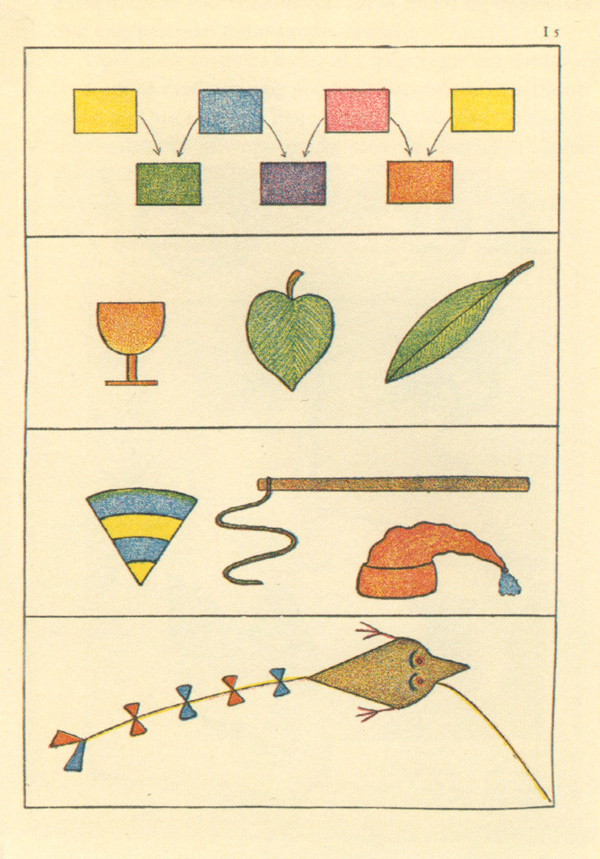 A. Tyrihjell, 1930s
A. Tyrihjell, 1930s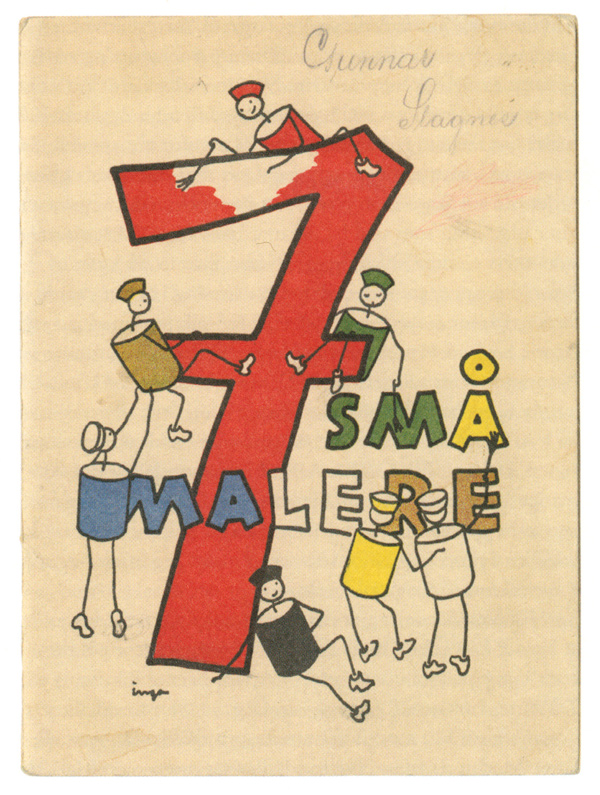 Inga Havig-Gjelseth, 1940s
Inga Havig-Gjelseth, 1940s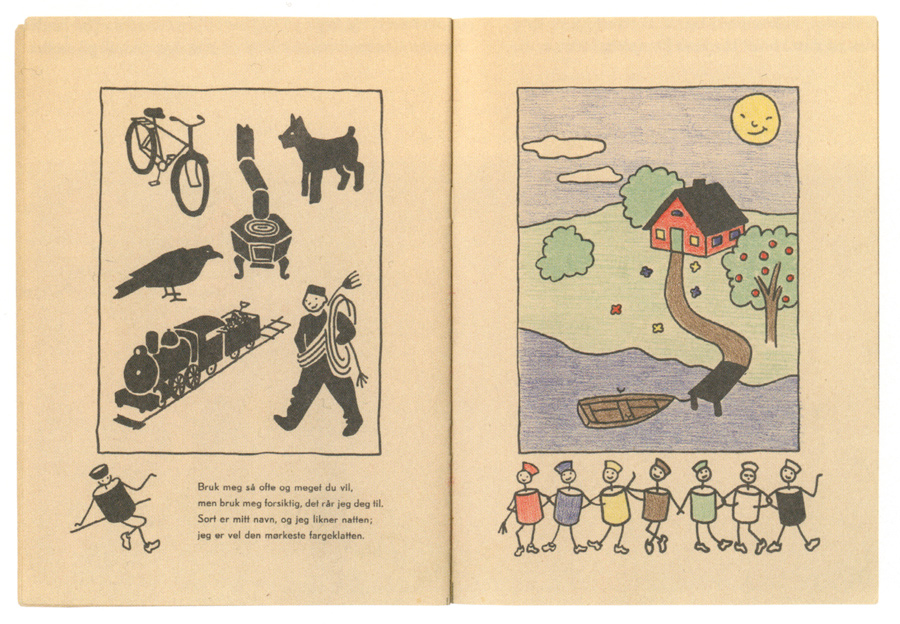 Inga Havig-Gjelseth, 1940s
Inga Havig-Gjelseth, 1940s Arne Johnson, around 1940
Arne Johnson, around 1940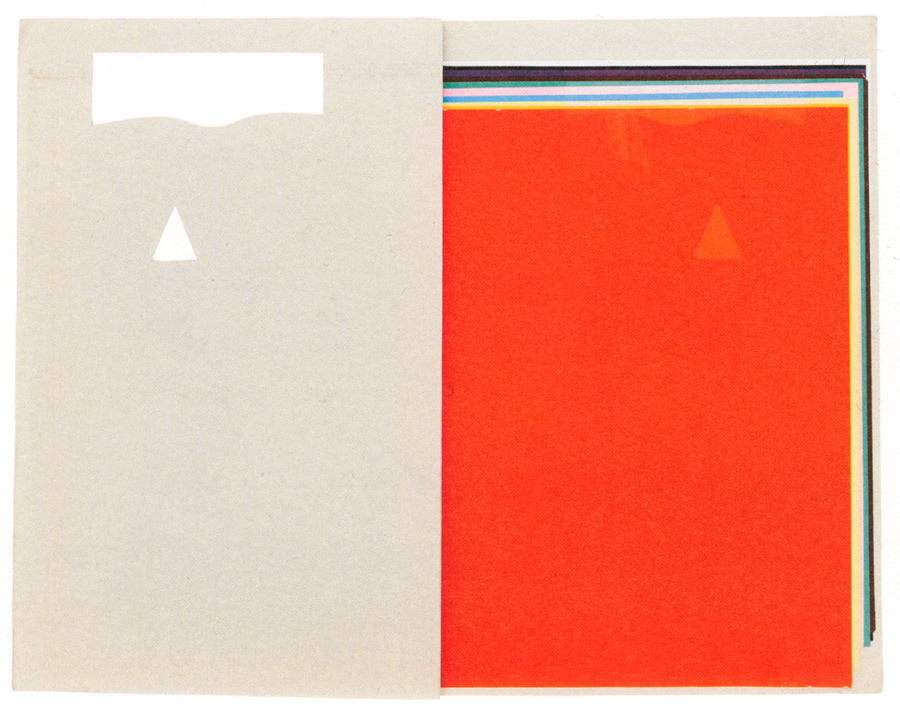 Arne Johnson, around 1940
Arne Johnson, around 1940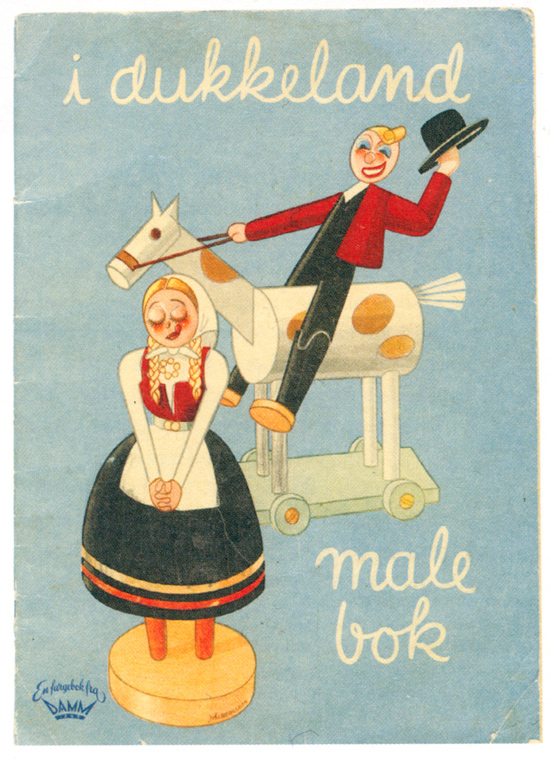
 Johs. Berggren, ca. 1940
Johs. Berggren, ca. 1940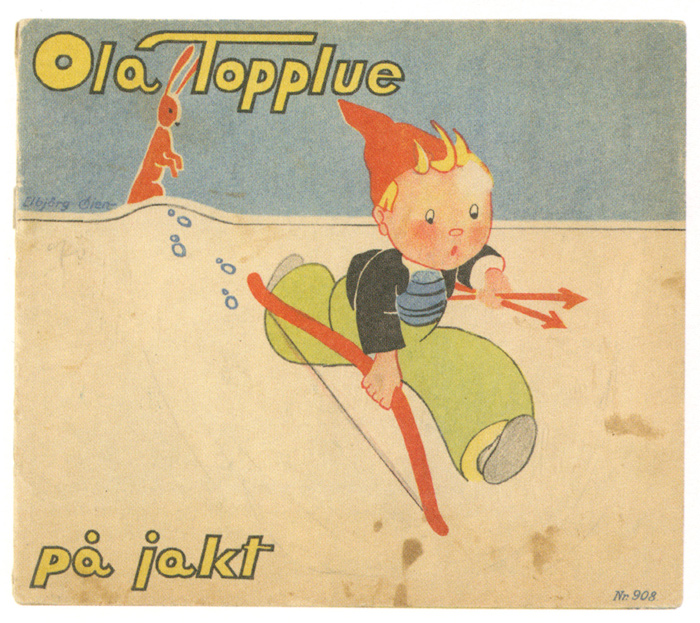 Elbjørg Øien Moum, 1930s
Elbjørg Øien Moum, 1930s
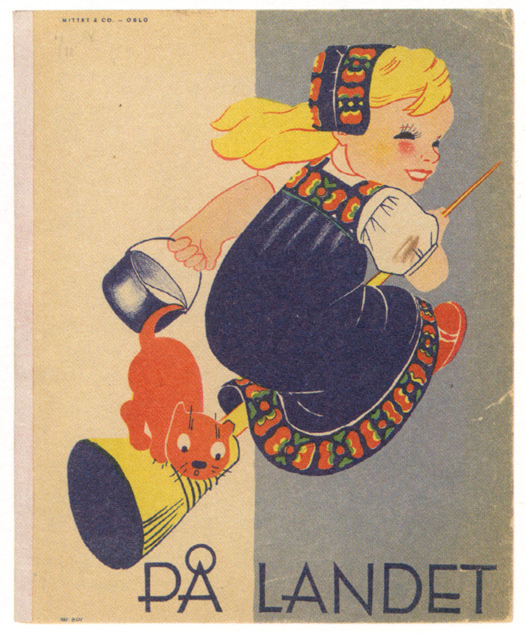 Elbjørg Øien Moum, 1930s
Elbjørg Øien Moum, 1930s
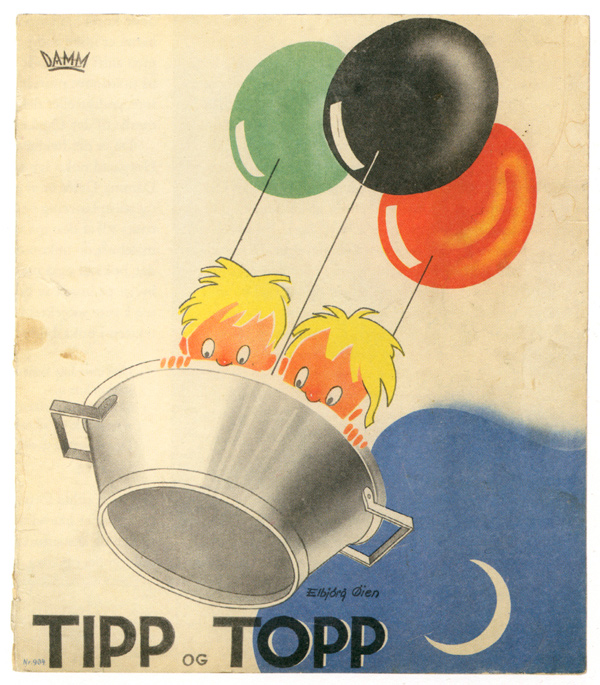 Elbjørg Øien Moum, 1930s
Elbjørg Øien Moum, 1930s
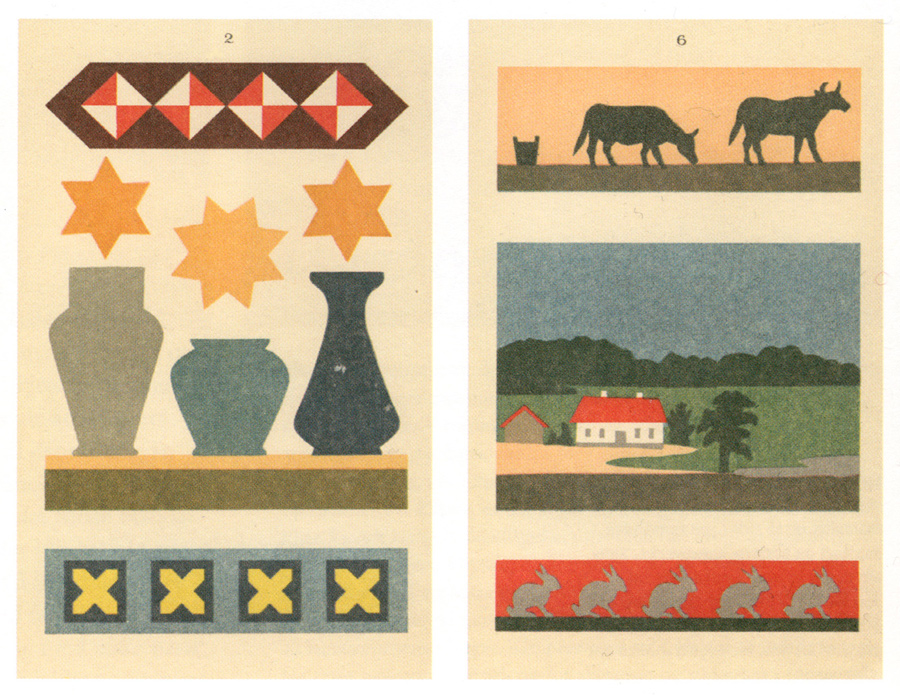 Augusta Sand, 1911
Augusta Sand, 1911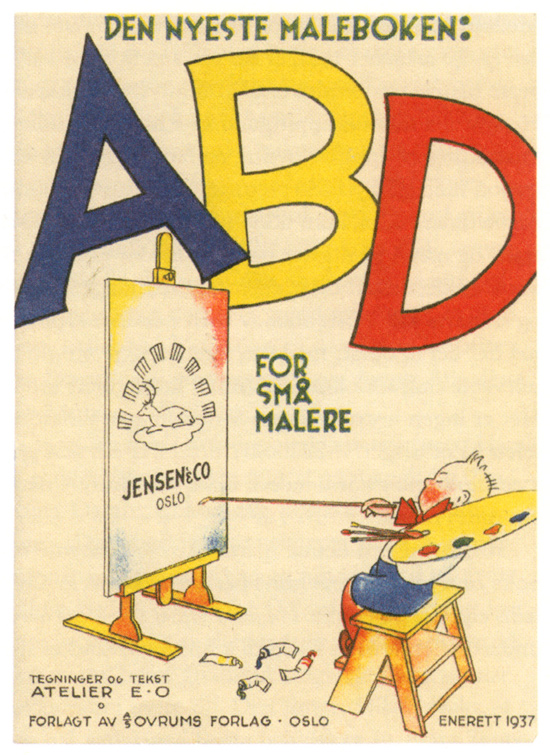 Eyvin Ovrum, 1937
Eyvin Ovrum, 1937 Eyvin Ovrum, 1938
Eyvin Ovrum, 1938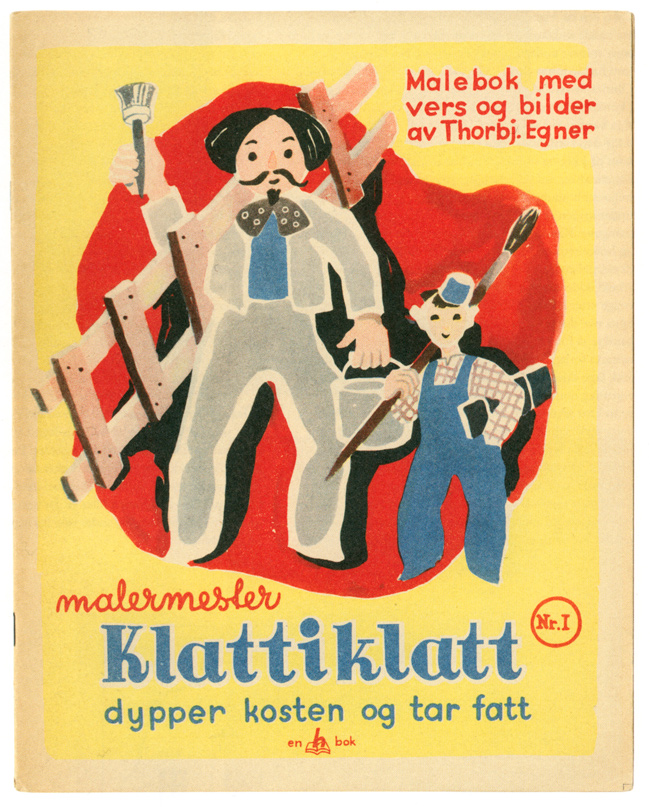 Thorbjørn Egner, 1940
Thorbjørn Egner, 1940
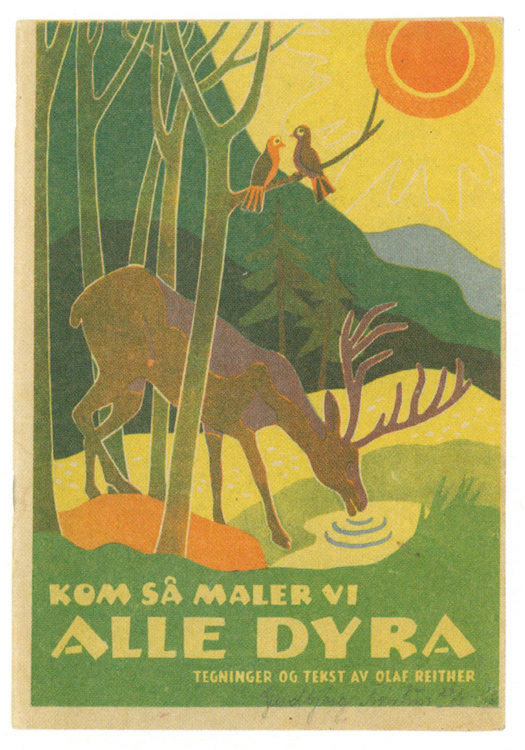 Olaf Reither, 1940s
Olaf Reither, 1940s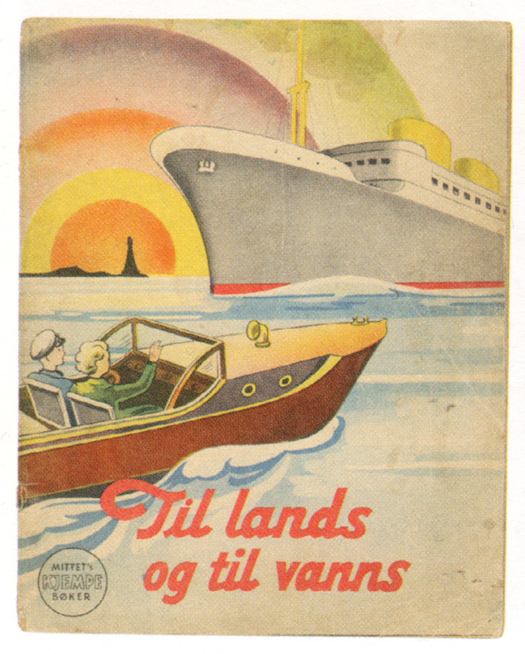 ?
?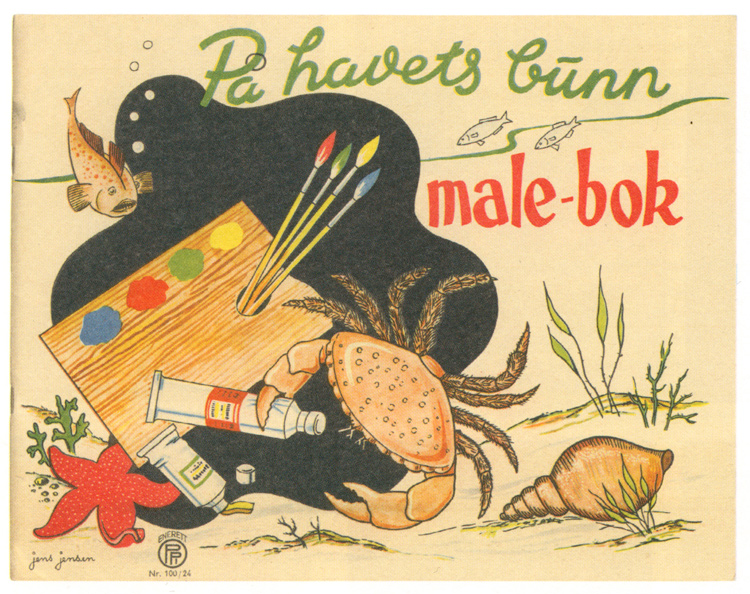 Jens Jensen
Jens Jensen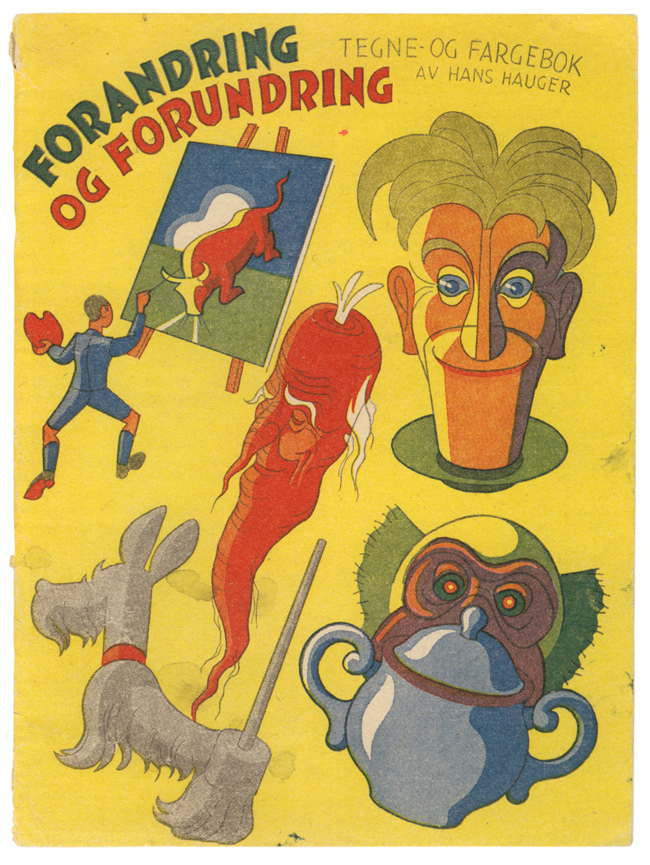 Hans Hauger, 1940s
Hans Hauger, 1940s ?
?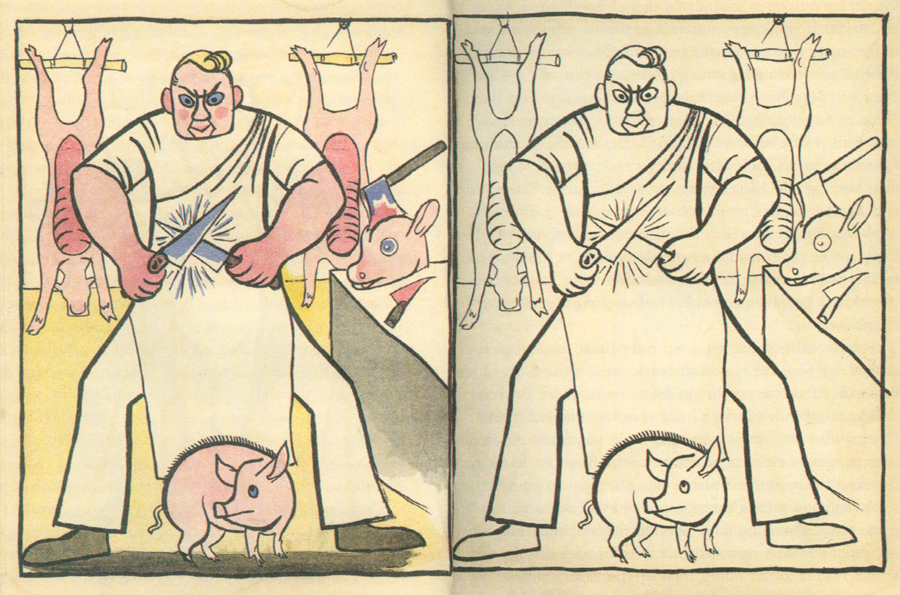 Per Krogh, 1921
Scariest coloring book ever?
Per Krogh, 1921
Scariest coloring book ever? cover of Norske Malebøker by Einar Økland
Are says about "Mr. Goatee": On the cover you see the Alf Bjercke paint company's character, a kind of artist type with a moustache and pointy beard, and always a sly smile. He looks similar to Alf Bjercke himself, and is interesting as this character became a kind of mould when describing an archetypical artist or painter in advertisements. Yet, it is hard not to see the resemblance to the archetypical jew of the Nazi propaganda of the same time, which makes it all very peculiar to me. Especially since one of our dearest children's book authors, Thorbjørn Egner, cast another painter character in a similar look, Maler Klattiklatt (Painter Splat-in-splat), who went to "Negroland" in a story released during the Nazi siege of Norway. In 1945, when Norway was liberated, the same character was suddenly cast in another very political story where he escaped the Nazis to join the Resistance in the woods, taught them to paint, and came back to the city after the war and helped repaint Norway in jolly colors to celebrate the freedom (!). Egner rarely mentioned these books after the last book, even though they sold very well. One reason was that he felt colouring books were a poor way for a child to learn to draw. But I can't help speculate whether there are other reasons as well.
Previously: Mokkelbost's Entity
cover of Norske Malebøker by Einar Økland
Are says about "Mr. Goatee": On the cover you see the Alf Bjercke paint company's character, a kind of artist type with a moustache and pointy beard, and always a sly smile. He looks similar to Alf Bjercke himself, and is interesting as this character became a kind of mould when describing an archetypical artist or painter in advertisements. Yet, it is hard not to see the resemblance to the archetypical jew of the Nazi propaganda of the same time, which makes it all very peculiar to me. Especially since one of our dearest children's book authors, Thorbjørn Egner, cast another painter character in a similar look, Maler Klattiklatt (Painter Splat-in-splat), who went to "Negroland" in a story released during the Nazi siege of Norway. In 1945, when Norway was liberated, the same character was suddenly cast in another very political story where he escaped the Nazis to join the Resistance in the woods, taught them to paint, and came back to the city after the war and helped repaint Norway in jolly colors to celebrate the freedom (!). Egner rarely mentioned these books after the last book, even though they sold very well. One reason was that he felt colouring books were a poor way for a child to learn to draw. But I can't help speculate whether there are other reasons as well.
Previously: Mokkelbost's Entity
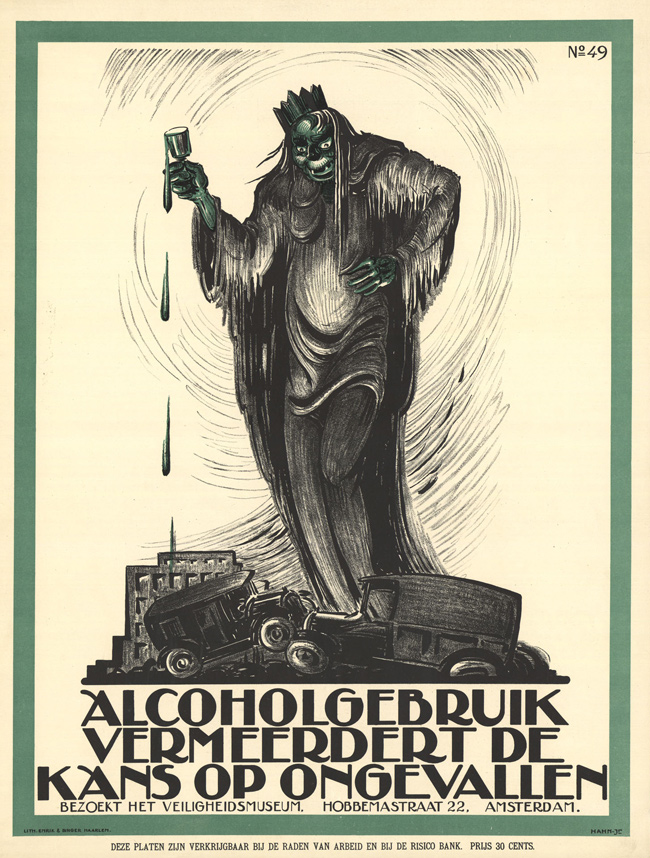 1926, poster by Albert Hahn
Alcohol increases the risk of accidents
This is a belated follow-up to my April 2013 post Vintage Safety. I tried really hard not to include too many "missing finger" posters. [update: I swear to you that I wrote that fate-tempting sentence on Monday and then totally hurt my hand moving boxes the next day at work. I may never again look at this post.]
"Hoogspanning!" means "high voltage!" (see poster below).
1926, poster by Albert Hahn
Alcohol increases the risk of accidents
This is a belated follow-up to my April 2013 post Vintage Safety. I tried really hard not to include too many "missing finger" posters. [update: I swear to you that I wrote that fate-tempting sentence on Monday and then totally hurt my hand moving boxes the next day at work. I may never again look at this post.]
"Hoogspanning!" means "high voltage!" (see poster below).
 1925, poster by Jacob Jansma
1925, poster by Jacob Jansma 1925, poster by Jacob Jansma
Don't spit on the nuns (Benjamin Peret probably loved this poster)
1925, poster by Jacob Jansma
Don't spit on the nuns (Benjamin Peret probably loved this poster) 1925, poster by Jacob Jansma
1925, poster by Jacob Jansma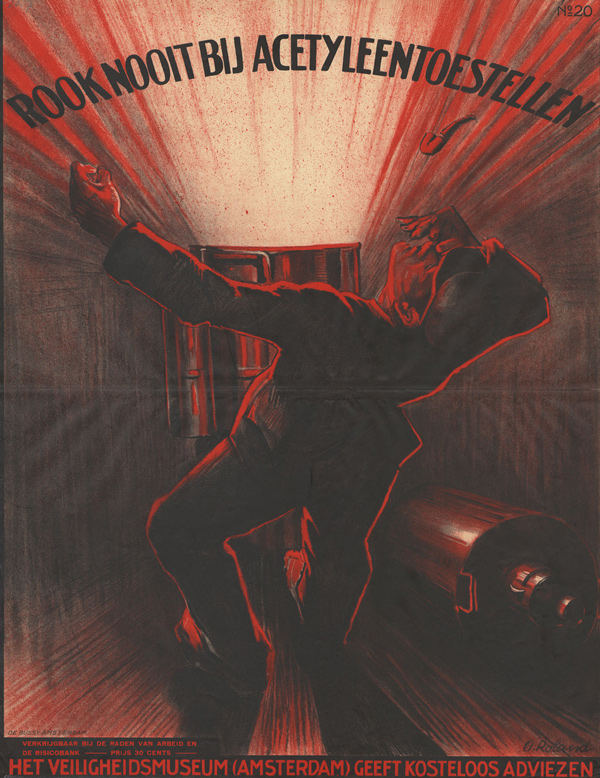 1925, poster by O. Roland
1925, poster by O. Roland 1928, poster by Herman Heyenbrock
1928, poster by Herman Heyenbrock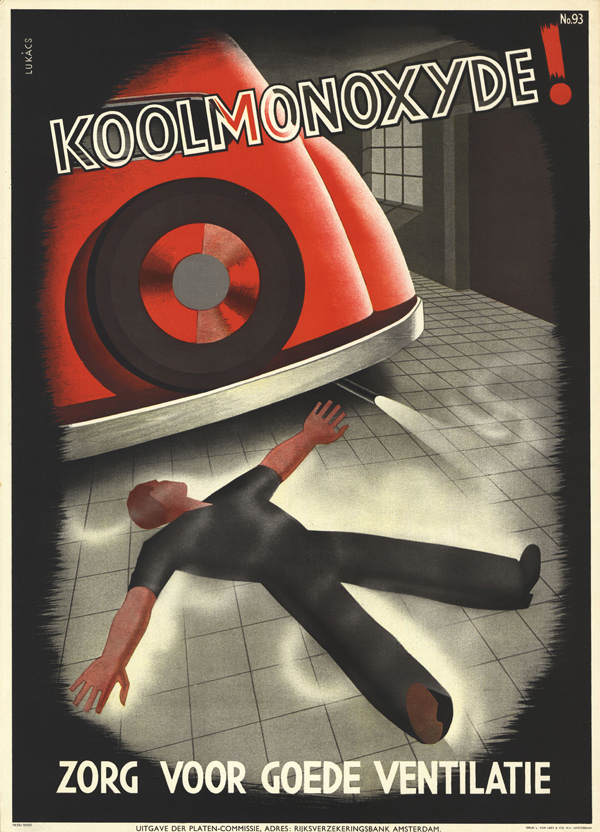 1939, poster by E. Lukàcs
1939, poster by E. Lukàcs
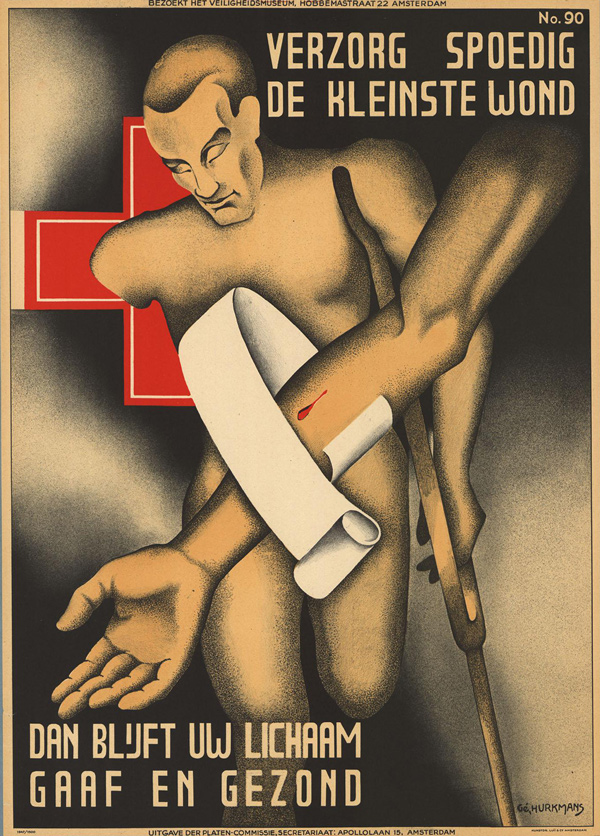 1939, poster by Gé Hurkmans
1939, poster by Gé Hurkmans
 1939, poster by Strelitskie
1939, poster by Strelitskie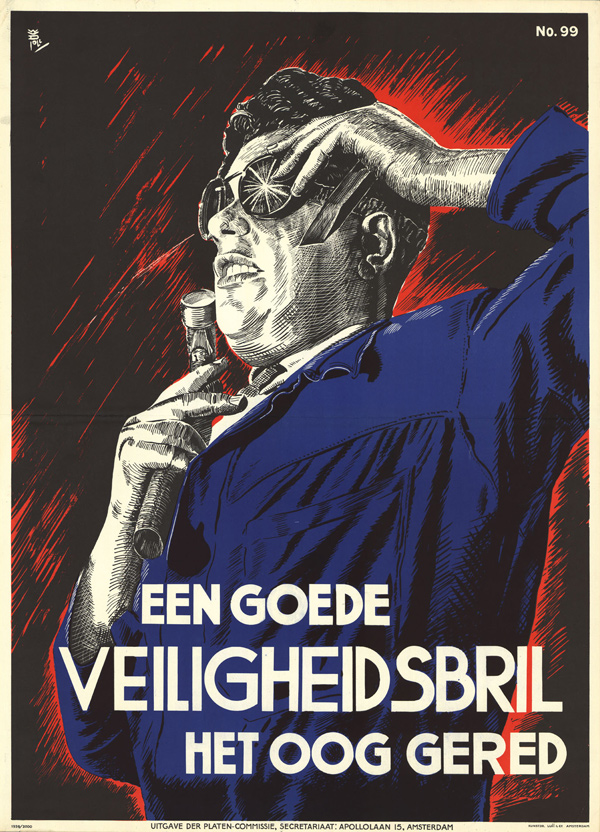 1939, poster by W. Poll
1939, poster by W. Poll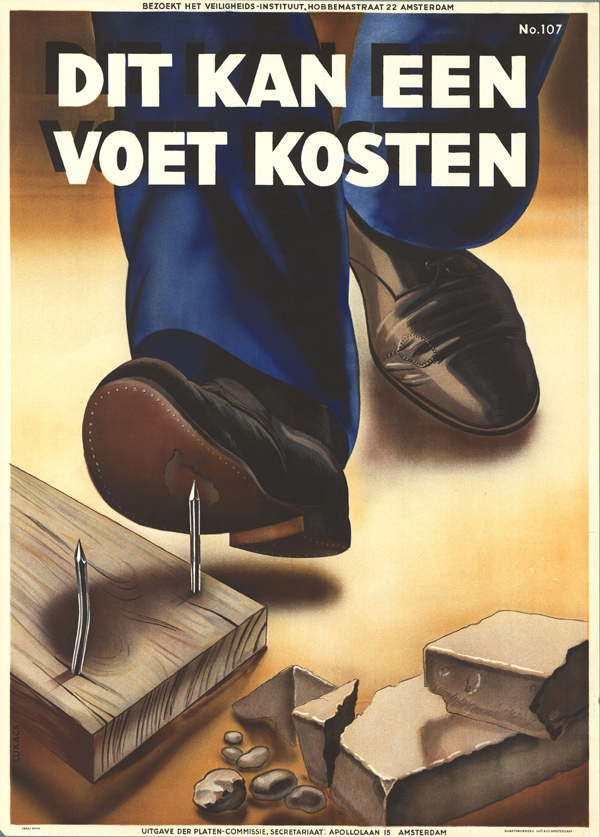 1940, poster by E. Lukàcs
1940, poster by E. Lukàcs
 1940, poster by Jacob Jansma
1940, poster by Jacob Jansma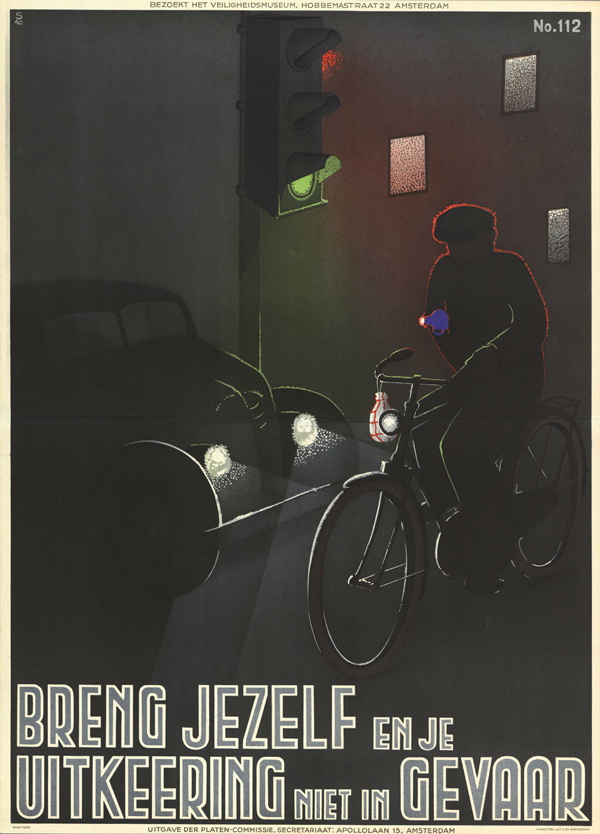 1940
1940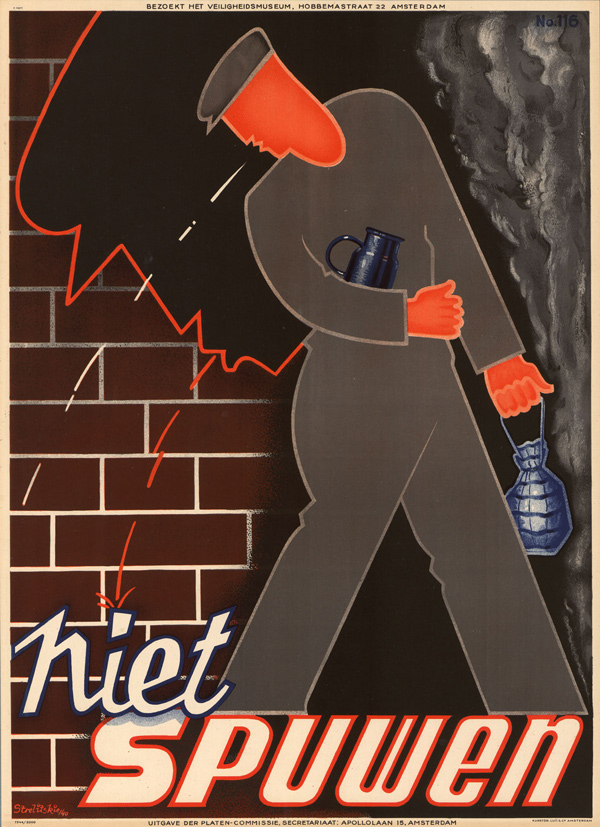 1941, poster by Strelitskie
1941, poster by Strelitskie 1944
1944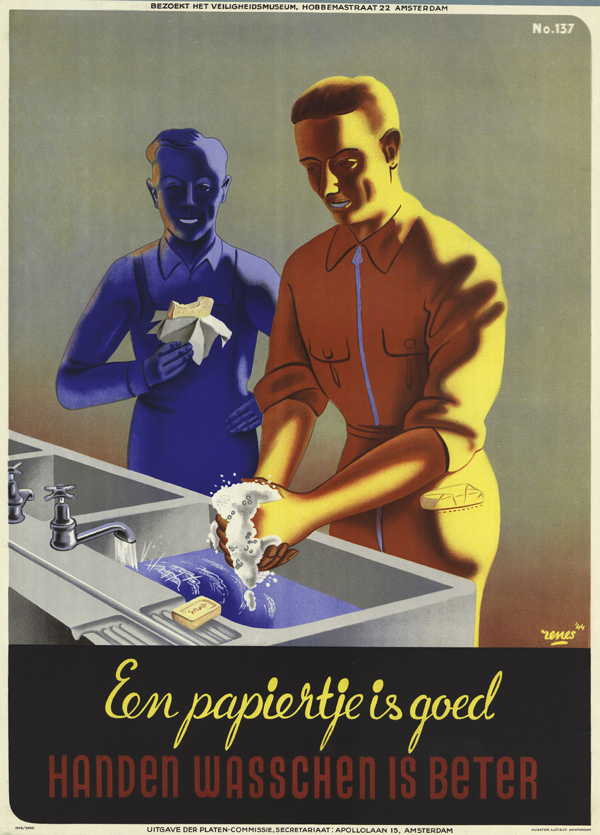 1945, poster by Renes / Jan Rot
Wash Your Fucking Hands
1945, poster by Renes / Jan Rot
Wash Your Fucking Hands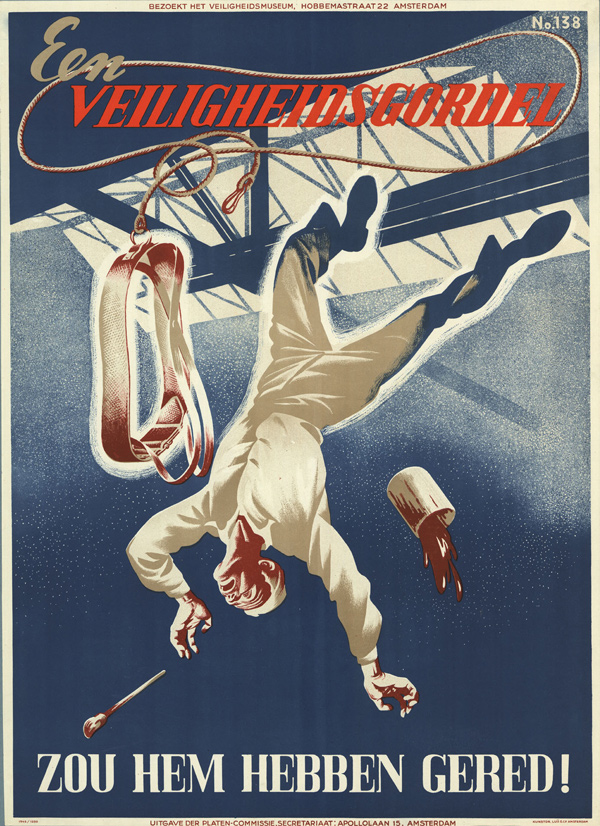 1945
1945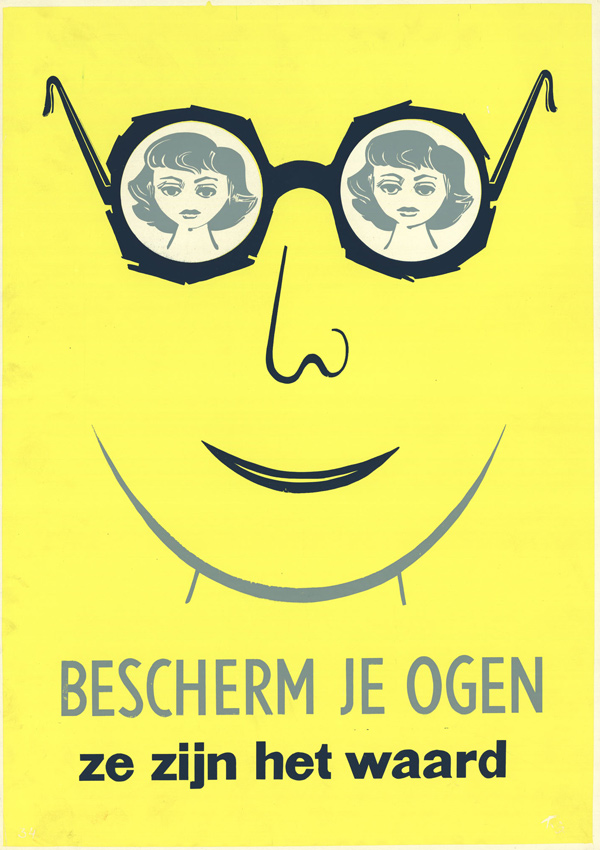 1950–1959
Protect Your Eyes
1950–1959
Protect Your Eyes
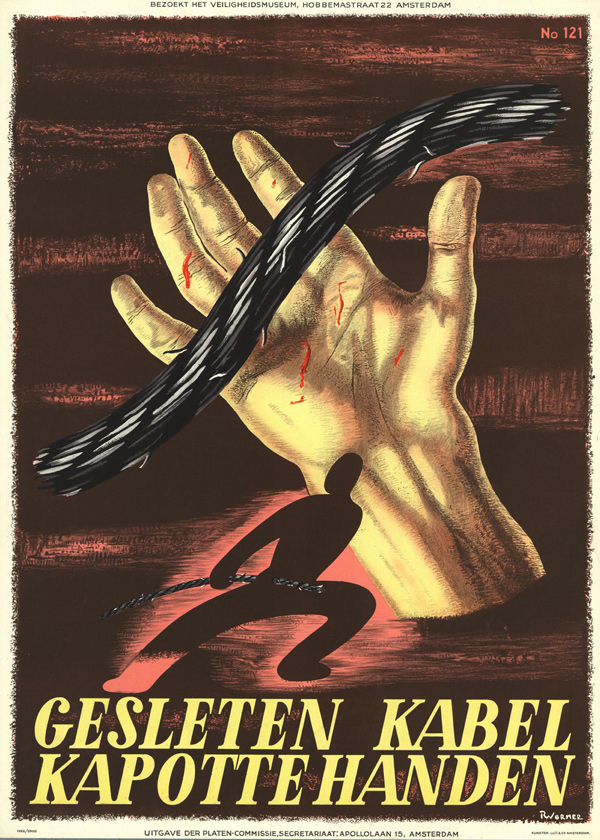 1952, poster by R. Wormer
1952, poster by R. Wormer 1955, poster by Jack de Rijk
1955, poster by Jack de Rijk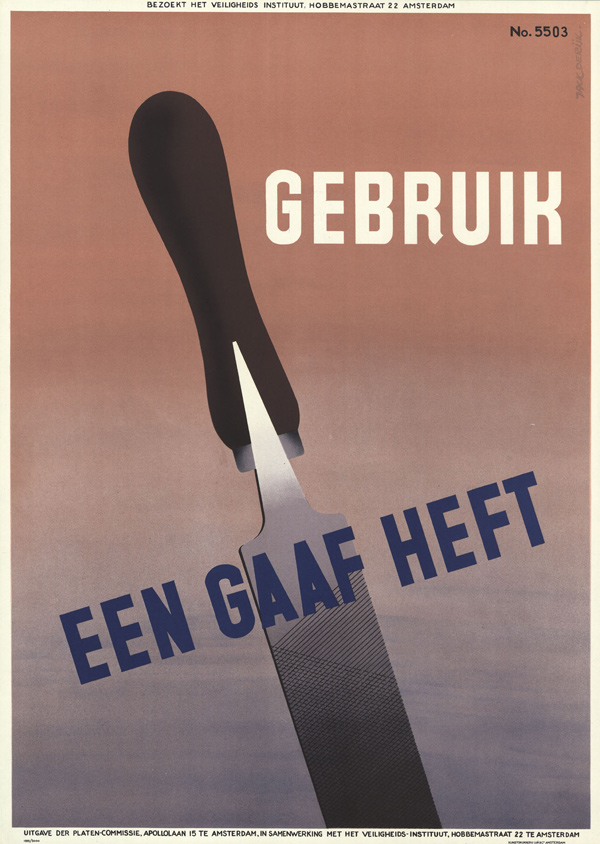 1955, poster by Jack de Rijk
1955, poster by Jack de Rijk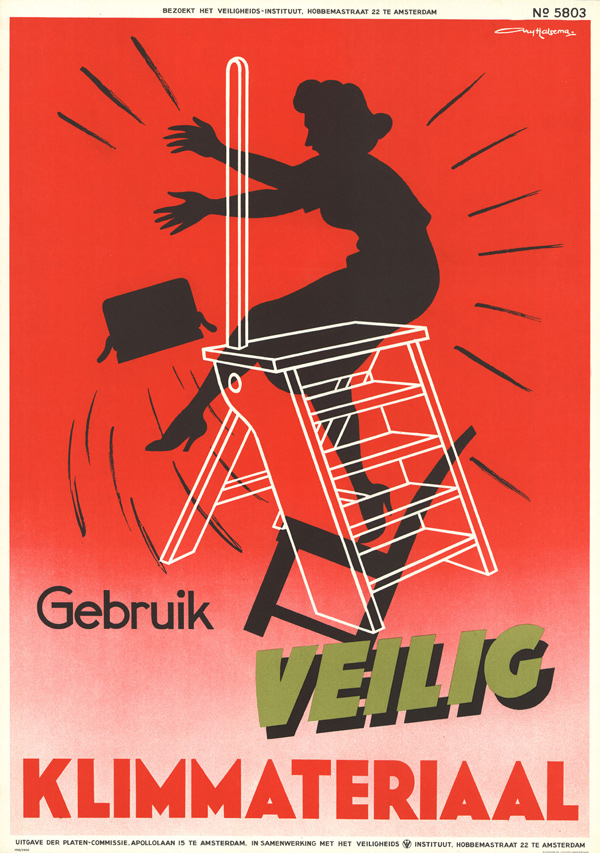 1958, poster by Ary Halsema
1958, poster by Ary Halsema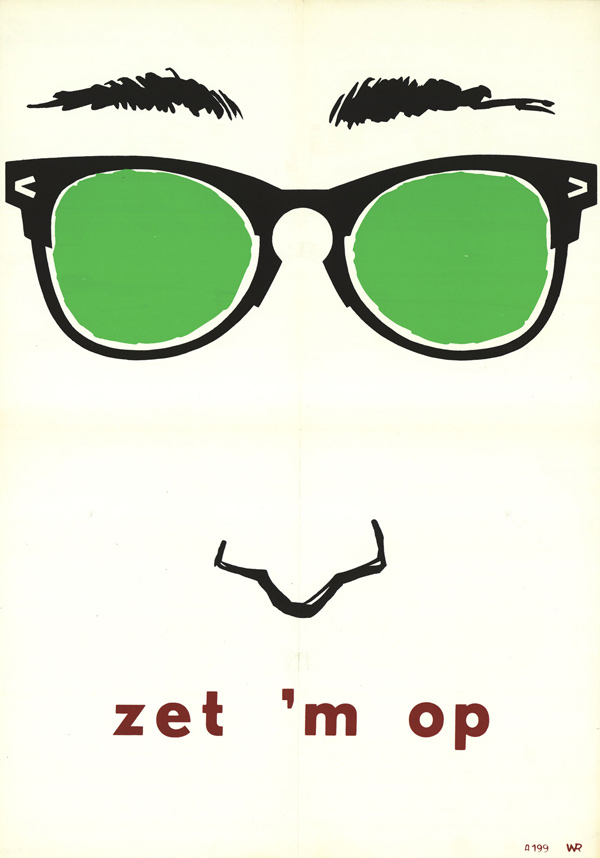 1959–1965
Put Them On
1959–1965
Put Them On
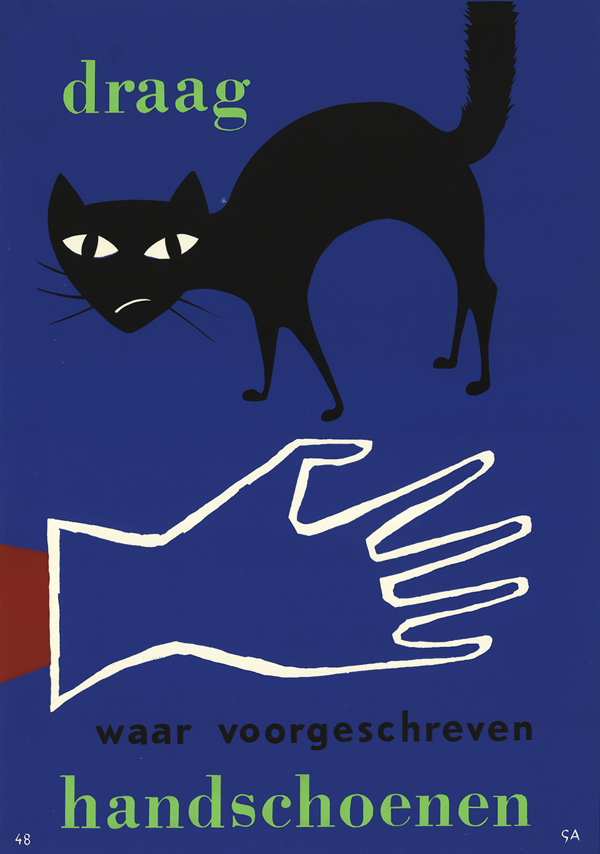 1959
1959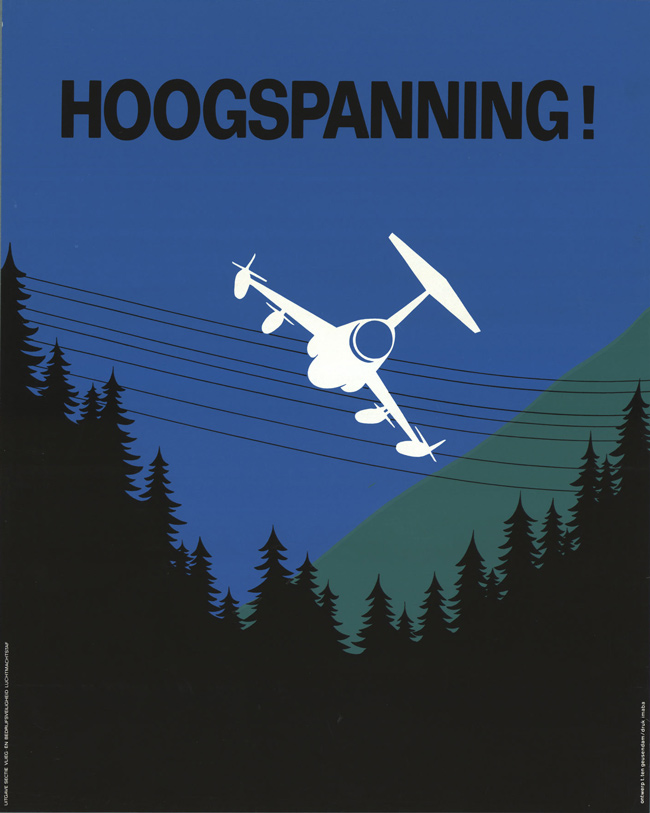 1960, T. ten Geusendam
"High voltage!"
1960, T. ten Geusendam
"High voltage!"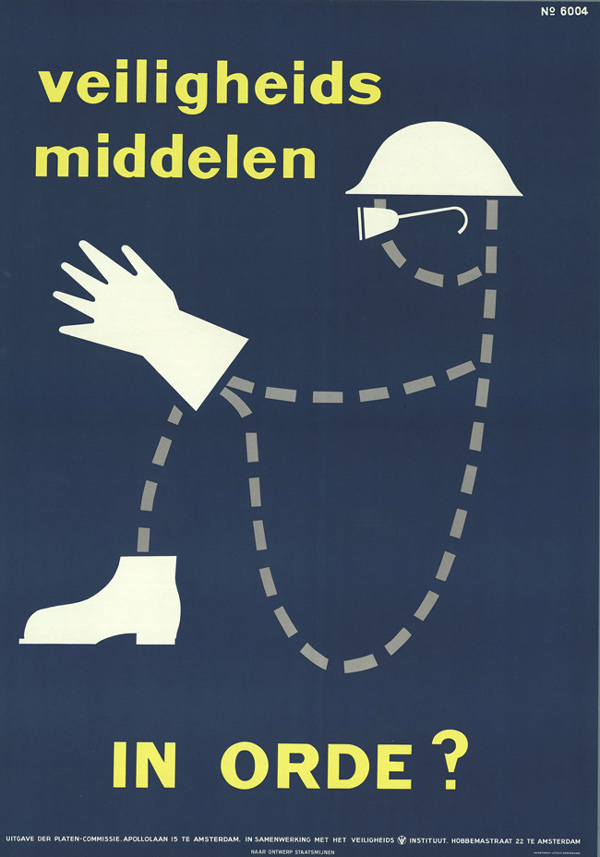 1960
1960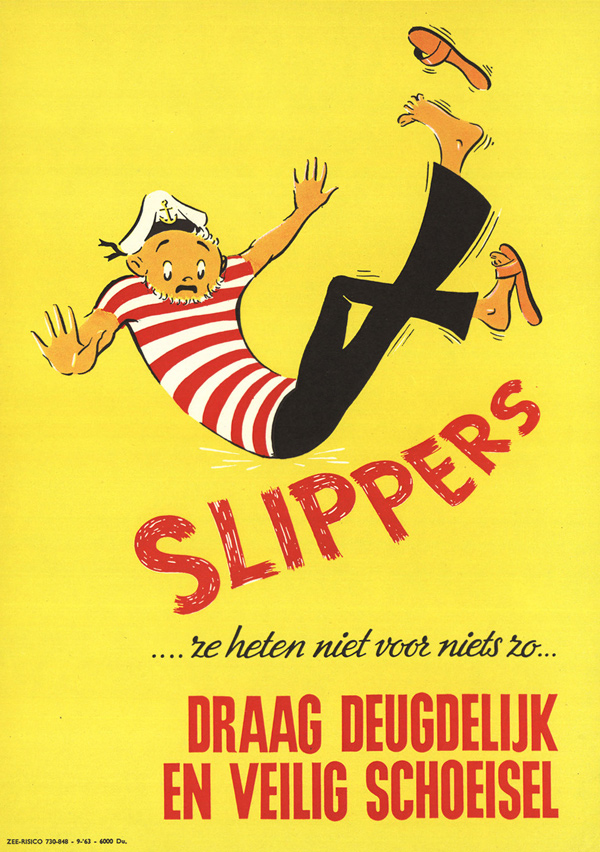 1963
1963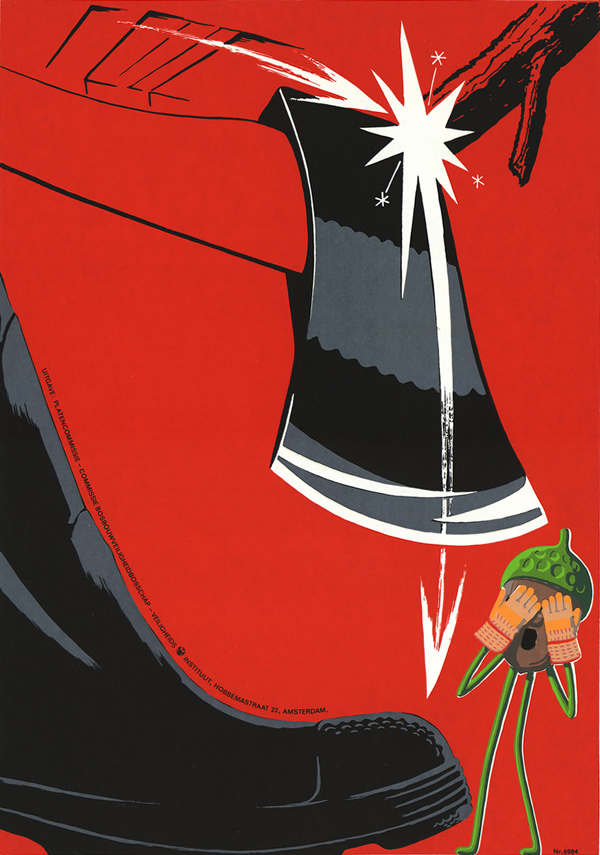 1969
1969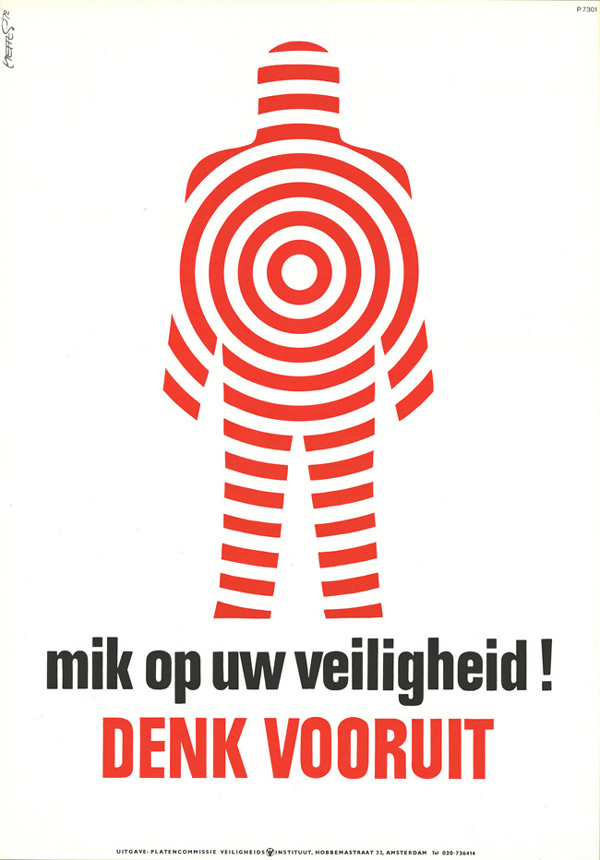 1973, poster by Frans Mettes
1973, poster by Frans Mettes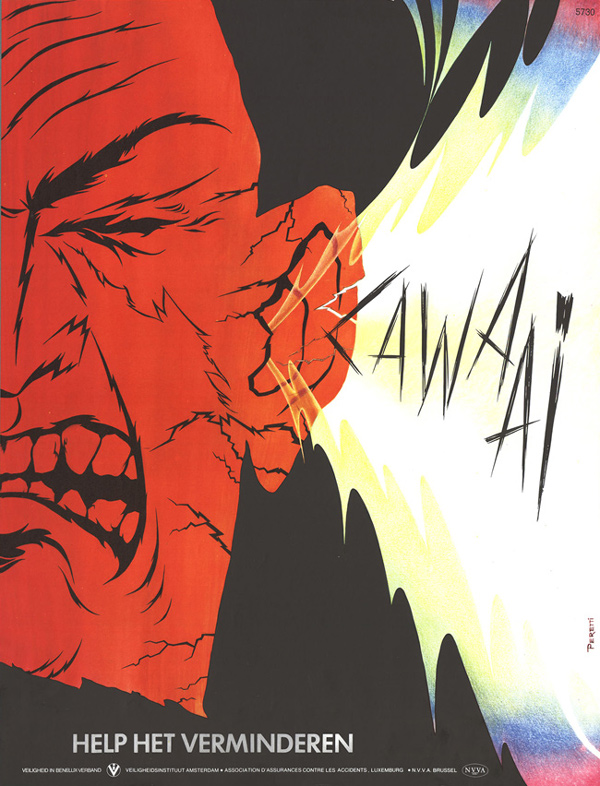 1975, poster by Peretti
Help Reduce Noise
This post first appeared on Feb. 19, 2014 on 50 Watts
1975, poster by Peretti
Help Reduce Noise
This post first appeared on Feb. 19, 2014 on 50 Watts